Prioritizing simplicity and composability, Solana stands out as a leading player in the integrated blockchain sector, distinguished by its parallel processing, low fees, and fast transaction speeds.
Despite facing challenges, Solana's ecosystem has been making a rapid recovery by deploying a variety of initiatives that align with its consistent vision, thus regaining its market share.
Solana is embracing several innovative applications based on its unique and developer-friendly infrastructure, especially pioneering in areas intended for retail adoption such as DePIN, Mobile, and Payment.
Additionally, various initiatives across the ecosystem for institutional adoption are becoming increasingly sophisticated. It is particularly impressive to see prominent institutions being onboarded to the Solana network through innovations such as the Payment SDK, SPE, and Token Extensions.
While Solana's vision is often compared to Apple's in terms of valuing the harmony between software and hardware and focusing on performance and UX, Solana places more emphasis on new software experiences than on convenience achieved through hardware, raising greater expectations.
*This report is an updated version of the mega report originally published in March 2024.
Historically, the infrastructure market, often seen as capital-intensive, has typically followed a winner-takes-all or few-dominate pattern. In line with this, even nearly nine years after Ethereum's launch as the first smart contract platform, one of the key focus areas in the blockchain space remains the market share battle between Virtual Machines (VMs). With ongoing debates about VM trends and differing infrastructure needs, it’s clear that a diverse range of VMs will continue to evolve, driving further growth in the blockchain market.
Represented by the Solana Virtual Machine (SVM), Solana is clearly making a meaningful impact in the market - while the blockchain space seemed headed toward an Ethereum-dominated modular ecosystem, Solana has played a pivotal role in highlighting the unique advantages of integrated blockchains—simplicity, affordability, and speed. Moreover, Solana is pioneering the onboarding process for off-chain users to adopt blockchain by focusing on sectors like DePIN (Decentralized Physical Infrastructure Network), Mobile, and Payment.
As the saying "Solana Is Not an Alt Anymore, OPOS (Only Possible on Solana)" gains popularity, this article will take a closer look at the narratives surrounding Solana, which is quickly reclaiming market share, and explore what has driven Solana's recovery, the unique qualities that set it apart, and the key lessons we can learn from its journey.
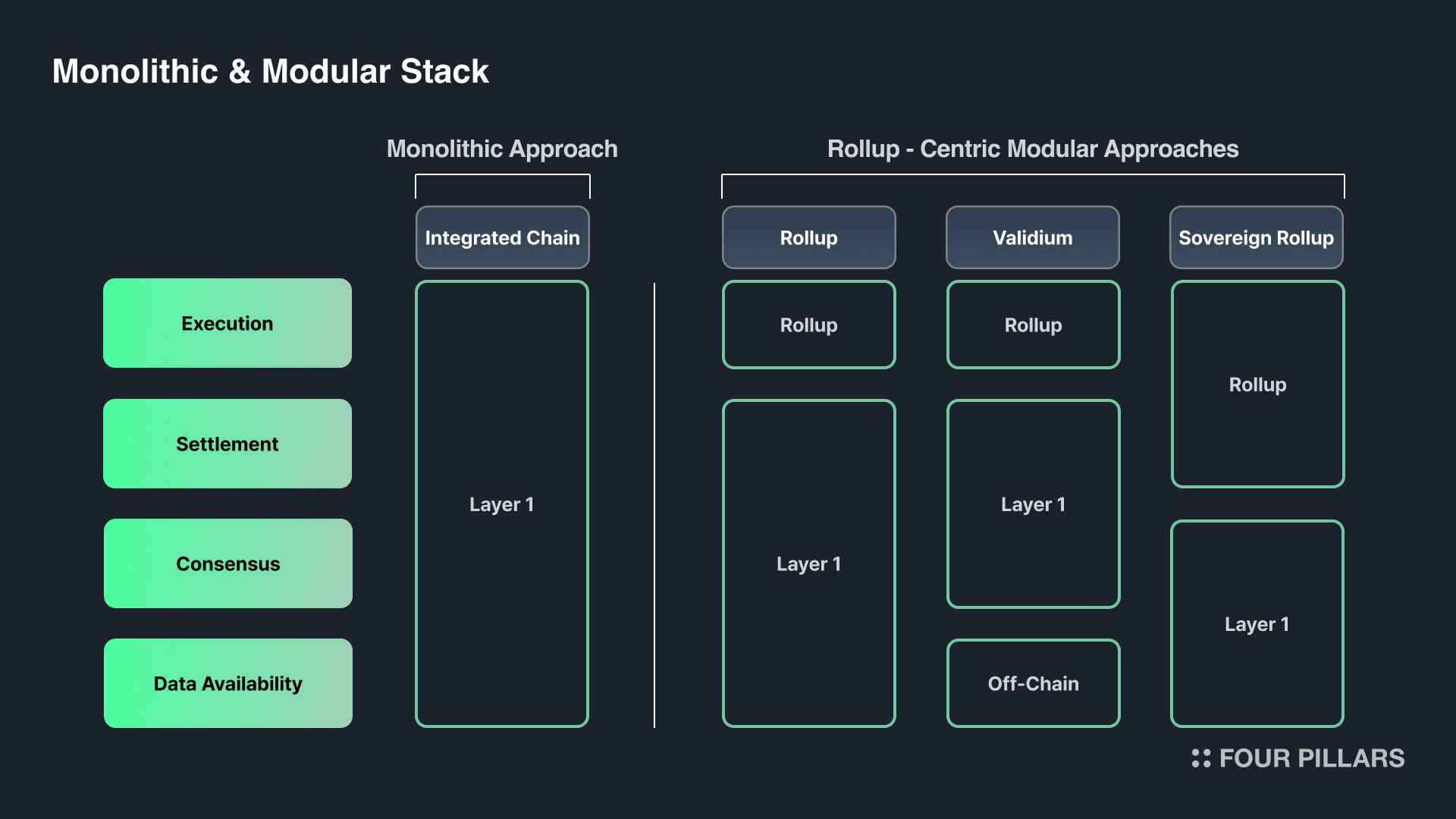
As Ethereum shifted its roadmap towards rollup-centric scaling, the concept of modular blockchains has rapidly gained traction, with related projects starting to dominate market share - the core idea of modular blockchains is to distribute the roles of consensus, execution, settlement, and data availability to different protocols, thereby overcoming the limitations of integrated blockchains through improved scalability and flexible governance.
However, the most critical drawback of this modular blockchain structure is its complexity. Considering the journey of a single transaction processed through various protocols, this complexity entails 1) constant checks for compatibility and dependencies, 2) increased communication costs, and 3) difficulties in swiftly identifying and resolving unpredicted issues. Who can confidently claim that such a system can be stable? For infrastructure to be stable and sustainable, it must be inherently simple.
Solana exemplifies leadership in this area, effectively spearheading the integrated blockchain space - to ensure a moderately decentralized network with fast transaction speeds, Solana has prioritized simplicity and composability, building its own unique tech stack. Since its launch, Solana has consistently developed its ecosystem by attracting a wide user base and fostering a vibrant community, distinguishing itself from the Ethereum ecosystem through its proprietary tech stack, which contrasts with the modular approach.
This showcases that the monolithic (integrated) approach, as seen in Solana, can be effective and meaningful in the industry. It has raised significant awareness about real-world use cases, challenging the predominantly idealistic and academic tone often emphasized in Ethereum-focused circles. This undoubtedly has influenced, and will continue to influence, the emergence of numerous other integrated blockchains today(e.g., Sui, Aptos, Monad, Sei, and others).
The simplicity and composability Solana advocates for aim not just at superficial performance improvements through expensive hardware but at designing a network that ensures efficient functions close to that of a single node by optimizing and simplifying software and communication technologies.
This is particularly significant in terms of creating a developer-friendly environment. First, from an integration perspective, developers can optimize their resources because all the complexity, such as deciding which stack to adopt for building applications, is removed, and they can be guaranteed interoperability between various smart contracts. Additionally, the characteristics of the localized fee market (where the fee market operates differently depending on each sector), derived from low latency, low fees, and parallel processing, eliminate communication inefficiencies caused by potential bottlenecks from a single application.
Furthermore, Solana offers a range of built-in features within its simple technical stack, such as configurable token standard libraries, cross-chain interoperability, and RPCs for token balance queries without relying on external indexers, fostering organic interactions between applications.
In addition to them, Solana offers a variety of programs that provide full support to developers, whether technical, financial, or operational. In short, Solana is creating the ideal environment for product-minded developers, enabling the ecosystem to grow robustly in line with Solana's core values.
Blockchain is undoubtedly an inconvenient technology. Yet, the reason so many people are drawn to it and choose to build within this ecosystem is that it has potential to offer a unique value to the real world, significant enough to outweigh its inconveniences. However, this value becomes meaningless if it is not widely adopted. Solana understands this better than any other mainnet - it has developed with a focus on practicality, rather than getting overly caught up in the ideals that blockchain originally sought to achieve (e.g., decentralization). The vision for the Solana ecosystem is centered on "Real Adoption.”
Solana is currently focusing on three main areas: DePIN, Mobile, and Payment. What these sectors have in common is that they are closely tied to real-world infrastructure. DePIN leverages blockchain technology to create decentralized networks that maintain and operate physical infrastructure, with narratives forming rapidly around Solana. This is because Solana’s low fees and fast processing speeds make it highly suited to capital-intensive industries like hardware-based computing, storage, telecommunications, mapping, data centers, etc. The development of DePIN and Payment will significantly contribute to forming real-world infrastructure using Web3 features, and at the same time, serve as a major onboarding method for off-chain users to bring their activities and assets into Solana's on-chain environment. The off-chain users transitioning to Solana ecosystem can naturally accumulate on-chain experience by leveraging various on-chain asset classes(e.g., RWAs), through devices like Saga(or Seeker) mobile and consumer applications.
In summary, the Solana ecosystem not only blurs the boundaries between off-chain and on-chain, but also to transform each into a more meaningful space on its own.
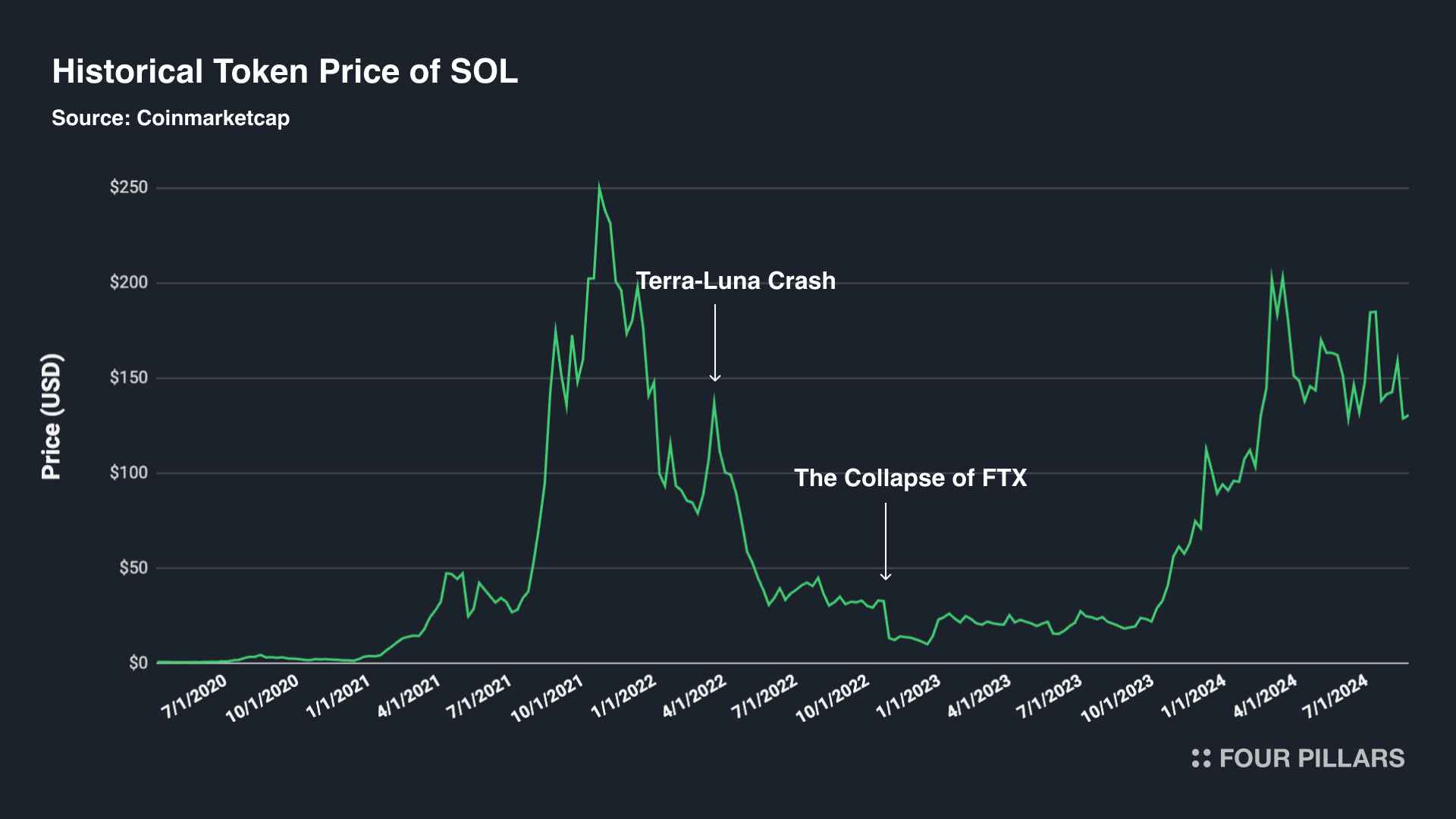
The crypto industry has seen rapid growth in a relatively short period, attracting significant attention. The volatility experienced during this growth has become a familiar phenomenon among industry players. However, the level of volatility Solana faced was exceptional in particular - especially during the peak of the blockchain frenzy in 2021-2022, Solana rapidly grew to become the fourth-largest ecosystem by market capitalization, excluding stablecoins, with the backing of FTX, the world’s second-largest crypto exchange, and its founder, Sam Bankman-Fried(SBF). However, the collapse of FTX dealt a significant blow to the Solana ecosystem, causing the price of SOL tokens to fall by 97% from their peak.
Despite such a severe crisis, Solana is regaining its influence. With active participation from developers and companies, the ecosystem has become much stronger than before. This series of drama was made possible due to Solana's unwavering vision and fast execution for that.
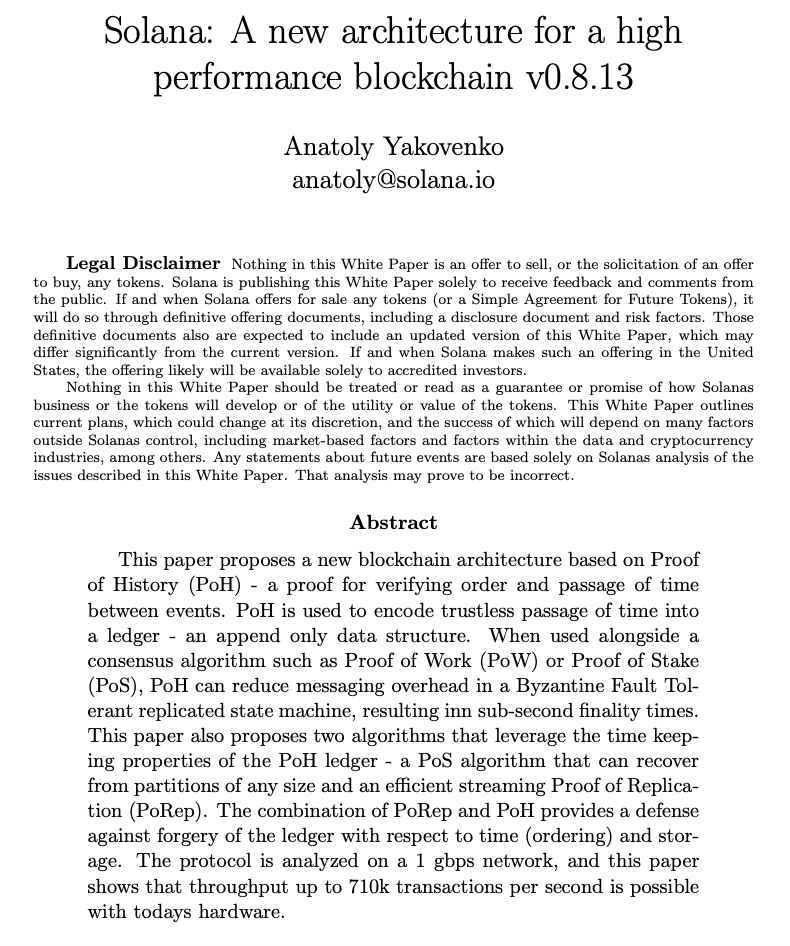
Source: Solana Whitepaper
“Single Shard Global Synchronized State Machine with Consensus at the Speed of Light”
The origins of Solana date back to late 2017. Drawing from his experience at Qualcomm, Anatoly Yakovenko began studying blockchain technology and identified a significant issue: the scalability limitations of existing solutions were largely due to the absence of a trustless, universal clock that all validators could use for transaction timestamps.
As such, Anatoly proposed a new method to encode the passage of time using SHA-256 looping and synchronize clocks across multiple nodes through this data structure. Unlike other existing blockchains, which require extensive communication between nodes to reach consensus on the timing of transactions, order them, and finalize them, his idea suggested that if each validator has access to an independently verifiable global clock, network synchronization can be simplified. As a result, transactions can be processed almost immediately as they arrive.
This idea materialized as Proof of History (PoH), aligning with Solana's hypothesis that if software does not hinder hardware, the entire network performance can linearly increase with hardware advancements. Today, Solana is capable of processing thousands of transactions per second, with block times recorded at 400-500ms—significantly higher performance than existing blockchains.
Ultimately, Solana's adoption of this technical approach aims to achieve two missions: a scalable platform that can handle high usage and composability between applications. Through an integrated blockchain design that shares a single globally synchronized state, developers can write programs(i.e., smart contracts) more easily, reducing the complexity of application development and allowing them to fully focus on improving the end-user experience.
Solana's development philosophy, use of multi-threading for parallel processing, and consistently proven excellent network performance played a crucial role in forming a community centered around pragmatic developers. Furthermore, the peak of the blockchain narrative atmosphere at the time, along with the demand for fast transactions and low fees spurred by the DeFi and NFT boom, positioned Solana as a genuine competitor to Ethereum.
However, the collapse of FTX caused a temporary disruption to this scenario. At the time, Solana was closely tied to Sam Bankman-Fried (SBF), who had publicly supported the Solana ecosystem by onboarding several projects, starting with the DEX project Serum. Under SBF’s backing, FTX grew to become the second-largest centralized exchange in the world, and consequently, his influence within Solana also increased. However, FTX eventually fell due to inappropriate financial management and accounting practices, including the misuse of company assets and customer deposits for loans and investments in its hedge fund, Alameda Research. As a result, the Solana ecosystem, which had heavily relied on FTX, also suffered and faced the risk of collapse.
Though Solana's ecosystem seemed to crumble, builders who resonated with Solana's philosophy remained. The first action Solana took in this situation was to enhance the network's stability and developer-friendly environment by addressing technical aspects, thus restoring trust from the community.
3.2.1 Technical Side

Indeed, the Solana network had been plagued by a chronic issue of frequent outages due to its vulnerability to spamming. The root cause of this problem primarily stems from its design, which aims to maximize network communication speed through a low fixed fee structure and a system where leader nodes are predetermined. To address these issues, Solana has implemented several improvements, including the introduction of QUIC (Quick UDP Internet Connections), Stake-Weighted QoS (Quality of Service), and a Localized Fee Market.
QUIC
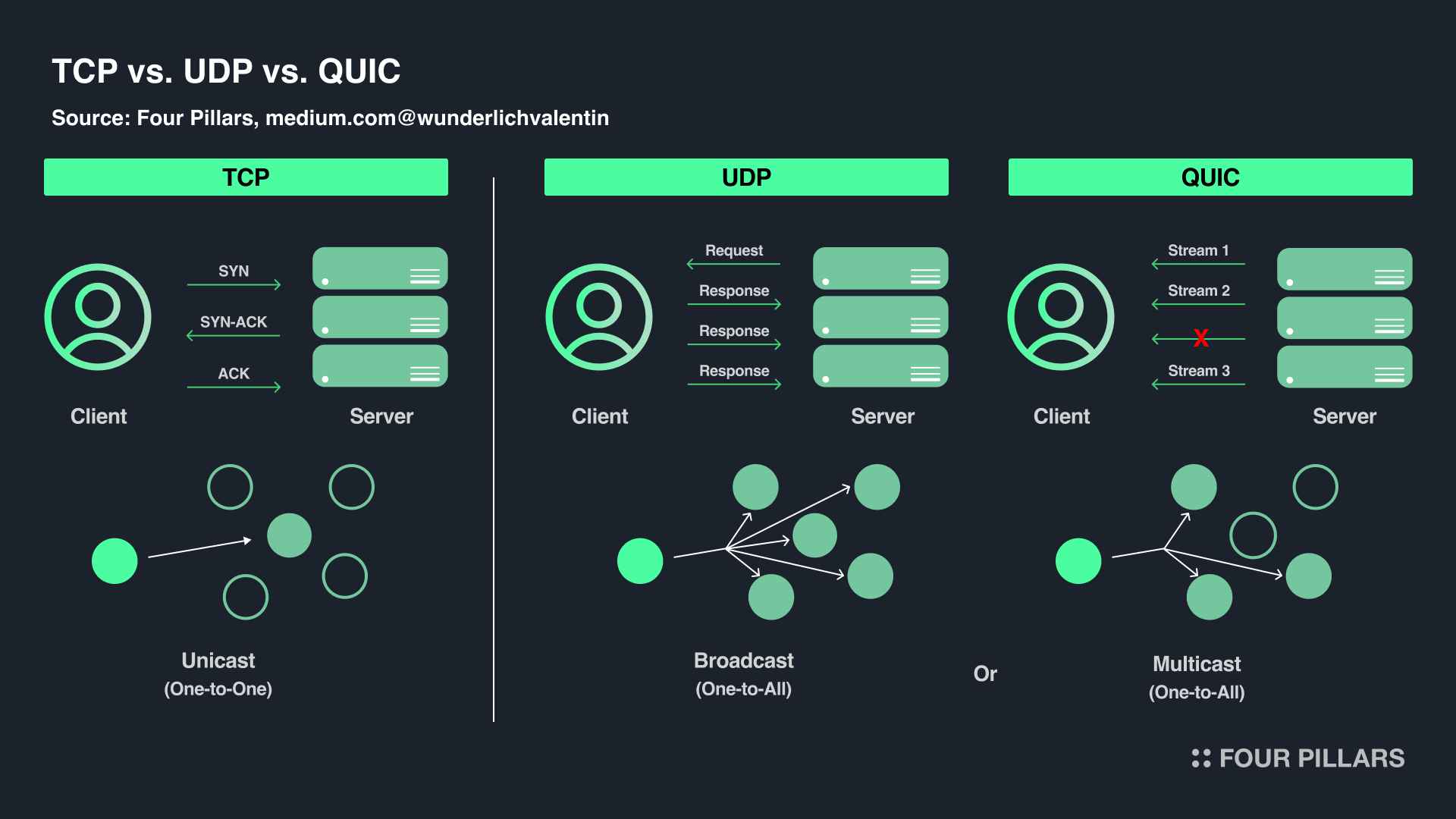
Solana network used a custom UDP protocol for communication between RPC and leader nodes. This approach simplifies the communication process and can accelerate transmission speed, but it lacks reliability, as there is no way to verify whether the packet was successfully transmitted (i.e., Acknowledgement), making it impossible to identify the source IP, and has insufficient control mechanisms over the network, making it vulnerable to spamming. In other words, while these characteristics of UDP may be suitable for services where continuity is critical, such as real-time streaming, they have been criticized as unsuitable for blockchain environments, where security and stability are essential.
To overcome these problems, Solana decided to adopt the QUIC protocol developed by Google. QUIC is a new communication protocol based on UDP, maintaining its advantages while simplifying TCP's connection streams and handshake processes. With the adoption of the QUIC protocol, Solana has enabled highly reliable communication, where it significantly improved network efficiency by only requesting retransmissions for streams with packet loss, while continuing to transmit other streams without interruption.
Stake-Weighted QoS
QoS prioritizes certain types of traffic when more traffic is requested than the network can handle. With the introduction of QUIC, discussions on its use emerged—Solana's leader nodes, previously using UDP, processed transactions based on their arrival without considering their origin. However, with QUIC, Solana’s leader nodes can now identify the IP requesting the transaction, allowing them to specify and limit the traffic priority for certain connections.
The core of the Stake-Weighted QoS policy is to set the traffic limit level in proportion to the amount of staked SOL. In other words, the maximum number of packets that validator nodes can transmit is proportional to the amount of SOL tokens they have staked on the Solana network. Transactions that exceed the limit set for each validator node are more likely to be dropped by the leader. The expected effects of this approach are: 1) preventing malicious validator nodes from conducting spamming attacks, and 2) encouraging validators with high demand for transaction processing to stake more SOL tokens, thereby enhancing the security of the Solana network and increasing demand for SOL tokens.
Localized Fee Market
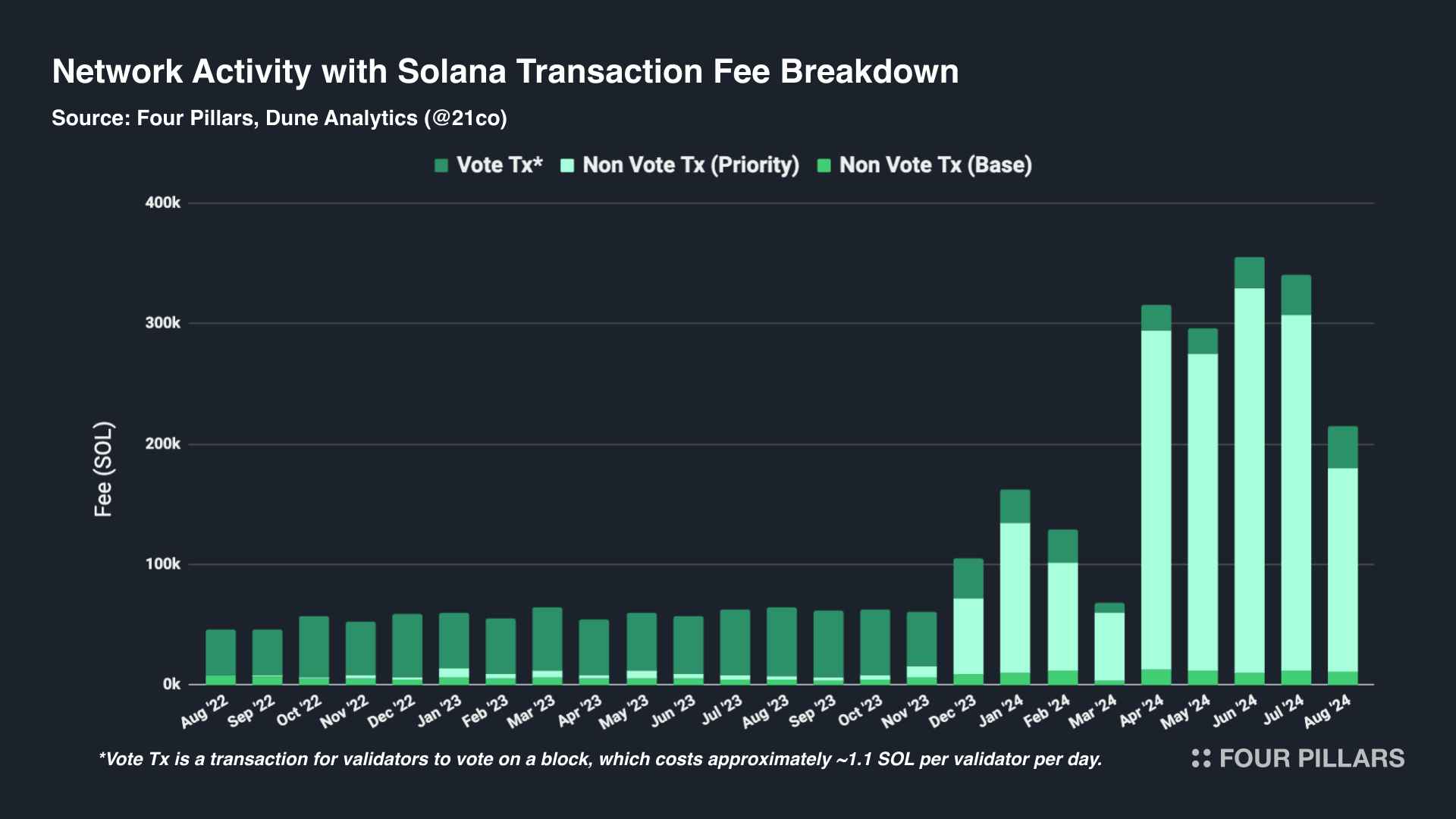
While Solana applied a fixed gas fee policy, maintaining a constant affordable fee advantage, intense block space competition could lead to transaction failures or induce network spamming by users trying to ensure their transactions succeed. To solve this, discussions on introducing a fee market system in the Solana ecosystem began. This system allows users to add a premium to their fees to ensure their transactions are processed quickly, thereby deterring spam activities and enhancing network efficiency.
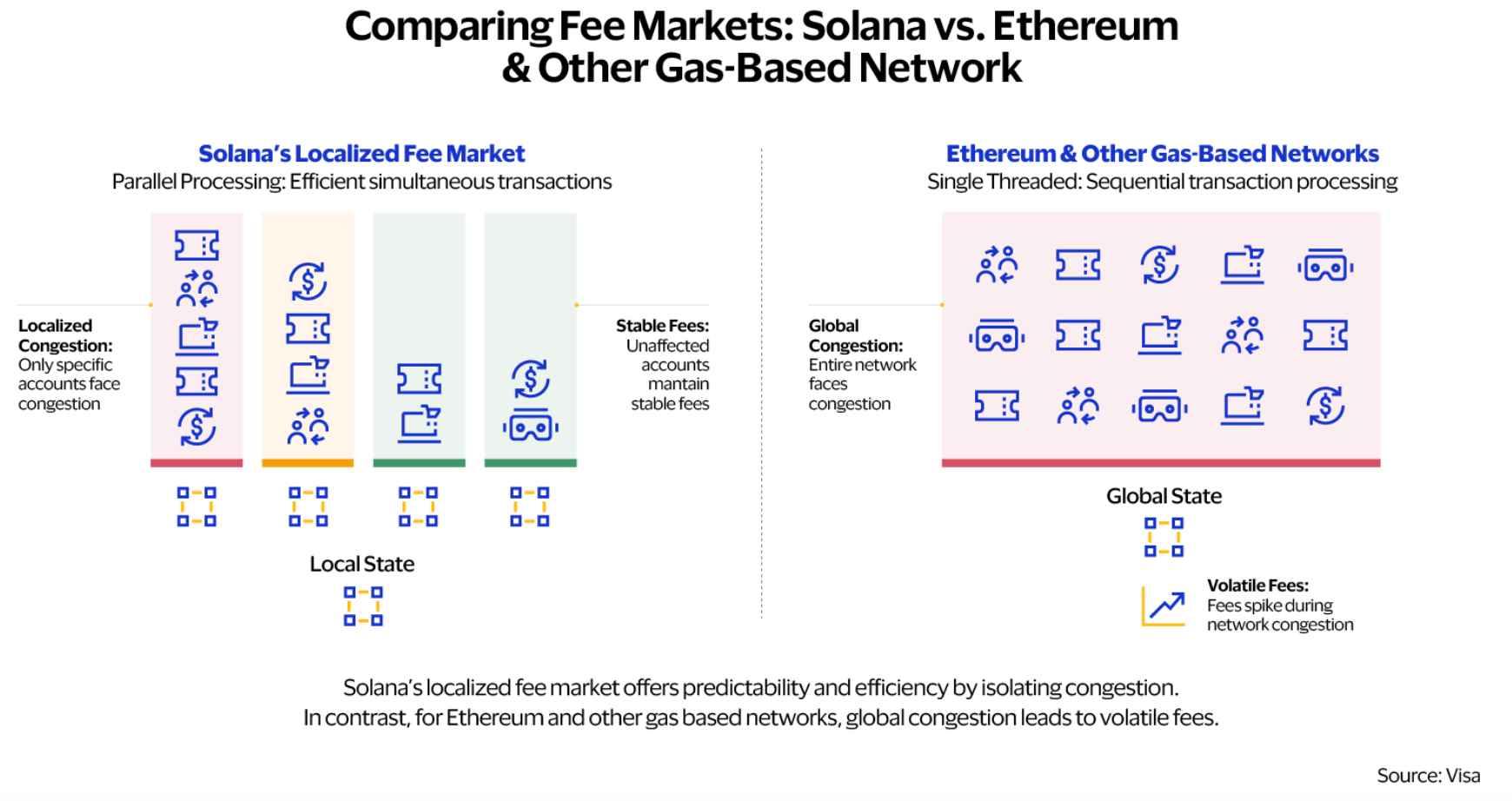
Source: Visa
Taking it a step further, Solana adopted a localized fee market approach, limiting it to specific applications or markets to minimize the overall network impact when demand for certain actions increases block space competition - this logic is possible because each Solana transaction specifies the state parts to be modified for a particular account in advance, and transactions can be processed in parallel. For example, even if the gas fee for minting a specific NFT skyrockets due to high demand, it doesn't affect the fee market for other accounts unrelated to minting, such as token transfers. Currently, the accounts where the localized fee market is applied are limited to specific applications, markets, and AMM pools, among others. The maximum number of Compute Units (CUs) that an individual program account can use per block is restricted to 25% of the total maximum CUs per block (i.e., 12 million CUs)*.
*For reference, the maximum compute units per single transaction is 1.4 million CUs.
Even since the introduction of the localized fee market concept, discussions continue around refining the fee structure of the Solana network. As of the time of writing, the current fee policy is as follows.
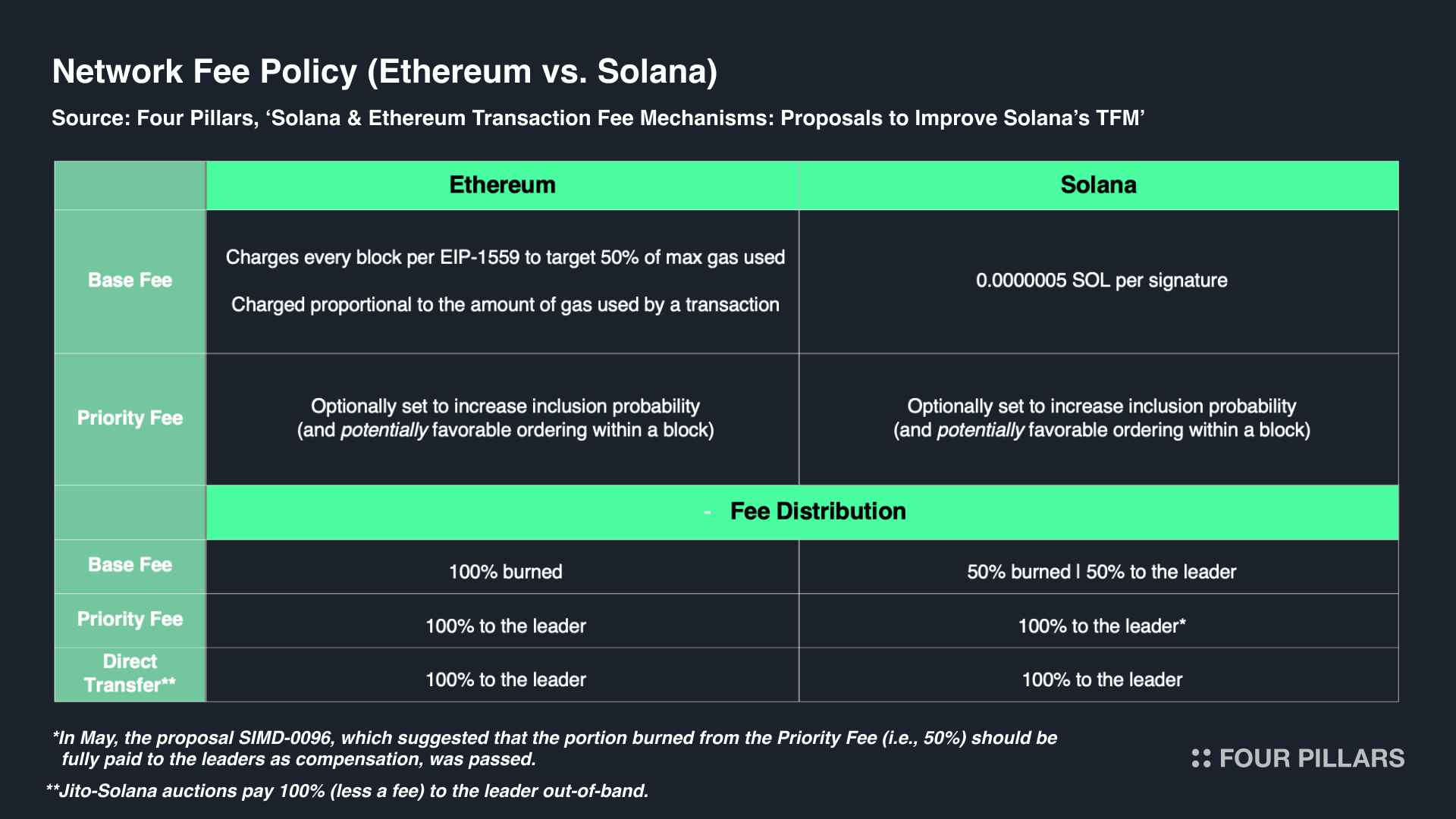
3.2.2 Ecosystem & Operation Side
Beyond those technical efforts, Solana's ability to draw interest from the market and regain trust is attributed to actively approaching areas where its technology stack can be well leveraged, and fostering a developer-centric community.
Strengthening Community Sentiment
The Solana community, through various platforms such as the foundation, hackathons, and Superteam Earn, actively have provided the necessary resources and support for developers passionate about contributing to the ecosystem. It has been operated on the principle that ‘benefiting developers is crucial for sustainable ecosystem development’.
As part of this, a meme coin called BONK, created by the LamportDAO community, airdropped 5 percent of its total allocation for developers remaining in the Solana ecosystem wishing for the reconstruction of the Solana ecosystem. This meme token helped unify the community, and as developers rebuilt the ecosystem, the meme token gained traction, marking a record price increase of 15,680% above its lowest price at a certain point. The rise in BONK token's price induced a virtuous cycle of rejuvenating interest in Solana and its ecosystem, eventually leading to a proposal for a 30 million BONK token airdrop to Saga mobile device users, heightening market interest in BONK and the Solana ecosystem further.
Recursively, protocols such as Jito (MEV solution client & staking platform), Pyth Network (oracle network), and Jupiter (DEX) also announced strategies for airdrops, stimulating market interest in Solana. Other protocols within the ecosystem, including Tensor, marginfi, Zeta, Parcl, announced point policies, contributing to the vitality by gathering expectations for airdrops among participants in the Solana ecosystem.
These cases are significant examples of how a culture respecting the community combined with superior product design can breathe new life into an ecosystem.
Approaches for Web2 Infra
As the fervor for blockchain during its peak in 2021-22 began to wane, a major question left by the market was, "Why blockchain?" Consequently, each mainnet started to solidify its own identity and discuss strategies for "real adoption” more actively. At this point, another factor that drew significant attention to Solana from the market was its ability to quickly implement and pioneer various initiatives that go beyond simply addressing these concerns, by actually bridging real-world infrastructure with on-chain solutions.

Source: solanamobile.com
Prominent among these initiatives are DePIN and Mobile. As explained in the introduction, DePIN utilizes blockchain technology's decentralization characteristic to maintain and operate real infrastructures, and Solana is uniquely pioneering the DePIN area, creating its narrative. This aims not only to present use cases that can replace/complement real-world infrastructure with the Web3 grammar but also to construct a funnel that draws off-chain users into the world of Web3, allowing them to pipeline Web3 experiences. The physical environment equipped with an app store and various features to offer an aggregated experience of the Solana ecosystem to these users is the Saga series of mobile devices launched by Solana - the first Saga series released in 2022 saw initial low sales but sold out by December as BONK token news and the vitality of the Solana ecosystem spread, and pre-orders for “Seeker*”, the second series, launching in the first half of 2025 surpassed 140,000 as of September 19th.
*Solana Mobile introduced the second product in the Saga series, called "Seeker," at the TOKEN 2049 event on September 19, 2024.
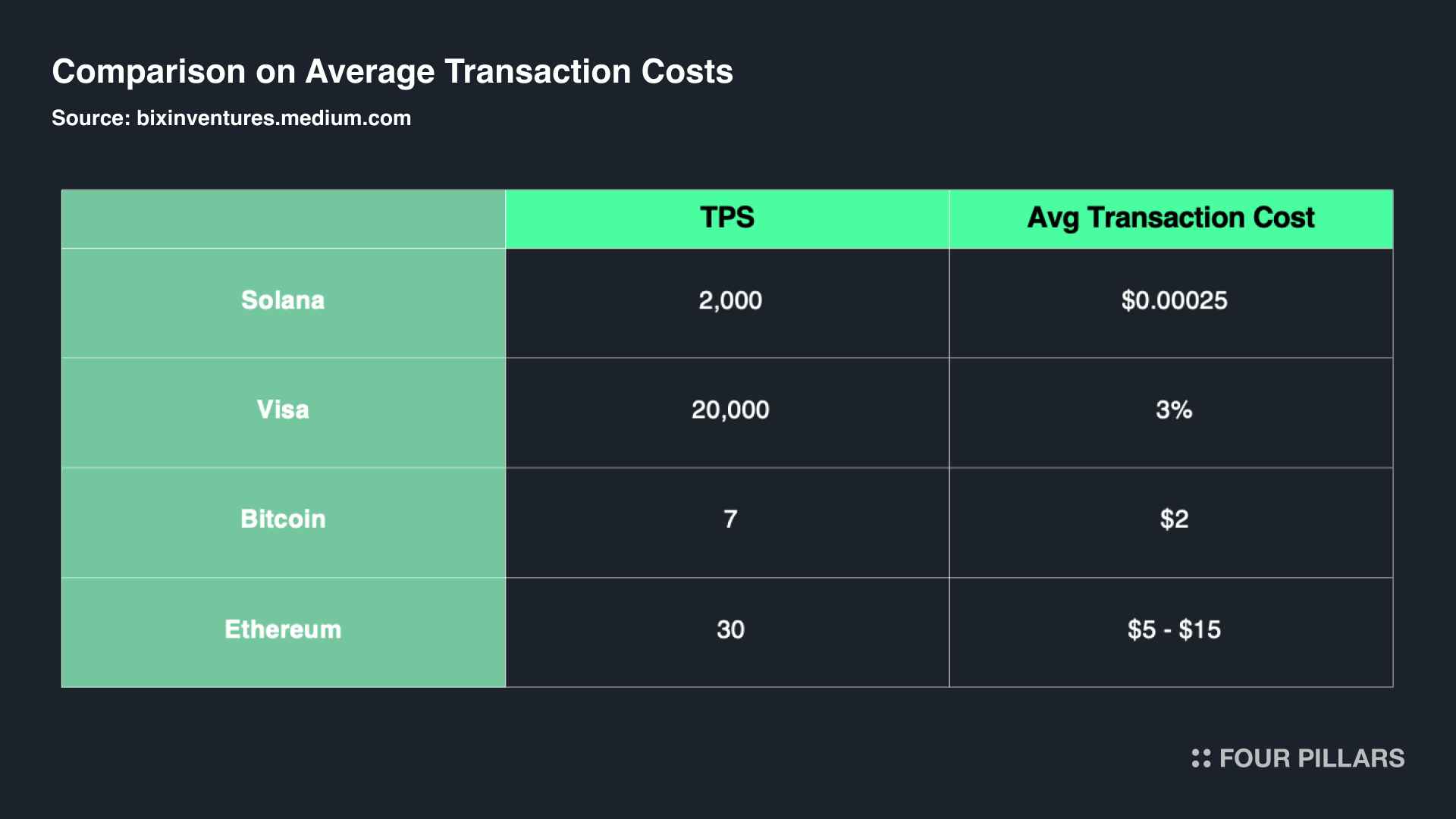
The second area is Payments. In fact, payments using crypto assets based on P2P blockchain have often been mentioned as a meaningful use case that can address the challenges of the traditional financial system, such as the middleman issue, high fees, and slow transaction times. Solana, with its parallel processing through multi-threading, fast processing speeds, and low transaction costs, is establishing itself as the most suitable blockchain for crypto payments. It is actively enhancing various initiatives (e.g., Token Extension) in this field to make blockchain transactions as intuitive and simple as credit card payments - Circle's USDC has long been officially partnered with Solana, and PYUSD, issued through the partnership between Paypal and Paxos, has been available on the Solana blockchain since May. Visa announced that it would include Solana in its stablecoin payment infrastructure, and Solana Pay, an open-source platform introduced in February 2022, allows various applications to build crypto asset payment functionalities. Solana Pay plugins have also been integrated with platforms like Shopify, Citcon, and Checkout.com.
Initiatives for Client Diversity & Validator Decentralization
Moreover, based on the principle that diversity in validator clients enhances network stability and security, Solana is working to improve resilience through initiatives for various validator clients - diversity in clients can minimize the impact of a single software flaw on the entire network since a bug or vulnerability present in one client may not be found in another.
Initially starting as a single client from Solana Labs, Solana began to diversify its clients with the release of Jito-Solana, a second client developed by Jito Labs in August 2022. Additionally, the test version of Firedancer developed by Jump Crypto, an independent validator client based on C/C++ , has been made available.
Furthermore, Tinydancer, a diet client enabling transaction validation at low cost, has also received considerable interest, particularly as it mitigates misunderstandings that decentralization is not genuinely happening due to the high hardware specs* typically required to run a Solana node - optimizing hardware specs to enhance the performance of the Solana network is essential, and Vitalik also suggests in his Endgame post that instead of lowering the hardware requirements for nodes responsible for block production, the network can achieve scalability, security, and censorship resistance by decentralizing and separating the relatively lighter role of nodes dedicated to block verification**.
*Recommended specs for operating a Solana node are as follows: (Source : helius.dev)
12-core CPU with 2.8GHz clock speed minimum
128/256GB of RAM (RPC nodes might require more for custom database indices)
2-4 NVME drives of at least 1TB
10 Gbps Network
**The proposal of PBS (Proposer — Builder Separation) structure by Ethereum is also based in this context.
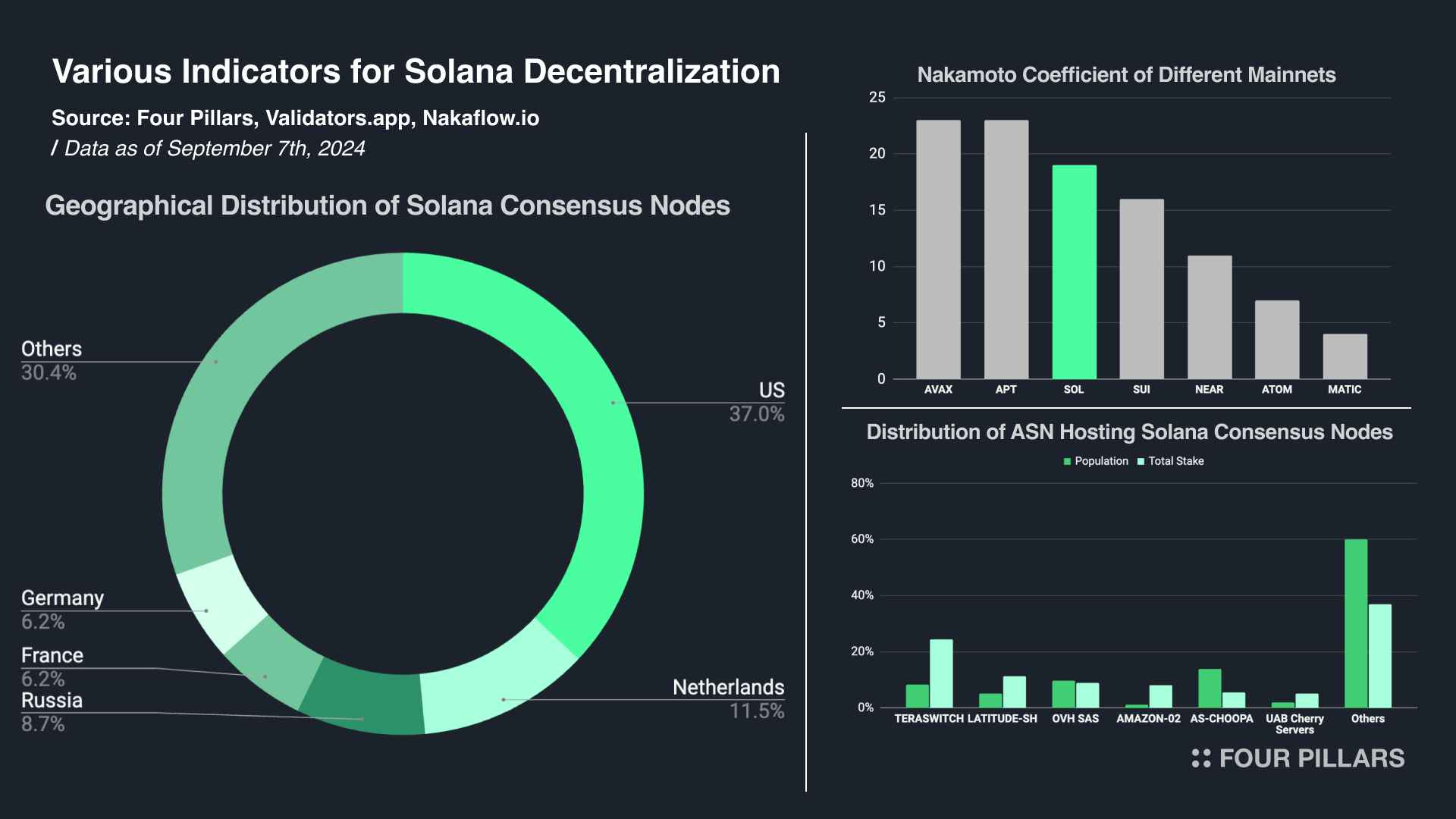
Despite requiring high-spec hardware, the data centers hosting approximately 1,300 Solana consensus nodes are very distributed, and the Nakamoto Coefficient, referring to the number of validators that can cause operational problems for the chain, remains around 20. Though geographically centralized around the US, continuous optimization between software and hardware following Moore's Law and operation of delegation program based on decentralization-related criteria evidence that Solana is gradually achieving decentralization.
In summary, positioned as one of the few chains with several independent validator clients aside from Ethereum, Solana continues its efforts toward decentralization and seeks ongoing stability in the network.
Solana has been solidifying its internal foundation and actively expanding its business outreach. This process has provided enough elements to appeal to institutional investors, with Cathie Wood, CEO of Ark Invest, publicly expressing a positive outlook on Solana's vision, and Grayscale's Solana trust product skyrocketing by 869%. In essence, Solana has proven its potential to recover an ecosystem that seemed to be in crisis with a consistent vision and rapid execution.
This section closely examines each of the technical stack elements that have steadfastly supported Solana’s unwavering vision and driven the revival of its ecosystem.
4.1.1 Languages
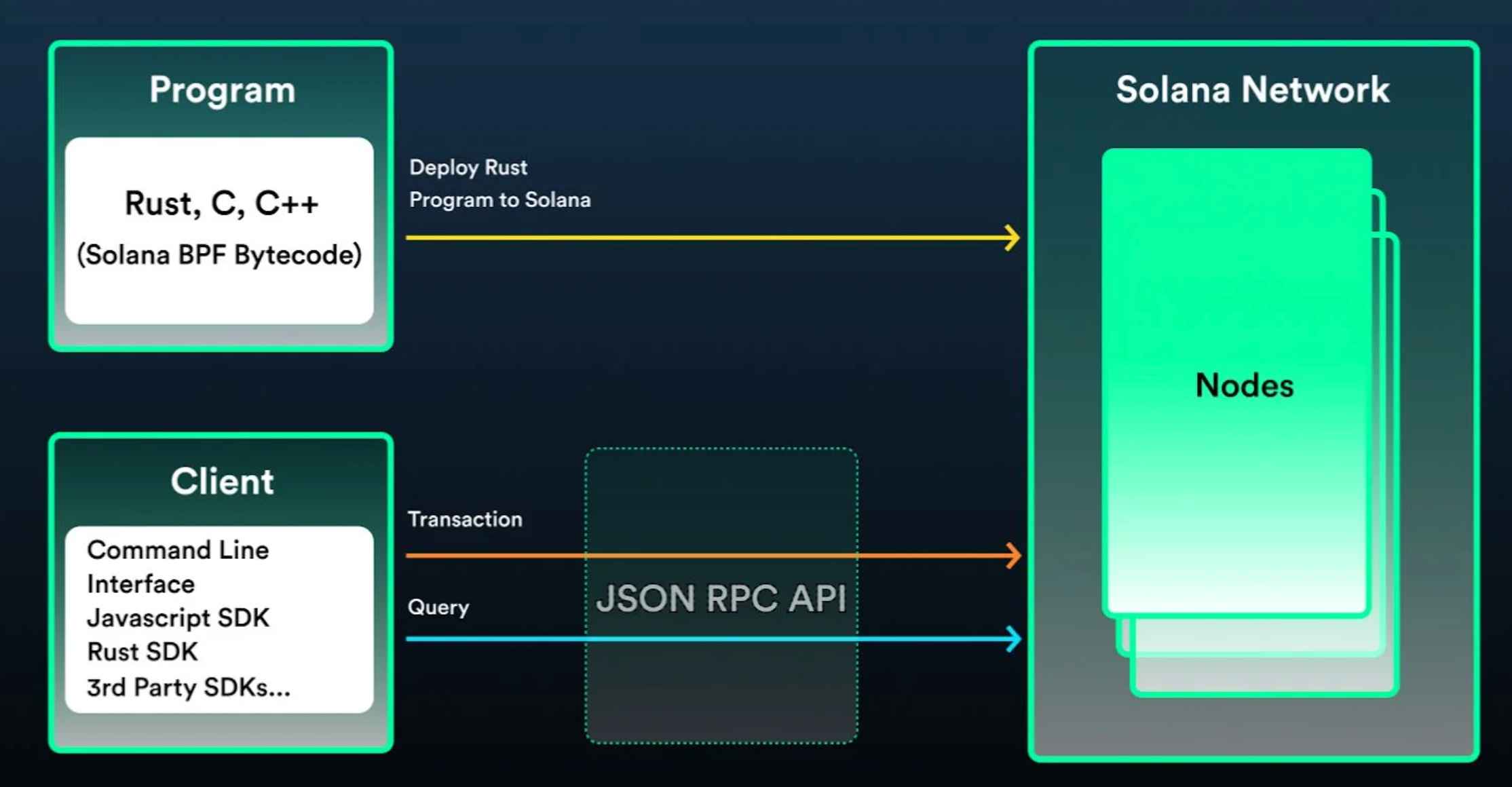
Source: Solana
It was explained that Solana, on the surface, aims to lower transaction fees and block times, while technically, it has a mission to optimize software for hardware. To achieve this, Solana had to carefully select a programming language for its programs (i.e., smart contracts) and consequently adopted Rust programming language - Rust supports concurrency, memory safety, low-level control, and a powerful type system that prevents type errors, ensuring that the code is safe and predictable.
However, Solana ultimately aims to create an environment where all LLVM (Low-Level Virtual Machine)* languages are interoperable. Therefore, while Rust is primarily used for developing programs on Solana, it is possible to leverage LLVM to convert code written in other languages like C or C++ into machine code executable on Solana.
To interact with the Solana network on the client side, various SDKs based on JSON RPC APIs can be used, such as those for Java, C#, Python, Go, or Kotlin.
*LLVM is a collection of modular compiler and toolchain technologies that enable high-performance, high-quality code to be efficiently optimized across various hardware platforms, making it a preferred development environment for skilled developers.
4.1.2 Core Innovations
Solana applies eight core technologies to ensure top speed throughout the entire process from when a user submits a transaction to when a block is produced. To aid understanding them, let's briefly overview how Solana's consensus mechanism works.
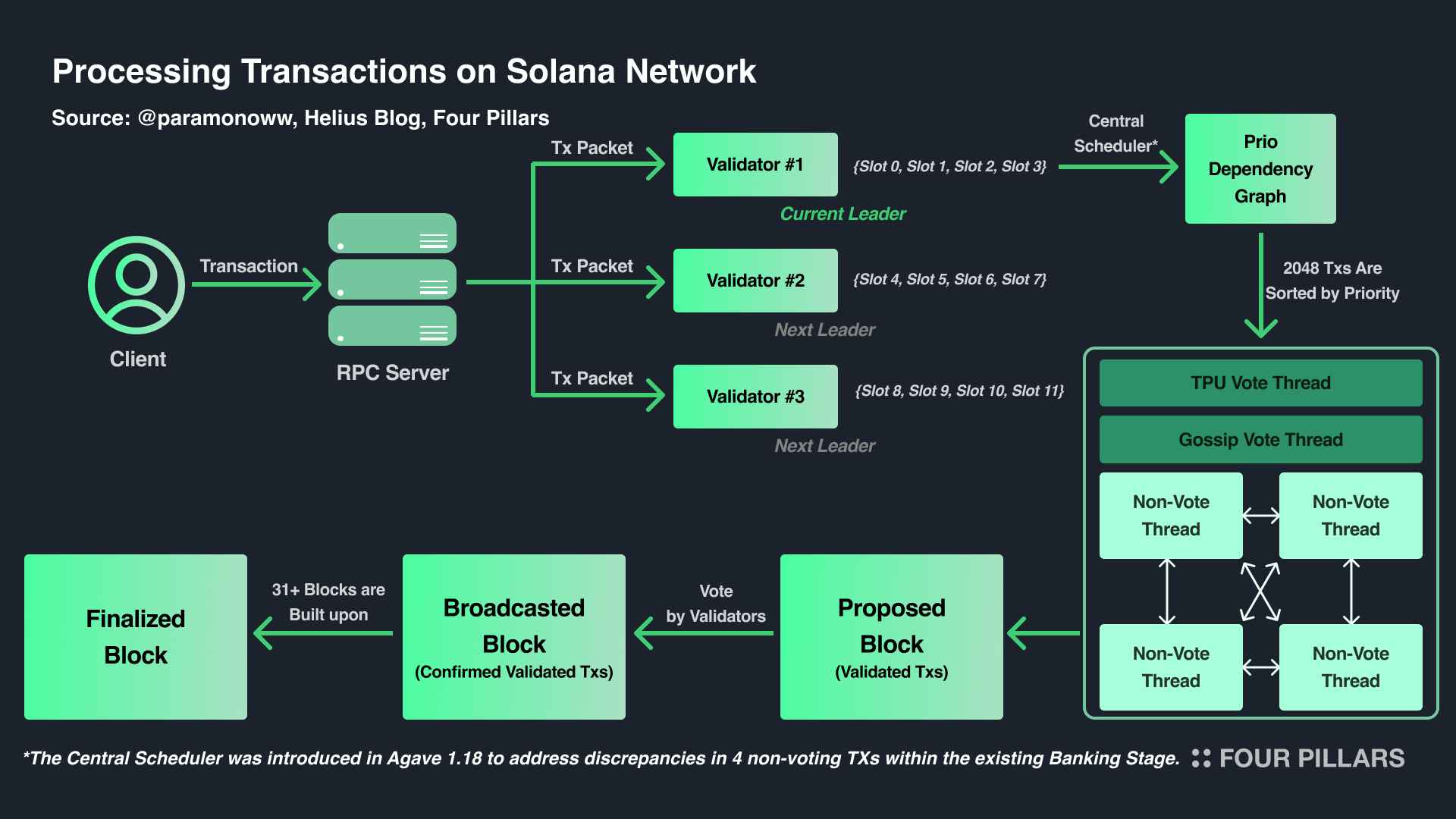
Transaction Signature & RPC Nodes’ Transaction Reception - The client signs the transaction through the wallet, and the signed transaction is sent to the RPC node.
Leader Node Selection - Meanwhile, the selection of the leader is based on the staked weight of nodes delegated by token holders, with validators rotating according to a Leader Rotation Schedule*.
Banking Stage and Timestamping - In the Banking Stage, transactions are classified into those that will be processed sequentially and those that will be processed in parallel, and then assigned to independent threads(Out of six threads, two handle Vote transactions, while the remaining four are prioritized and processed by the Central Scheduler**). The leader node uses Proof of History (PoH) to add timestamps to transactions, determining their order.
Block Creation - The leader starts creating a block with its PoH Sequence.
Block Propagation - The newly created block is sent to replicator nodes (i.e., other validators in the network).
Transaction Validation*** - Replicator nodes verify the transaction order using their PoH Sequence and ensure the transactions comply with network rules. Since transaction order relies on their PoH Sequence (i.e., global clock), no P2P communication between nodes is needed.
Block Finalization - Once transactions are ordered and validated, the block is added to the blockchain. Then, the next leader is selected, and the process starts over.
*Solana has a Leader Rotation Schedule that allows leaders to be known one epoch in advance to ensure that blocks are not delayed or stale.
**The central scheduler, introduced in version 1.18, manages the prioritization and processing of all transactions, eliminating complexity and overhead.
***This part can be better understood through Proof of History section below.
Proof of History
As briefly mentioned in the introduction of the text, the essence of Proof of History is that each validator effectively generates and holds a 'global clock' that allows them to reference the order of all transactions. For example, hashing a previous hash (i.e., hash1) to produce hash2 (i.e., sha256(hash1)) intuitively indicates that hash1 preceded hash2. Solana calls this process a ‘Sequence.’

Source: Solana Whitepaper
In other words, this sequential hashing data structure serves as proof of the passage of (global) time, and since every validator generates and holds this proof independently, they don’t need to communicate with other validators to confirm the passage of time, allowing for the rotation of the leader validator without additional coordination. This is the key reason why Solana, by applying PoH, can achieve shorter block times compared to other blockchains.

Source: Solana Whitepaper
Generating this sequence is possible only through single-core processing due to the need to reference the previous output hash, but the verification can be done through multi-core as its logic is simple - hash computation. Thus, it achieves Solana's philosophy of "linearly scalable verification per node to hardware."
Therefore, PoH is more akin to a global clock data structure or a Verifiable Delay Function (VDF) implemented with a sequential hash function than a consensus algorithm, where Solana actually uses Tower BFT DPoS for consensus algorithm.
Tower BFT DPoS
Tower BFT can be described as a version of PBFT optimized with PoH. Tower BFT utilizes Solana's PoH as a global clock to pre-determine order, focusing solely on the consensus process, significantly reducing messaging overhead and latency. The process of validators reaching consensus through Tower BFT is as follows.
Validators vote on the version of the ledger they believe to be accurate, discarding any they deem incorrect, without the need for P2P communication, during a fixed slot duration (i.e., ~400ms). With each vote on subsequent slots after a certain point, the timeout required to rollback to a previous block doubles. This means that as the PoH Sequence that the majority of validators have voted for continues, it becomes increasingly difficult to rollback - for example, if all validators voted 35 times over the past 14 seconds (14,000ms / 400ms = 35 slots), the effective time limit of the network would be ~435 years(2^350.4/3600/24/365), making a rollback practically impossible.
As a result, only ‘the heaviest Sequence,’ which is the hardest to rollback because the majority of validators voted for it, remains in the blockchain, and those validators who voted on this Sequence receive rewards. In short, thanks to PoH, validators with Tower BFT can asynchronously calculate timeouts without the need for P2P communication, ensuring that votes are timely, maintaining network liveness and reducing the likelihood of forks.
*Voting is weighted based on the stake each validator holds in the network.
Gulf Stream
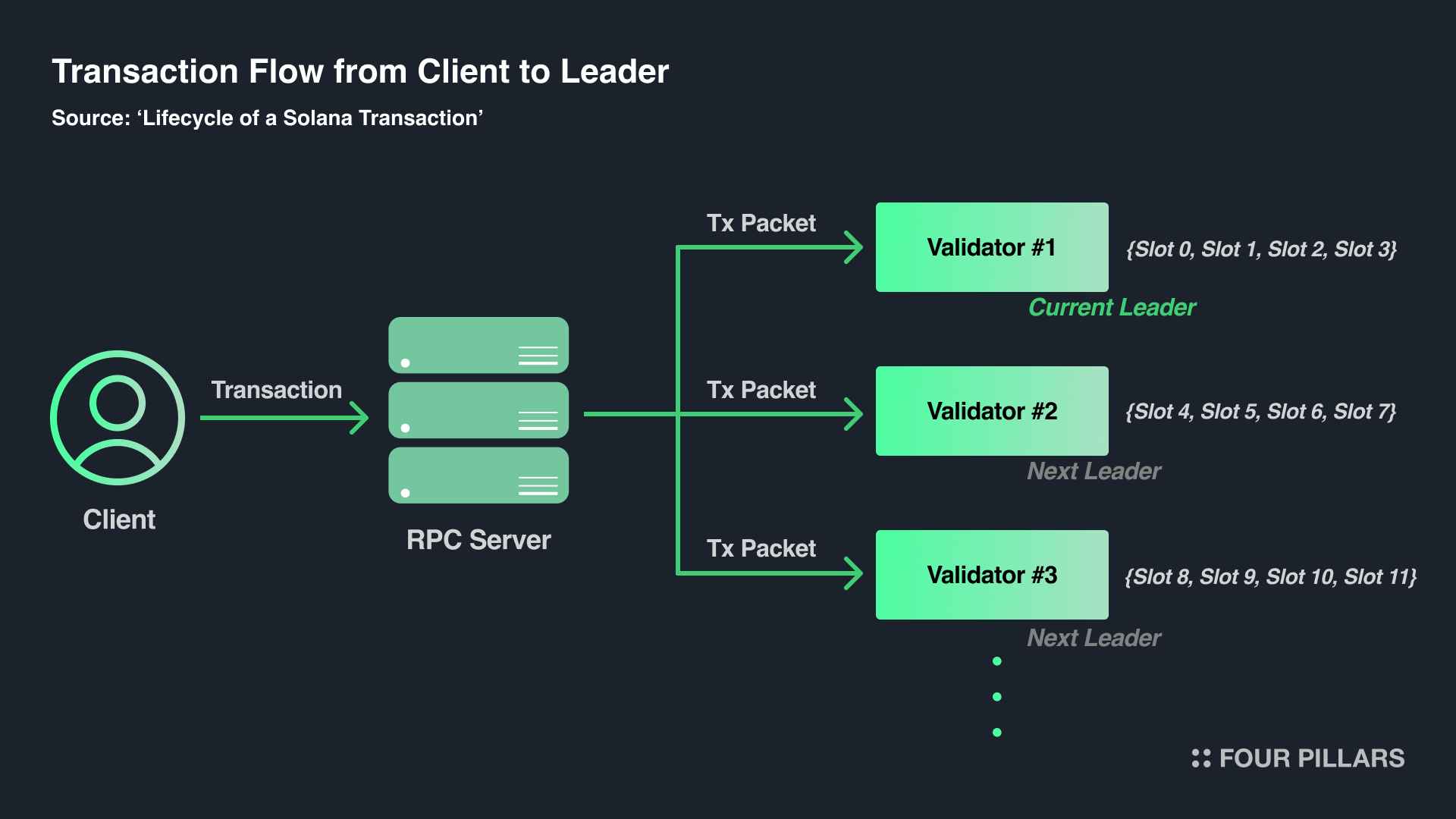
Unlike other blockchains, Solana does not require a public mempool to hold users' transactions because block space is not scarce relatively due to high transaction throughput. Instead, transactions occurring on the client side are encoded into QUIC streams and sent directly to the validator selected to be the next leader. This approach, known as Gulf Stream, allows for quick leader transitions and pre-execution of transactions, reducing memory load on other validators.
Sealevel & Cloudbreak
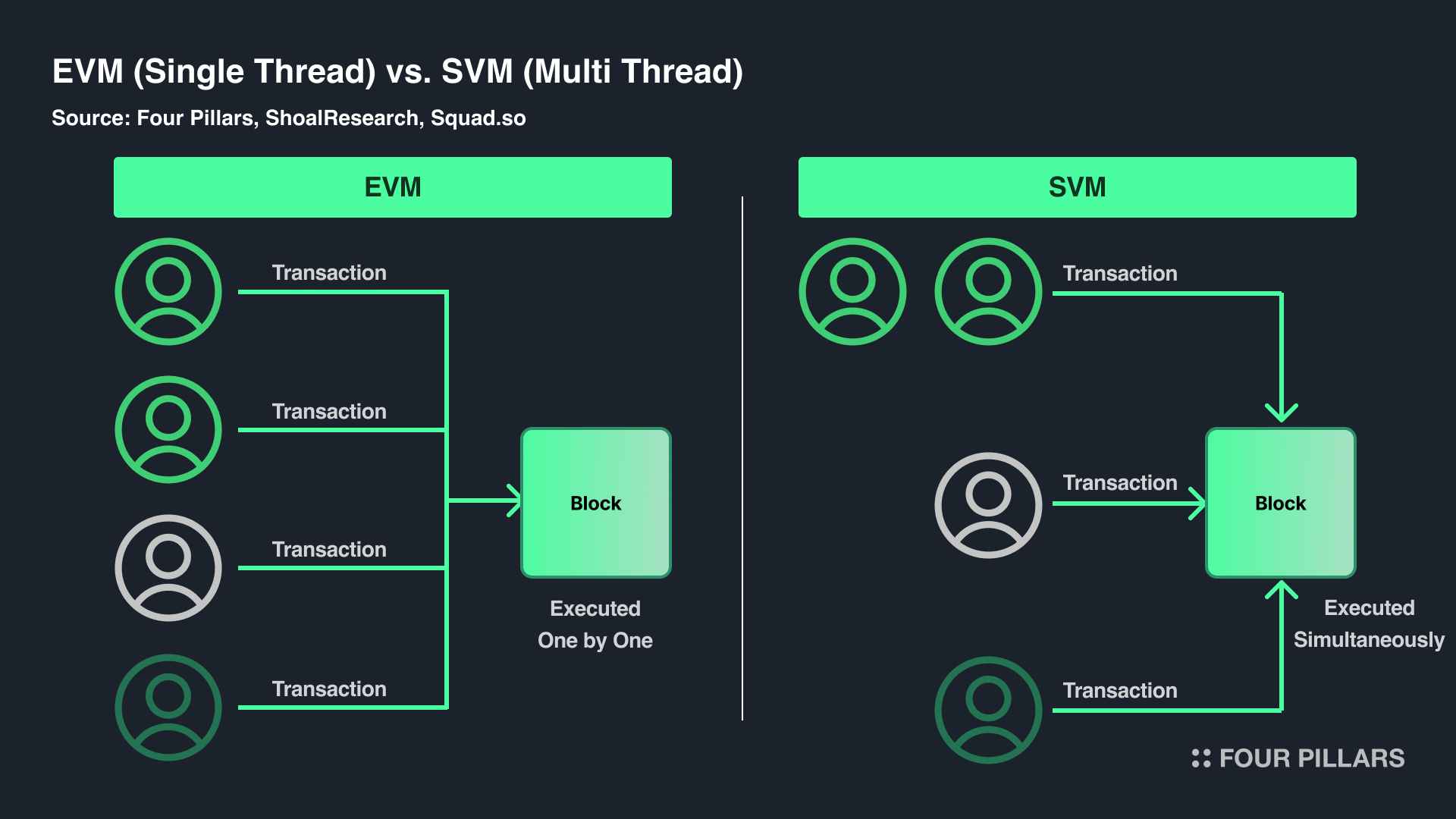
Sealevel is a core technology that enables multi-threaded parallel processing in Solana, unlike EVM or WASM-based runtimes*. It relies on 'Instructions' within each transaction, with the accounts array containing global state information of the Solana network. Transactions are pre-classified based on declared read/write states per account for parallel processing.
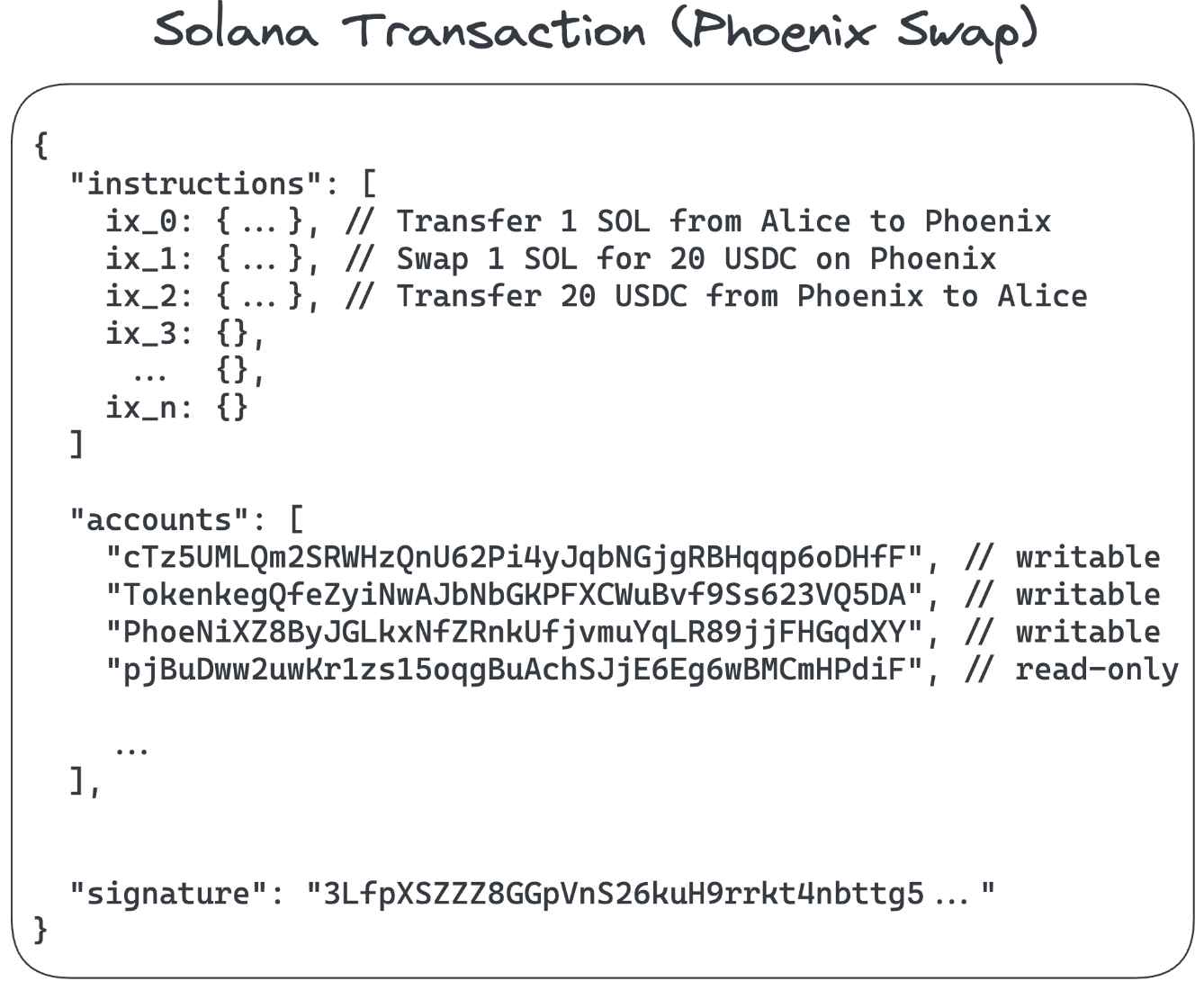
Source: Lifecycle of a Solana Transaction
By the way, it is very difficult to organize the account database in such a way that it can be read/written simultaneously by multiple threads, even with any traditional database. To this end, Solana developed Cloudbreak to maximize the efficient use of SSDs by partitioning the account data structure in a specific way to benefit from the speed of sequential operations and adopting memory-mapped files.
*As mentioned earlier, this parallel processing logic in Sealevel is also the reason why the localized fee market implementation was possible.
Pipelining
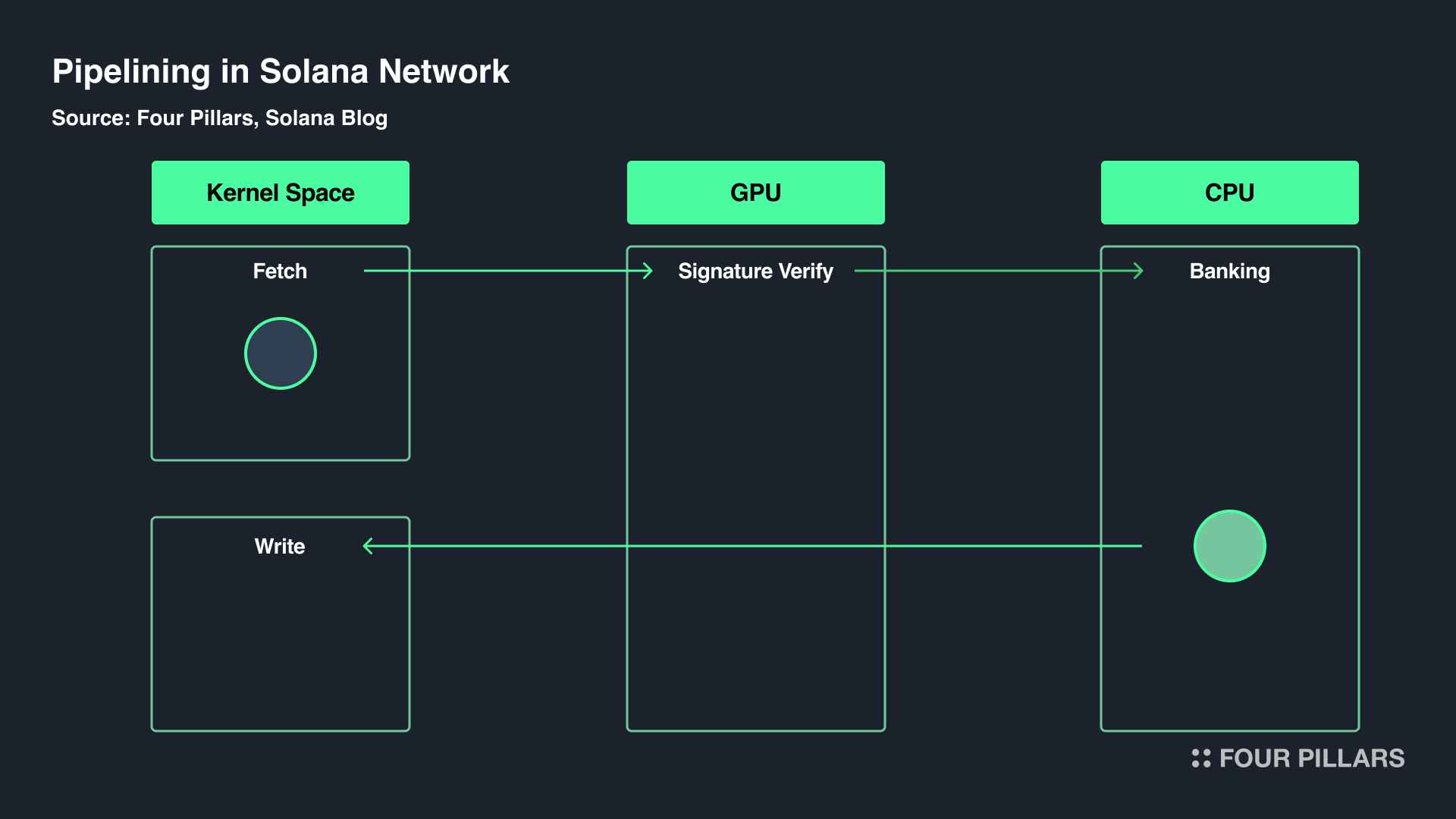
Pipelining in the Solana blockchain is a technique that divides data input streams (i.e., QUIC packets received in advance by the next leader) into multiple processes operating in different parts of the hardware.
The pipelining process goes as follows.
Data is brought into kernel space, where it is then passed to the GPU to allow for parallel signature verification.
Once signatures are verified on the GPU, the data is handed off to the CPU for the banking process.
Simultaneously, kernel space is already preparing the next set of data, while the CPU processes data for recording (writing) on the blockchain before transmitting it to the next block.
Solana maximizes hardware utilization and enhances efficiency through pipelining, speeding up the verification and transmission of blocks.
Turbine
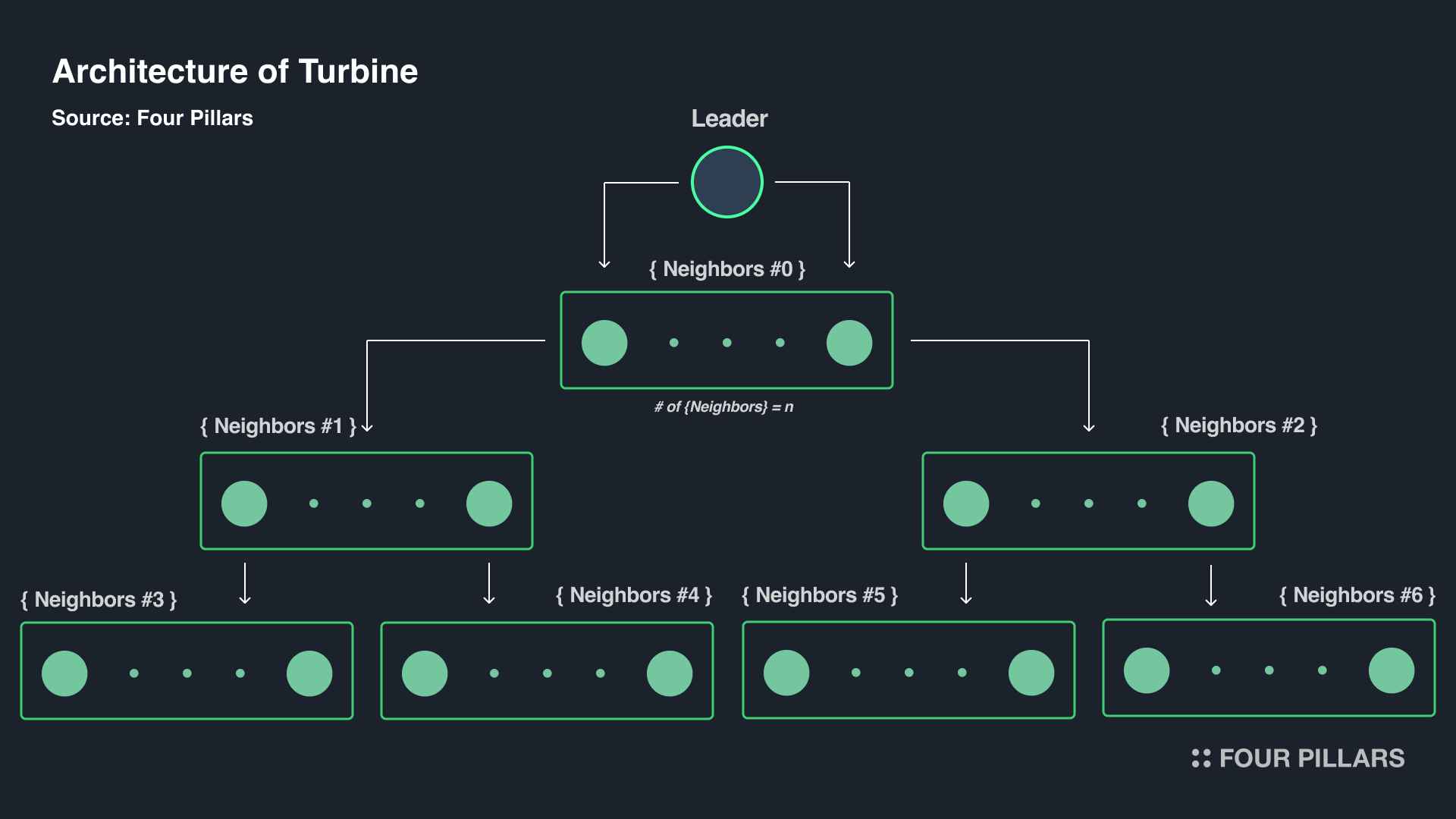
After transactions are processed, the leader must propagate the changed ‘State’ to each validator. If large volumes of data were to be sent individually to many validators, it would be highly inefficient. To address this issue, Solana employs a technology called Turbine, similar to the one with BitTorrent - simply put, this technology involves the leader dividing QUIC packets (optionally with erasure codes) into smaller packets and distributing them to validators with a hierarchical structure.
For instance, consider a 128MB block. To process this block, the leader divides it into 2,048 pieces of 64KB packets and distributes them to a few validators. These validators, in turn, retransmit the packet pieces to other colleague validators, referred to as Neighbors - initially receiving validators are chosen among nodes with a high staking ratio of SOL tokens. Validators recursively pass on part of the data they received to the below group of Neighbors. This architecture allows the data initially intended for transmission by the leader to eventually reach a number of validators exponentially proportional to the size of the Neighbor group(i.e., n) as the stages deepen. As the size of the Neighbor group increases, the steps required to connect the network decrease in a logarithmic scale, allowing for rapid data propagation.
Especially in cases where a few validators at higher levels engage in malicious activities (e.g., Eclipse Attack), they could potentially have a relatively large impact on the entire network. Therefore, the network adopts a method of sending packets through different random paths each time.
Archiver (Ledger Replicators)
Solana's Archivers are used to store approximately 4 petabytes of data generated annually by the network. They can be considered a type of light client that does not download the entire Solana ledger but stores only a part of it, allowing a broad spectrum of validators with varying hardware requirements to participate.
When Archivers are allocated data to store from the network, they perform a role of verifying the authenticity of the data through Proof of Replication (PoRep), a technology based on Filecoin. Archivers announce their storage space to the network and receive up to 3% of inflation as a reward for storing and verifying the assigned data.
The key technologies previously discussed enable fast transaction processing, a parallel execution environment, and low latency, making Solana an ideal infrastructure for applications built on its network. However, Solana's high throughput can also pose challenges in securing network stability against MEV bots or spamming. In response, Jito emerged as Solana's second client in August 2022 to address the inefficiencies in MEV extraction and centralized liquid staking protocol issues, contributing to network stabilization and decentralization.
In addition to this, the client diversity of the Solana network is expected to further expand with the upcoming release of Jump Crypto's Firedancer, which offers enhanced performance through advanced software optimization, Tinydancer, a diet client that allows many users to validate transactions with lower hardware requirements, Sig, which is being developed using another low-level language, Zig, and Agave by Anza.
4.2.1 Jito-Solana
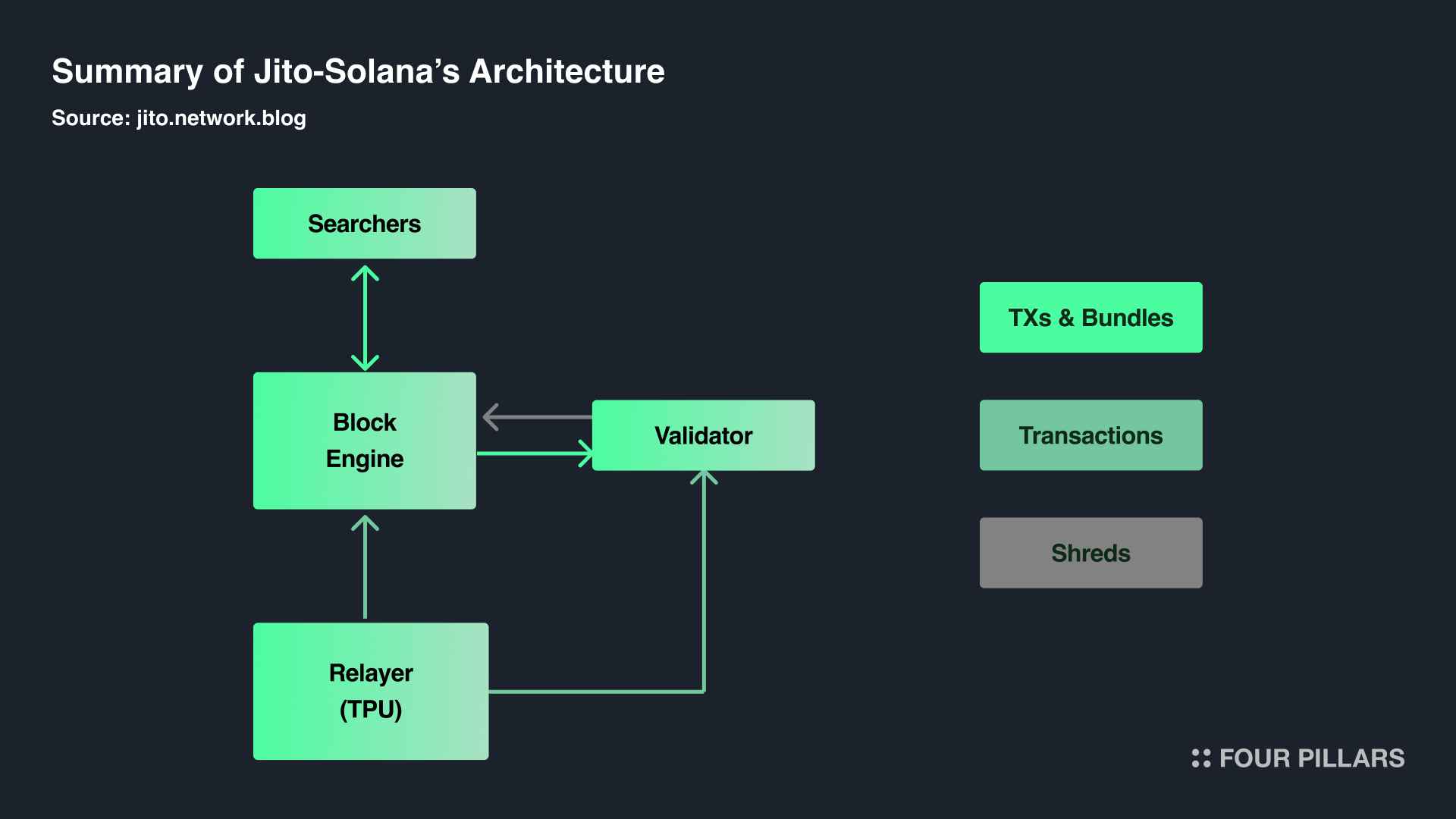
Source: jito.network/blog
Jito-Solana activates the MEV marketplace, akin to Flashbots' MEV-boost solution in Ethereum. However, due to Solana's unique design, lacking a mempool and processing transactions primarily in a first-come-first-serve manner with significantly faster block times compared to Ethereum, Jito-Solana operates differently.
To align with the unique characteristics of the Solana network, Jito's MEV client introduces a virtual memory pool that conducts auctions at 200ms intervals, streamlining the MEV extraction process. With Jito-Solana, Searchers can review and simulate transactions through the Block Engine*. After constructing the most profitable transaction bundles, they access the leader node via a dedicated processing pipeline. Since the transaction bundling and block auctioning occur off-chain, failed bundling attempts do not significantly impact network congestion.

Source: explorer.rated.network
Since its launch in August 2022, Jito-Solana has steadily grown in adoption, showing about 40% adoption rate as of writing this article(i.e., September 7th, 2024).
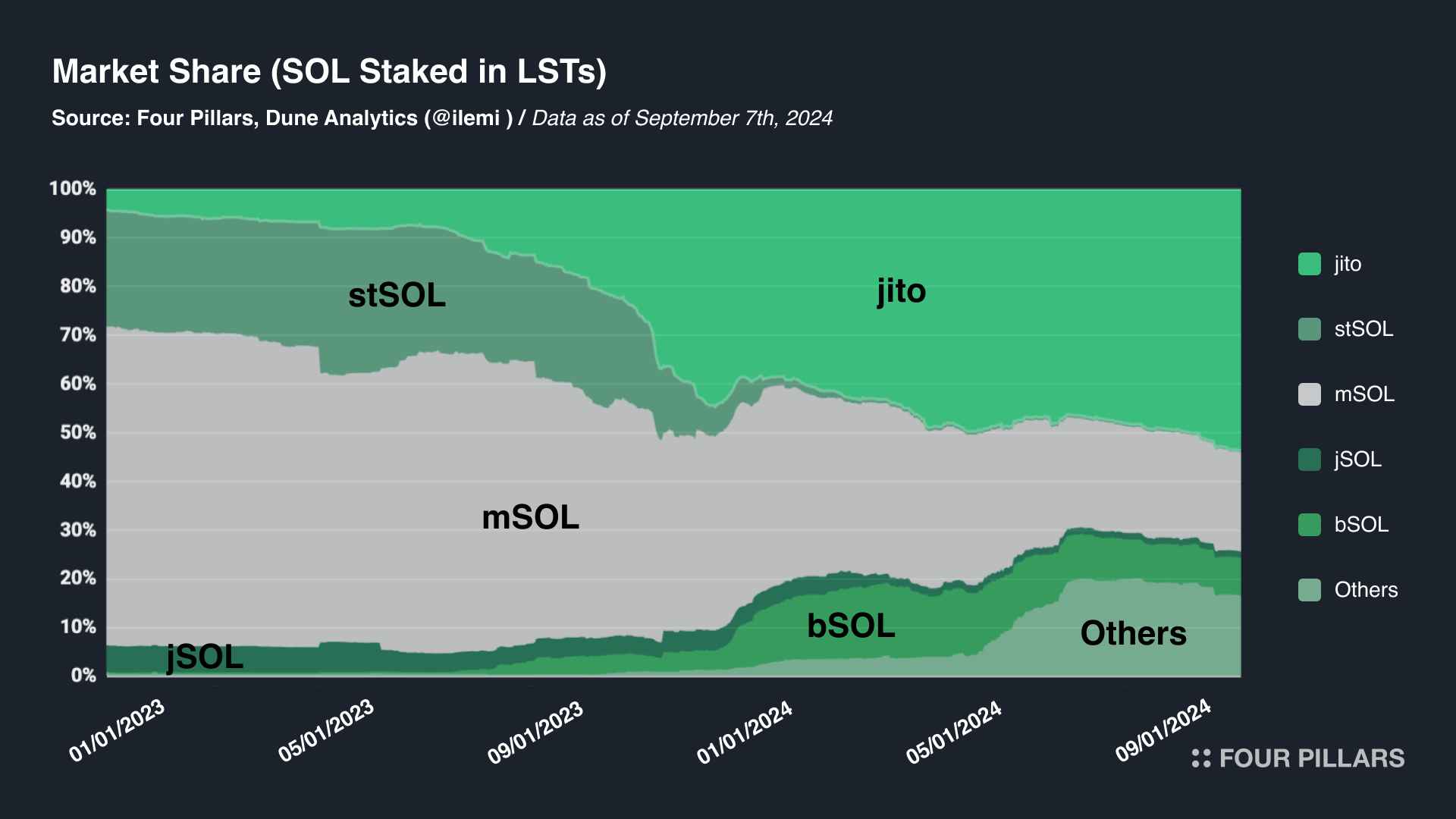
Additionally, Jito has introduced a liquid staking mechanism (i.e., JitoSOL) to its MEV solution, extending MEV earnings to its users and contributing to the expansion of the DeFi ecosystem.
*Block Engine charges a 5% fee on MEV profits allocated to validators or jitoSOL stakers. According to the following analysis dashboard, as of September 7th, 2024, the cumulative validator tips have reached approximately 1,471,989 SOL, and Jito Labs has earned around 77,473 SOL in revenue.
4.2.2 Firedancer
Firedancer, being developed by the Jump Crypto team, is a new validator client completely re-implementing Solana Labs' client in C. It aims at enhancing performance through software optimization and increasing the diversity of validator clients within the ecosystem. Firedancer has so far been successfully deployed and tested in a testnet environment through a separate hybrid client called "Frankendancer," which applies the latest runtime environment and consensus module of the existing client to Firedancer’s architecture.
Its first demo version showcased at the Breakpoint conference in November 2022 demonstrated the ability to process up to 1.2 million TPS(600k after duplication). The second demo, showcased on September 21, 2024, not only demonstrated the ability to process 1 million TPS in a controlled environment, but also announced that it is already live on the mainnet in non-voting mode* - the Firedancer team stated that after further feature additions, optimizations, and audits, they plan to release it at a production level.
*That is, while the Firedancer client participates in the gossip protocol and communicates regarding transactions on the Solana mainnet, it is not actively producing blocks directly at the moment.
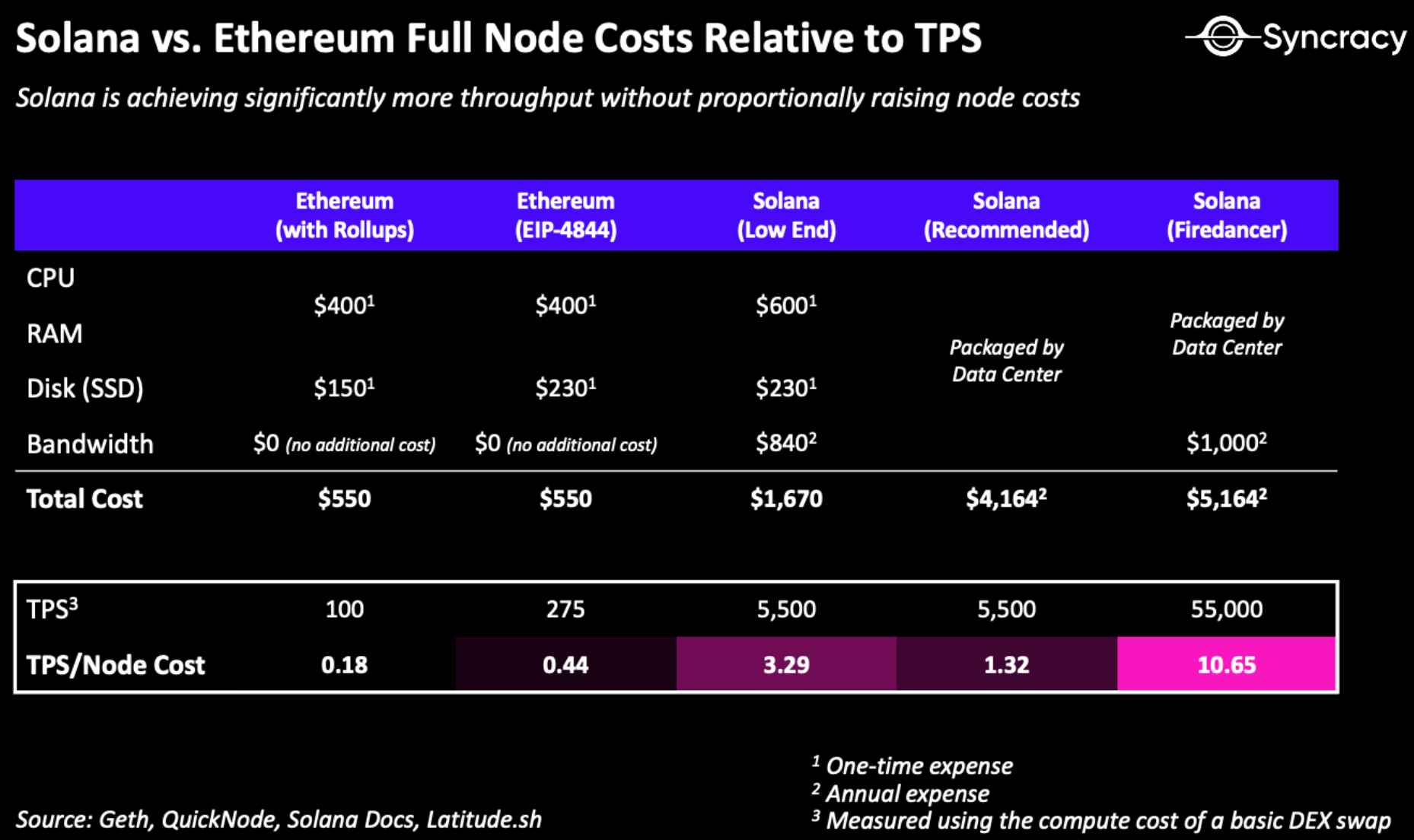
Source: Syncracy
According to Syncracy's 'Solana Thesis – The Fastest Horse Rises From the Ashes', using Firedancer could slightly increase node operation costs but achieve a competitive TPS/Node Cost ratio by reaching approximately 55,000 TPS**.
A significant difference between the existing client and Firedancer in terms of high-level architecture is that Firedancer optimizes each process through a modular architecture composed of numerous individual processes known as "Tiles." In other words, by adopting this modular architecture, Firedancer eliminates situations where the existing Solana network would experience downtime due to errors in specific functions or during upgrades, and this allows for more flexible optimization and upgrading of each process.
**We have to wait and see when it goes live, but if Firedancer performs significantly better than existing clients, node operators' client choices will be driven to Firedancer, and client diversity may not be achieved in practice.
4.2.3 Tinydancer
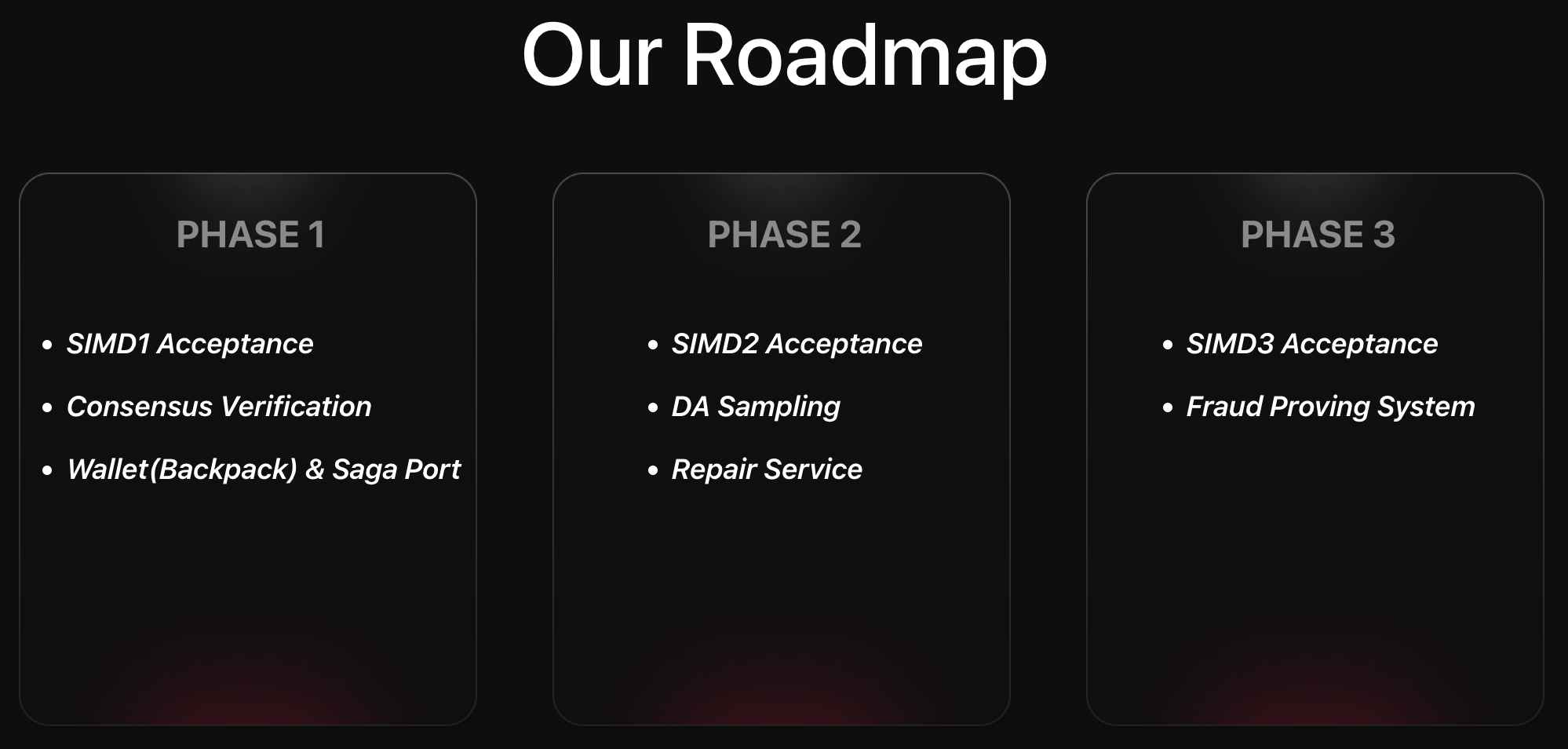
Source: Tinydancer
The Solana network lacks a light client feature that allows for state validation without running a full node, limiting its validation capabilities. To address this, Tinydancer, a light client under development, enables transaction verification at a low cost without downloading the entire block or executing transactions. It alerts the full node it depends on when suspicious transactions are detected.
In a situation where the operational requirements for running a Solana node inevitably become more demanding in order to improve performance, the introduction of light clients like Tinydancer could be a significant milestone in enhancing the accessibility and verifiability of node operations on the Solana network.
Although the final design of Tinydancer, which successfully launched its Simplified Payment Verification (SPV) client on the testnet in May, is still being refined, it remains to be seen whether Solana can truly offer practical verification capabilities to a broader user base and achieve ‘decentralization through affordable validation’.
4.2.4 Agave & Sig
In addition, there are Anza team's Agave, which forks Solana Labs' client to improve the performance of the existing Solana network and undertakes various initiatives to support the development of other clients like Firedancer, and Syndica team's Sig, a client being developed in Zig, a low-level programming language focused on readability and simplicity.
In short, ensuring client diversity in a blockchain network is crucial not only because it eliminates the potential single point of failure that can occur when operating a network with a single client software, but also because it allows for various experiments aimed at optimizing the network's performance across different environments (e.g., programming languages). While we need to observe how these upcoming and existing clients will optimize the performance and scalability of the Solana network, the fact that such initiatives are already underway is certainly a positive development for the network.
Solana not only provides developers with a well-established technical stack, as introduced earlier, but also offers a rich toolkit and set of standards to support the efficient and effective development of diverse applications on the Solana platform.
The Solana Program Library is a collection of on-chain programs developed by the Solana team and community, serving as a standard library for Solana developers. It includes a pre-built set of programs and utilities, such as token creation and management (SPL Token program), token swaps, lending protocols, etc., facilitating the development of decentralized applications on the Solana blockchain.
The Anchor Framework is particularly popular among developers new to Solana or those looking to rapidly prototype and deploy applications. It offers Rust-based DSL, IDL, a testing framework, and a suite of tools for security.
GameShift is designed to streamline the process of creating blockchain-based games, supporting various features like constructing in-game NFT marketplace.
UI frameworks like Scaffold and Wallet-Adapter allow developers to easily build front-end webpages and integrate with wallets within the Solana ecosystem.
Additionally, there are loggers like Geyser, Sologger, and IronForge, a more enriched program testing environment provided by BankRun.js, and a web-based IDE called Solana Playground, among many other documents, frameworks, and toolings available.
Given the vast scope of the frameworks introduced, some standards and sub-frameworks within the entire category that make Solana's unique features stand out or are worth looking forward to are highlighted below.
4.3.1 Token Extension
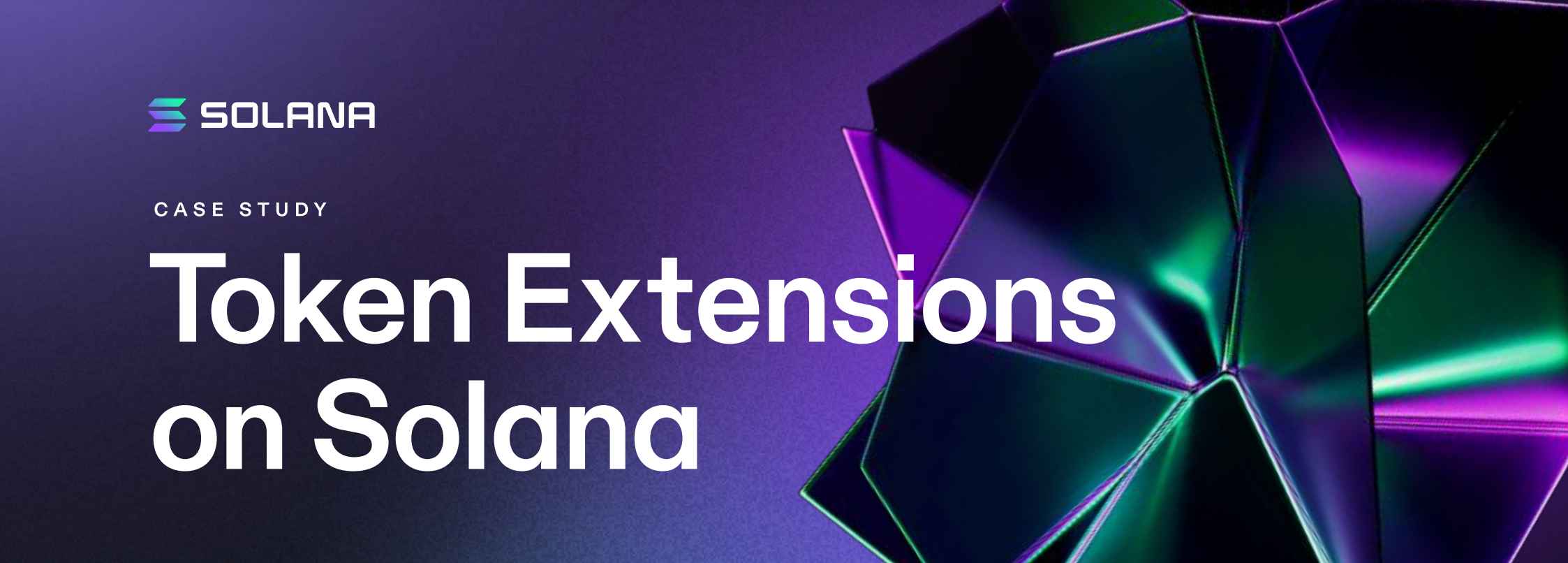
Source: Token Extension Paper
Ethereum provides an environment where various token standards can be freely proposed, while Solana has been less flexible in expanding the functionality of its standards, as it operates with a single SPL token standard set that comes with limited logic. Moreover, with the advancement of blockchain, there is a rapidly growing demand for implementing complex token functionalities that meet the regulatory, legal, or compliance requirements of enterprises. For this, Solana and Anza team has developed a new token standard set called the 'Token Extension' embedded in the protocol layer.
The core of this new standard is to add configurable functionalities to the existing SPL tokens to support various use cases without additional libraries. There are two types of Token Extensions: 1) Mint Extension and 2) Address Extension.
The former extends the token's functionalities, including Transfer Hook for conditional execution of programs upon token transfers, Transfer Fee for directing fees to specified accounts, enriched Metadata, and features like Non-Transferable Token and Confidential Transfer. The latter includes features related to account management, such as Immutable Owner to prevent reassignment of account ownership, and Default Account State for setting account states that require specific interactions with projects to use the account and assets.
Detailed functionalities and use cases are described in the paper, but from a functional perspective, the standards implementable with Token Extension have already been discussed or adopted within Ethereum's ERC standard space, still not encompassing Ethereum's standard spectrum. However, a critical difference is that, unlike Ethereum's application-level ERC standards, Token Extension is implemented at the protocol layer. This is a much bigger advantage than it seems - developers not only benefit from being able to configure the Token Extension to their liking and quickly build programs, but they also don’t have to worry at all about compatibility issues between different applications. (We are already observing how the Ethereum ERC-4337 account abstraction standard, deployed at the application level, is gaining popularity, and how various entities are actually using ERC-4337 in increasingly fragmented ways.)
Token Extension is already producing significant results. As mentioned earlier, PayPal successfully onboarded to the Solana chain this past May, thanks to the Token Extension. Additionally, Libre Capital launched an institutional fund for Solana using the Token Extension - as a result, Solana users now have access to a variety of funds in an on-chain environment, including Hamilton Lane's SCOPE, Brevan Howard's Master Fund, and BlackRock ICS Money Market Fund.
4.3.2 Executable NFT (xNFT)
Users who are familiar with engaging in various activities on the blockchain have likely experienced the complexity and inconvenience of having to connect their wallets to third-party websites to interact with different applications or manage their assets. The standard being introduced this section allows executable code to be injected directly into the asset itself, thereby eliminating this security vector and enabling the asset to function as a single, scalable application capable of multiple functions.
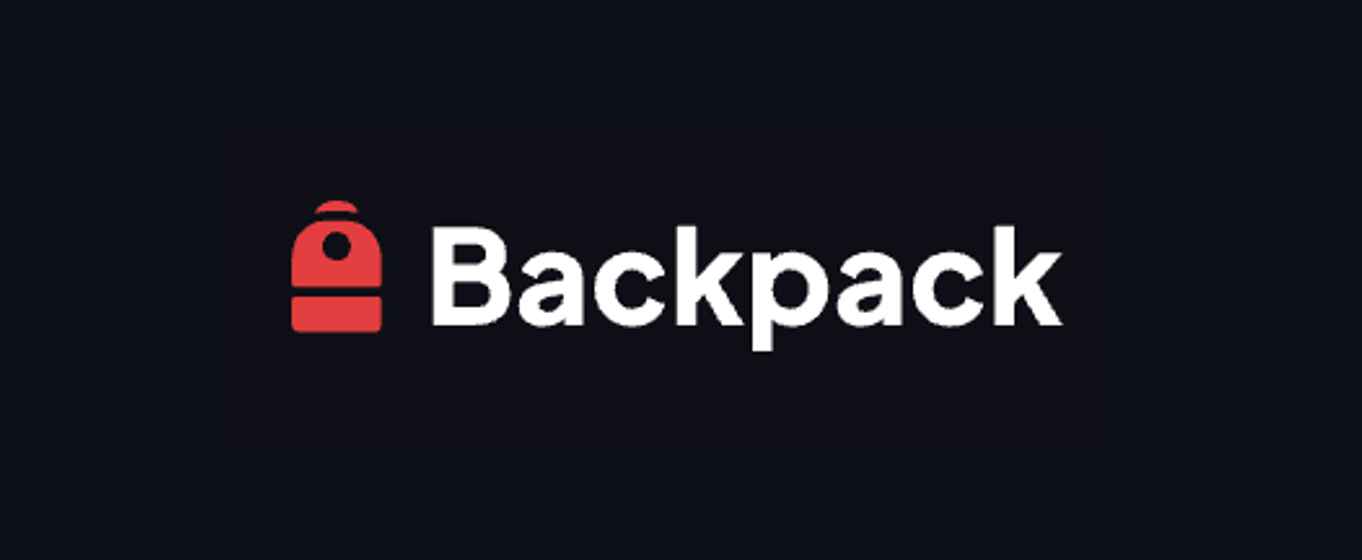
xNFT, developed by developers at Coral for the Solana blockchain, represents 'executable' assets or codes. Simply put, implementing code through xNFT plugins turns it into a functioning web3 application asset.
Coral has developed a unified environment called "Backpack" in the form of a wallet, where these xNFTs can function together organically. In other words, all Web3 applications built as xNFTs can essentially run on the Backpack wallet. As a result, users of the Backpack wallet can seamlessly experience the various applications (i.e., xNFTs) integrated within this super app-like wallet, without needing to make separate connections or transitions.
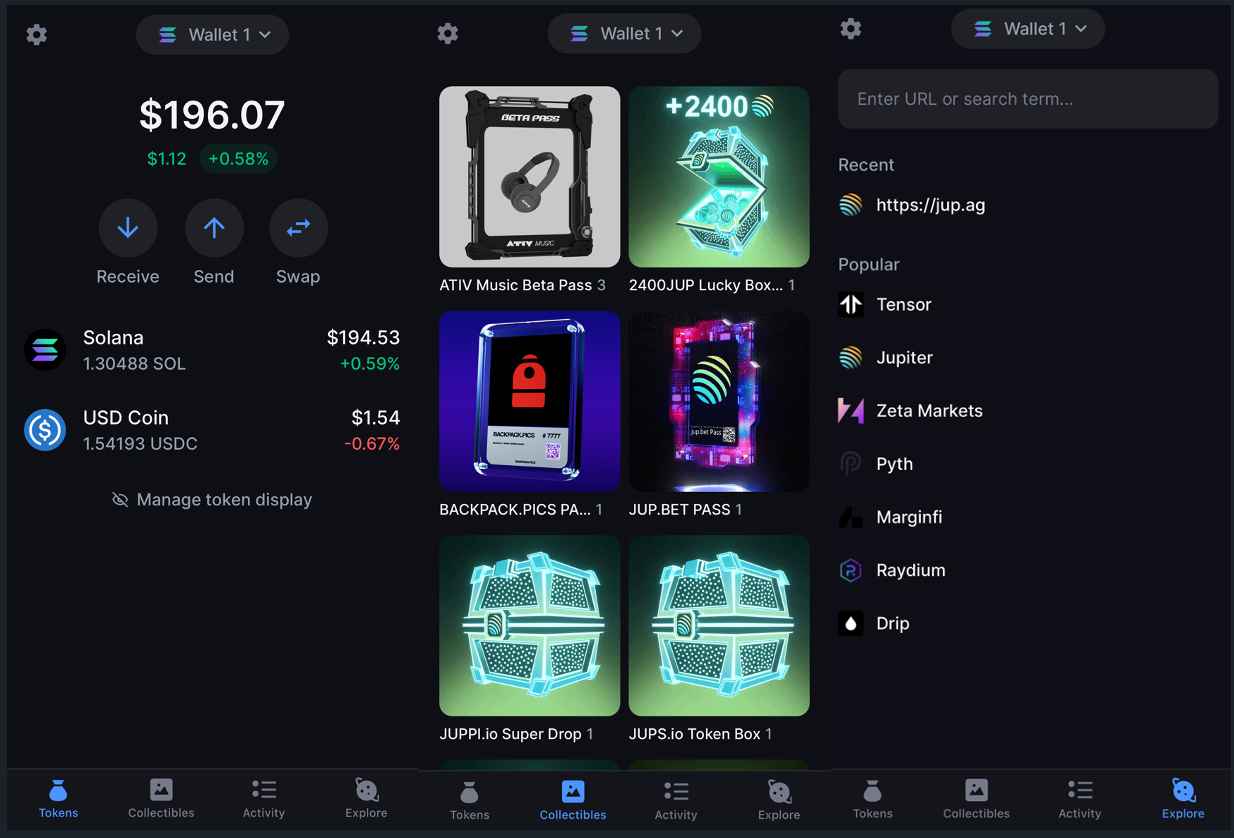
Source: Backpack Mobile Application
Currently, about 90 applications have been released in xNFT format across gaming, NFT, DeFi, and more. Backpack and xNFT standards, provided as fully open-source based on React, could bring significant UX innovations to the decentralized application market if more xNFTs are onboarded and support for various blockchains is extended.
4.3.3 Programmable NFT (pNFT)
When trading NFTs, royalties are a crucial factor in ensuring creators are compensated, allowing them to continue their work. However, consumers tend to prefer purchasing assets at the lowest possible cost, which naturally leads them to favor lower royalties. This "royalty dilemma" examples can be seen in the past competitions for market share between NFT marketplaces like Opensea vs. Blur or Yawww vs. Magic Eden.
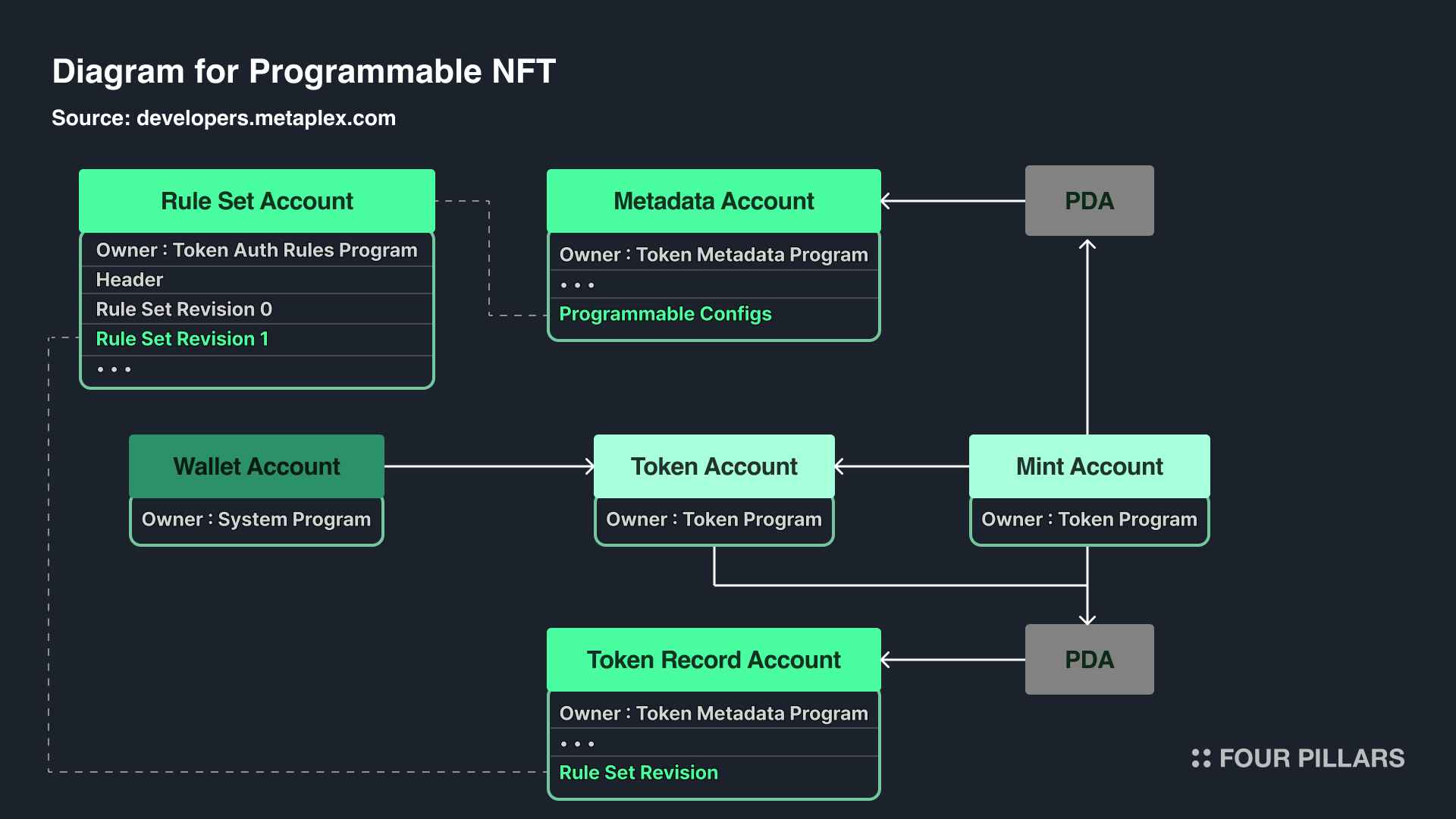
In response to this, the Metaplex team introduced a new standard called Programmable NFT (pNFT) in February 2023. The core idea of pNFT is to allow developers to set custom rules that must be met in order to perform specific actions on NFTs implemented as pNFTs. In other words, if developers implement NFTs in the form of pNFTs (or migrate existing NFTs to pNFTs), they can indirectly enforce royalty mechanisms by specifying which programs are allowed to transfer their NFTs.
4.3.4 State Compression (cNFT)
Storing data on the Solana network requires opening a token account and paying rent. While the cost for posting small amounts of data may be negligible, it becomes a concern for large data volumes. State Compression, devised by combining Solana Labs' account-compression and Metaplex's Bubblegum program, addresses these issues.
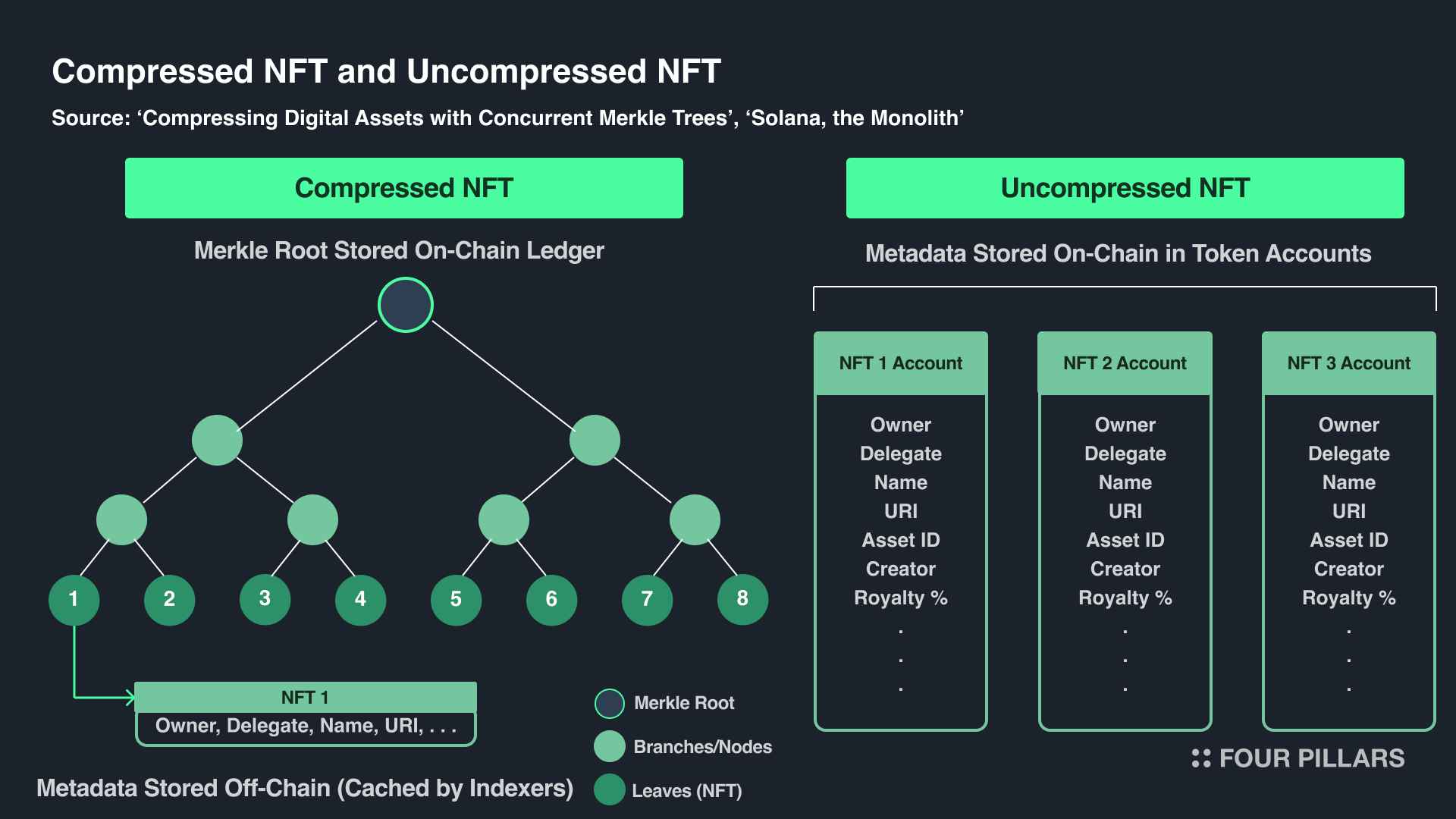
State Compression uses a Merkle tree structure to hash each asset's metadata at the leaf nodes, applying it to the structure and storing the resulting root hash at the top in the ledger. This method allows for secure data storage using cheaper blockchain ledger space instead of expensive account space, especially suitable for NFTs due to the bulk information management nature.
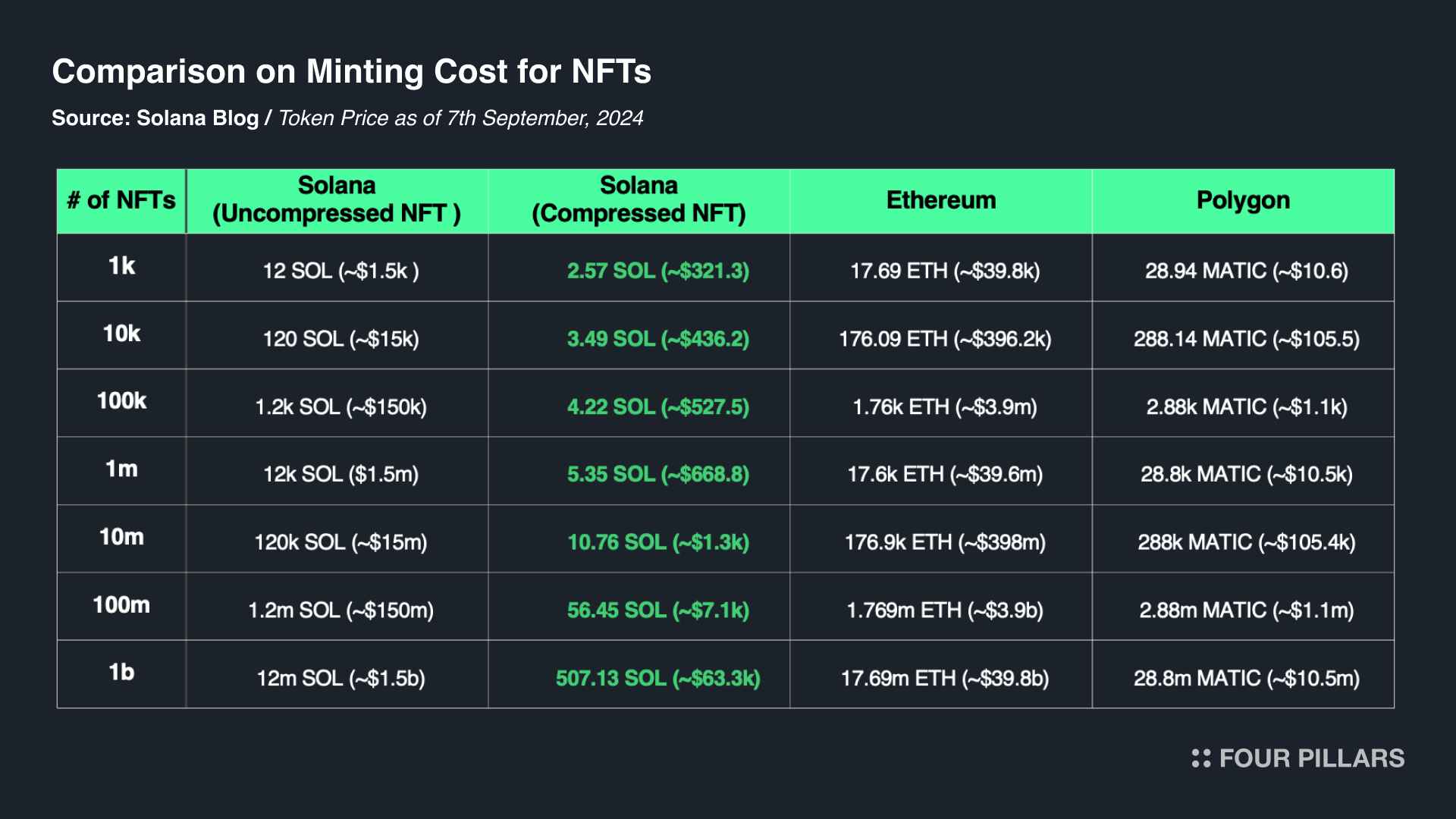
Therefore, compressed NFTs (i.e., cNFTs) follow the same metadata schema as uncompressed NFTs but are not inherently SPL tokens themselves; they only contain identifiers for potential decompression. The decompression process, turning cNFT into a standard Solana NFT, is unidirectional and enabled through Metaplex's Bubblegum Program.
However, since cNFT data is stored off-chain, a separate program defining interaction methods is needed, and this process relies on RPC providers, potentially incurring additional costs. Additionally, when attempting to modify a cNFT, the process can be complex and costly, such as requiring cryptographic proof of authority to change off-chain data.
4.3.5 ZK Compression
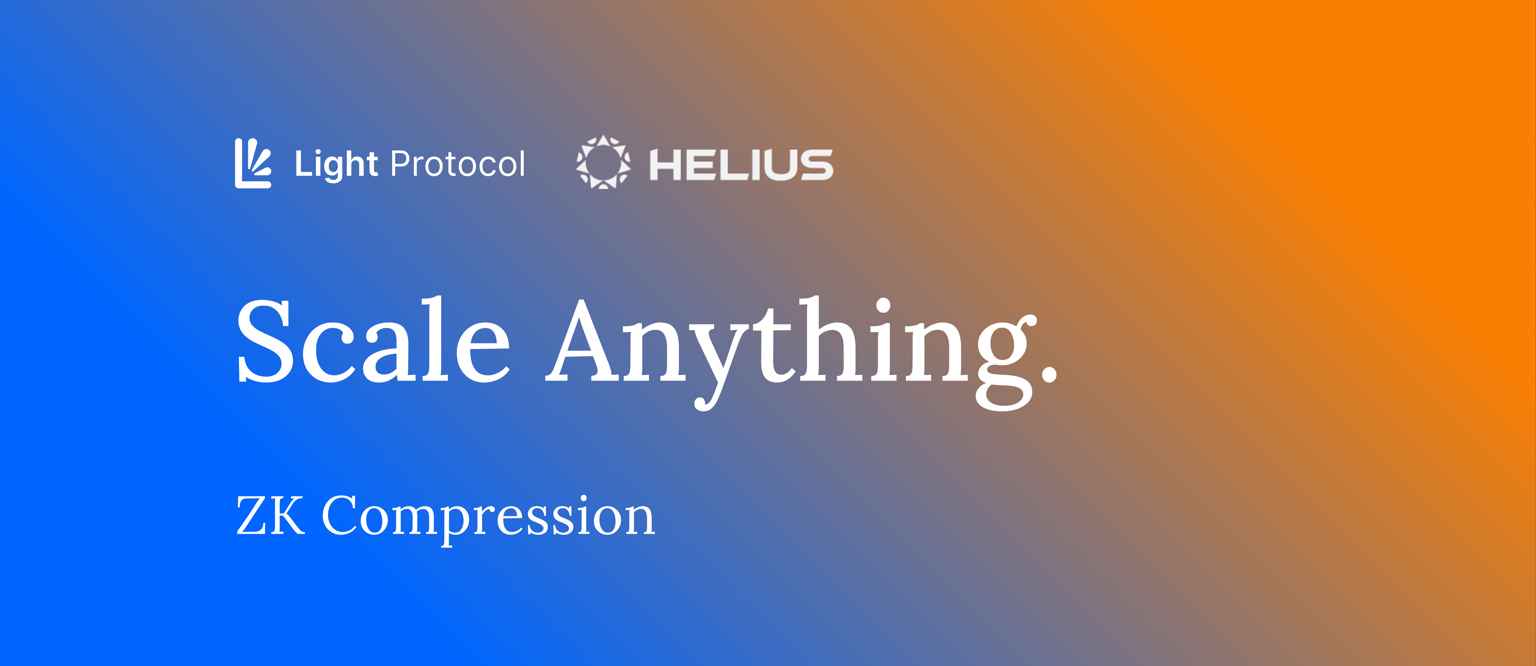
Source: zkcompression.com
ZK Compression, currently being developed by the Light Protocol and Helius teams, is a technology that combines zero-knowledge proofs (ZKPs) with state compression, which reduces the size of states. This technology aims to drastically reduce the operational costs of data and accounts on the Solana network and create an environment where more complex ZK-friendly applications, such as identity verification protocols, can be developed*. In short, while State Compression inserts a Merkle tree-based compressed state into a transaction, ZK Compression includes a ZK SNARK-based proof in the transaction**.
Like State Compression, the generation of proofs using ZK Compression can occur off-chain, but the verification of these proofs is done on-chain. Once verified, the proof is treated as a regular account and transitions the state through the relevant transaction.
*ZK Compression went live on the Solana mainnet as of September 18, 2024.
**While the size of a Merkle proof scales with log2(N), ZK-SNARK-based proofs remain constant in size, which can offer relative advantages when handling a large number of accounts.
4.3.6 SPE (Solana Permissioned Environments)

Source: solana.com
As Solana's SVM demonstrates superior transaction processing capabilities compared to other mainnets, more and more projects are emerging with the desire to build their own ecosystems based on the SVM execution environment, without needing to share composability, ledger data, or other infrastructure components of the Solana network. This architecture, commonly known as appchains, can be established either by forking the SVM in a permissionless way or in a permissioned manner.
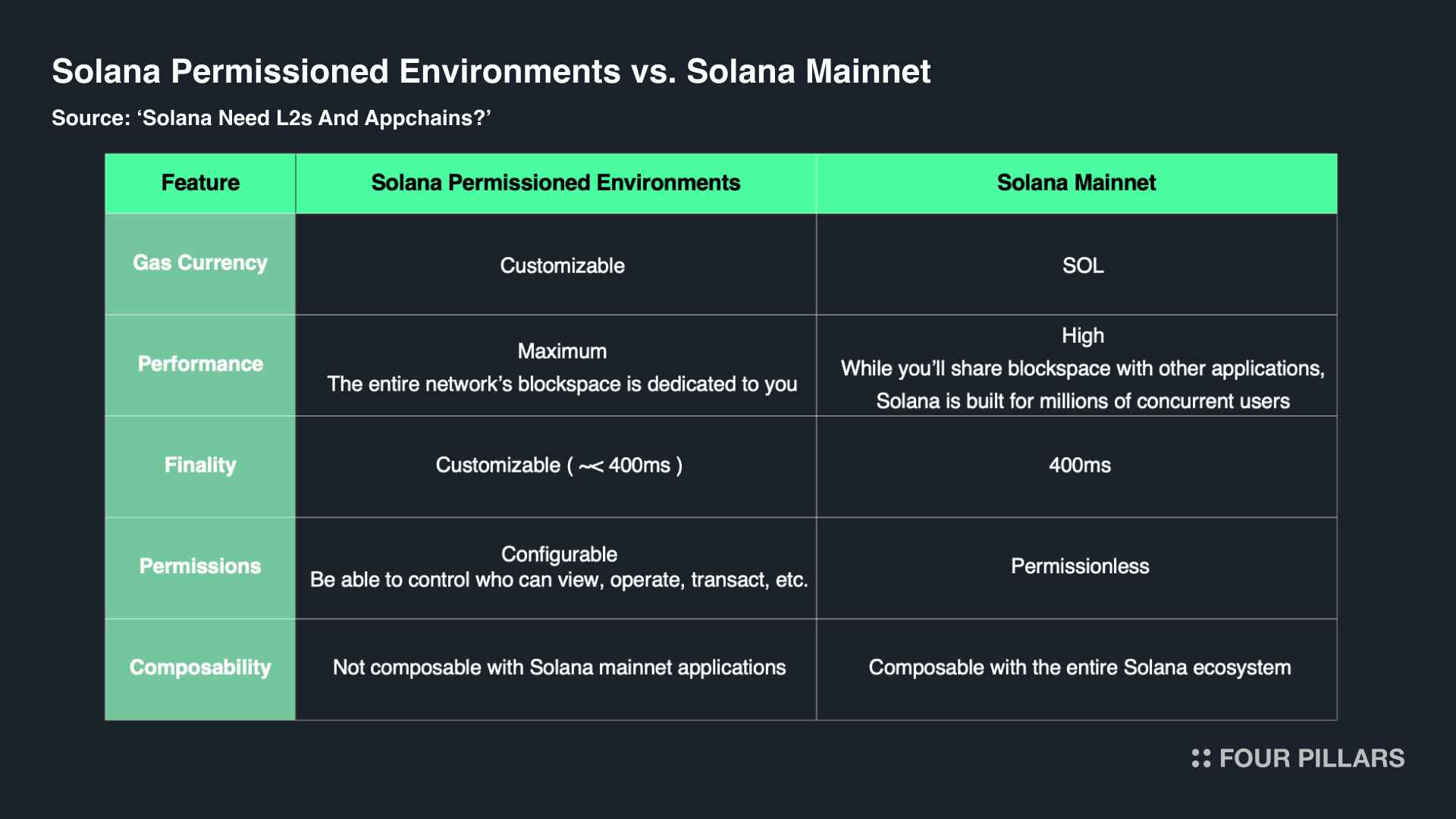
Solana supports a framework called SPE(Solana Permissioned Environments) for latter case to accommodate specific enterprise use cases, particularly those with unique business, security, and regulatory requirements. By leveraging SPE, enterprises can customize their own infrastructure stack, including consensus mechanisms, validator configurations, gas tokens, etc.
Notable examples of projects utilizing SPE include Cube.Exchange, a hybrid exchange with off-chain order matching and on-chain settlement through MPC technology; Pyth Network, an oracle solution that aggregates various financial data to provide real-time price feeds and benchmarks; and Rimark, an RWA (Real World Assets) project.
4.3.7 Solana Pay
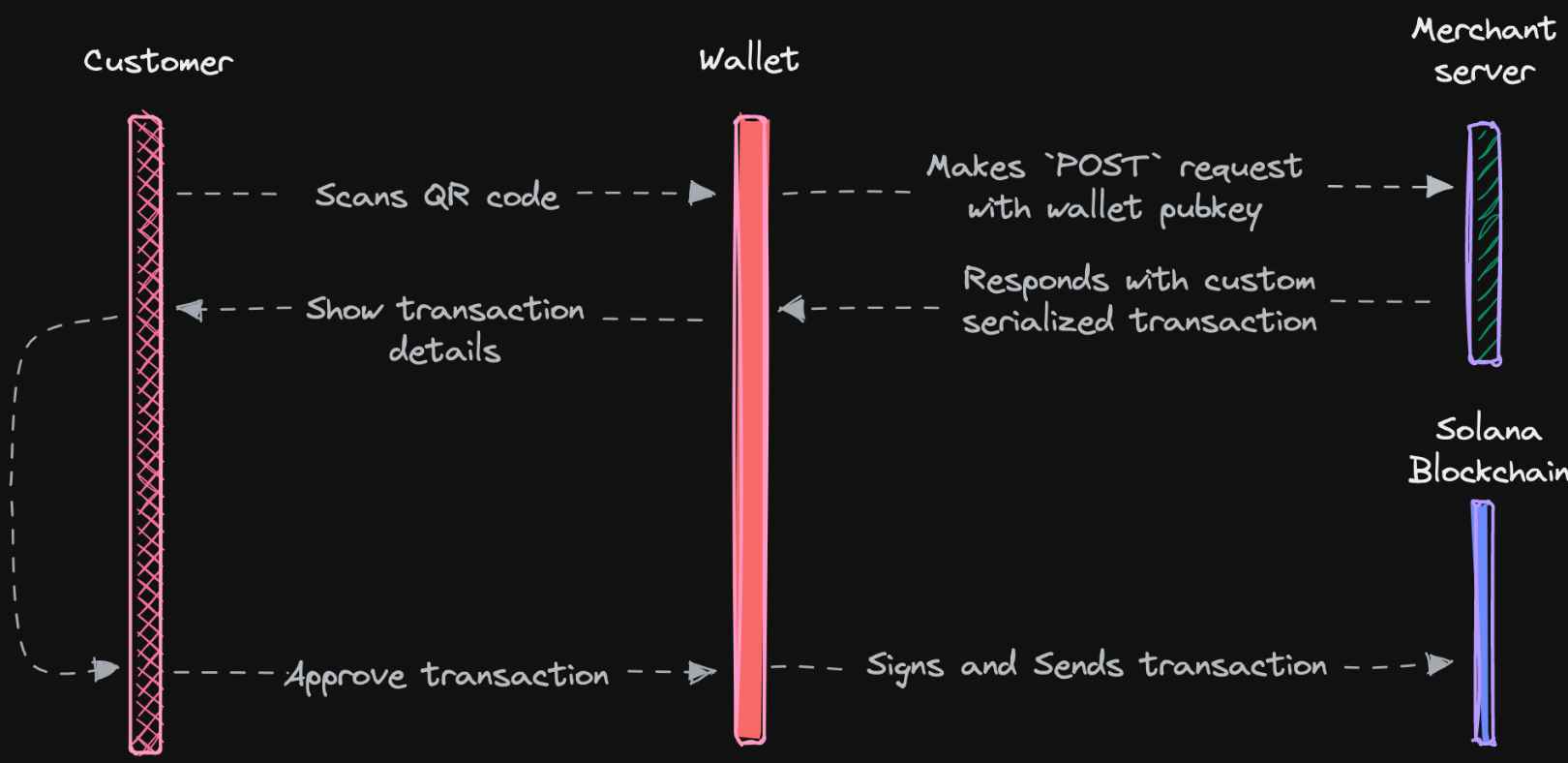
Source: Solana Pay Docs
Solana Pay, an open-source JavaScript library, simplifies cryptocurrency payments on the Solana blockchain. It uses a token transfer URL scheme to enable businesses or developers to accept payments in SOL or SPL tokens directly without intermediaries. Integration options like payment links, ‘Pay Now’ buttons, or QR codes are provided.
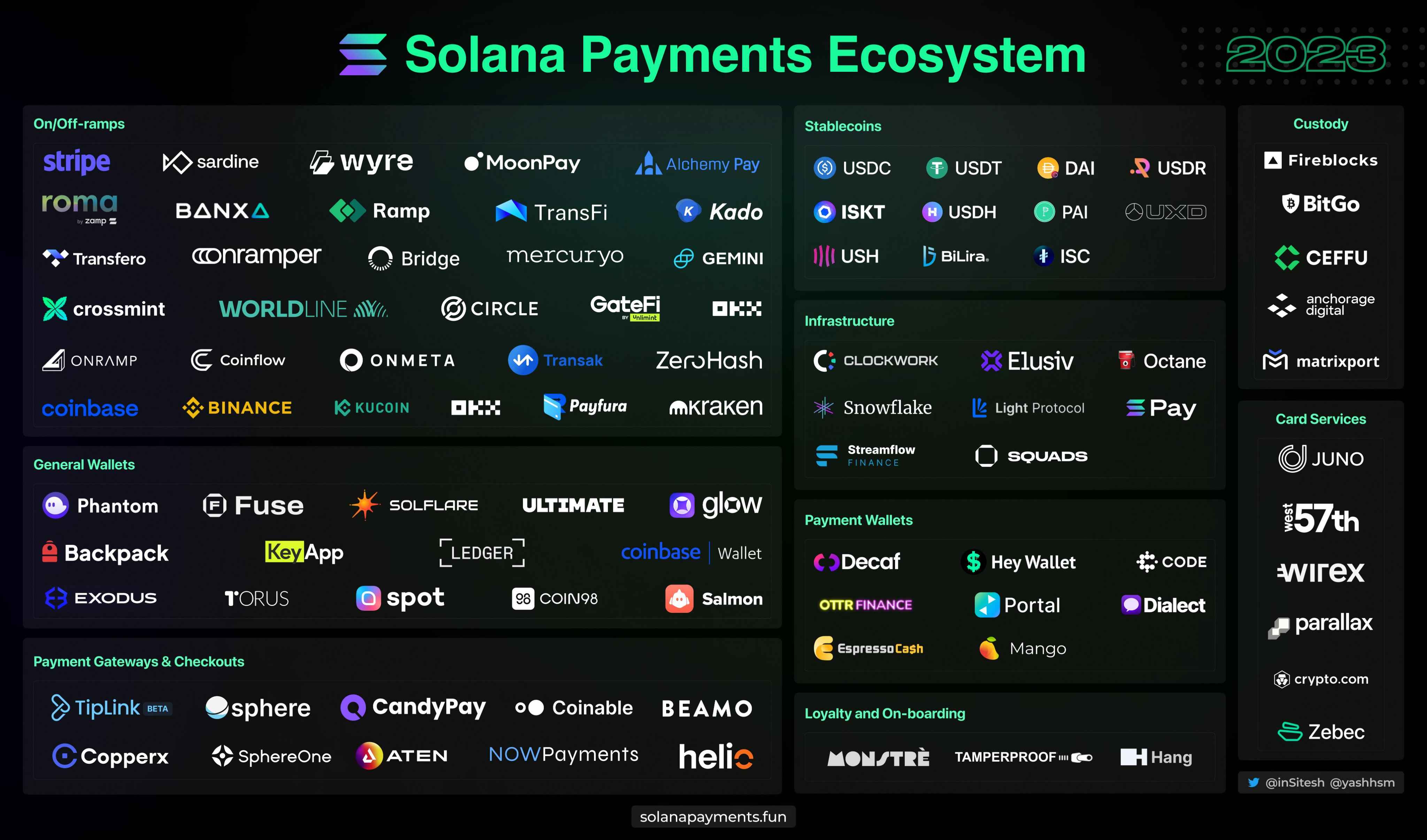
Source: Yash Agarwal
As mentioned before, Solana Pay's plugin has been integrated with Shopify, Citcon, Checkout.com, and over 100 companies/projects as well.
4.3.8 Solana Mobile Stack
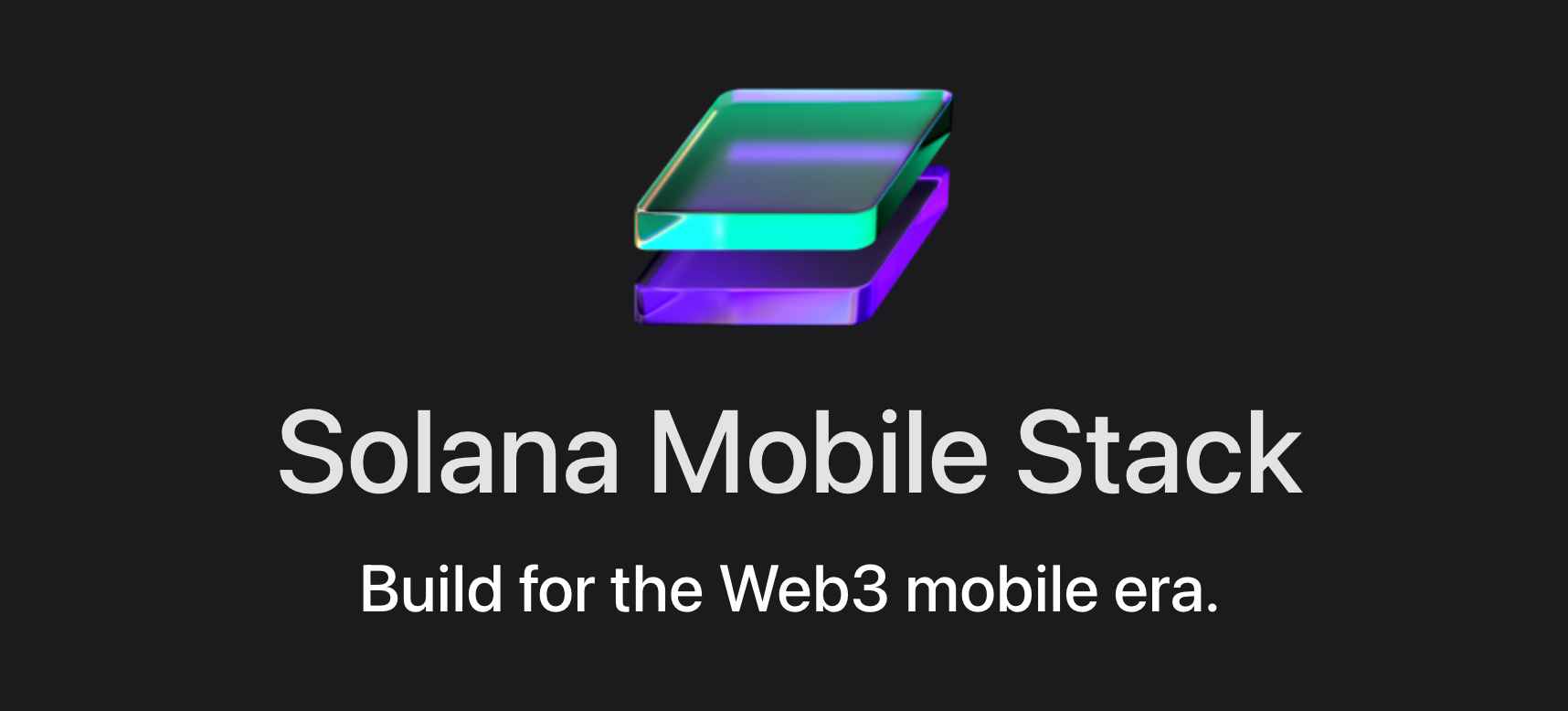
Source: SMS Docs
The Solana Mobile Stack (SMS) is an open-source SDK offering tools for developing applications on Saga & Seeker series mobile devices by the Solana Foundation. SMS consists of the following main components.
Solana dApp Store - A dApp store specialized in the distribution of decentralized applications. It enables users to easily discover and use various applications and rewards, with the ultimate goal of having the store's content primarily managed by the community.
Mobile Wallet Adapter - A standardized interface that facilitates smooth communication between applications and Solana wallets in a mobile environment. By integrating this adapter once, developers can easily connect to a variety of compatible mobile wallets. Currently, it supports Android and Mobile Web - Chrome (Android) only.
Seed Vault - Designed for use with the 'Wallet' application, this stack ensures the safekeeping of users' private keys and other important information. It allows all applications downloaded on the mobile device to utilize the same seed - the Seed Vault feature, included in the Seeker series, was developed through a collaboration between the Solflare team and the Seeker team.
Solana Pay for Android - A payment system using the Solana blockchain, enabling users to easily make payments with Solana-related cryptocurrencies (i.e., SOL, SPL) in a mobile environment. Currently, only the Android SDK is available, and it supports Solana Pay requests to be executed through QR codes, NFC taps, messages, and web browser interactions to capture the Solana Pay URL.
Beyond these stacks, the SMS Docs provide SDKs for a variety of languages/development frameworks including React Native, Kotlin, Flutter, Unity, Unreal Engine, and Solana KMP. Solana aims to popularize blockchain usage in mobile environments and promote retail finance by providing users with integrated experiences of DePIN services, DeFi applications, and Backpack, among others, through the Saga series powered by SMS.
4.3.9 Blinks (Blockchain + Links)
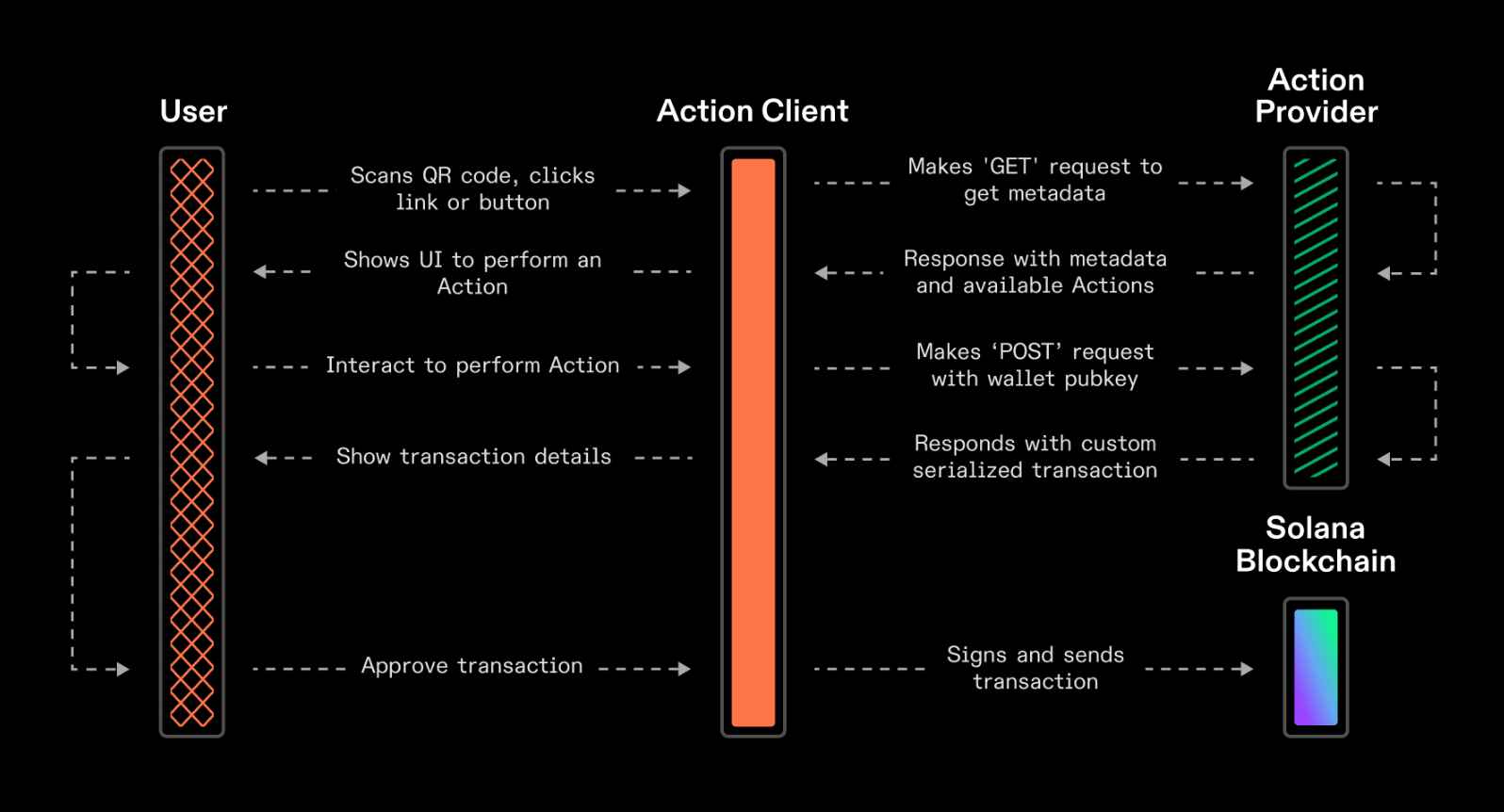
Source: Solana Docs
On June 25, 2024, the Solana Foundation announced Blinks, a combination of Blockchain and Links. Blinks defines a messaging framework for transactions that make up a series of business logic, known as the 'Actions' protocol, in the form of shareable links (e.g., URLs), enabling integration with various applications. In other words, end users can seamlessly interact with a wide range of transactions (e.g., voting, subscriptions, donations, minting, token swaps) across all websites (e.g., social media posts, mobile apps, QR codes) simply by engaging with URLs generated through Solana’s Actions and Blinks.
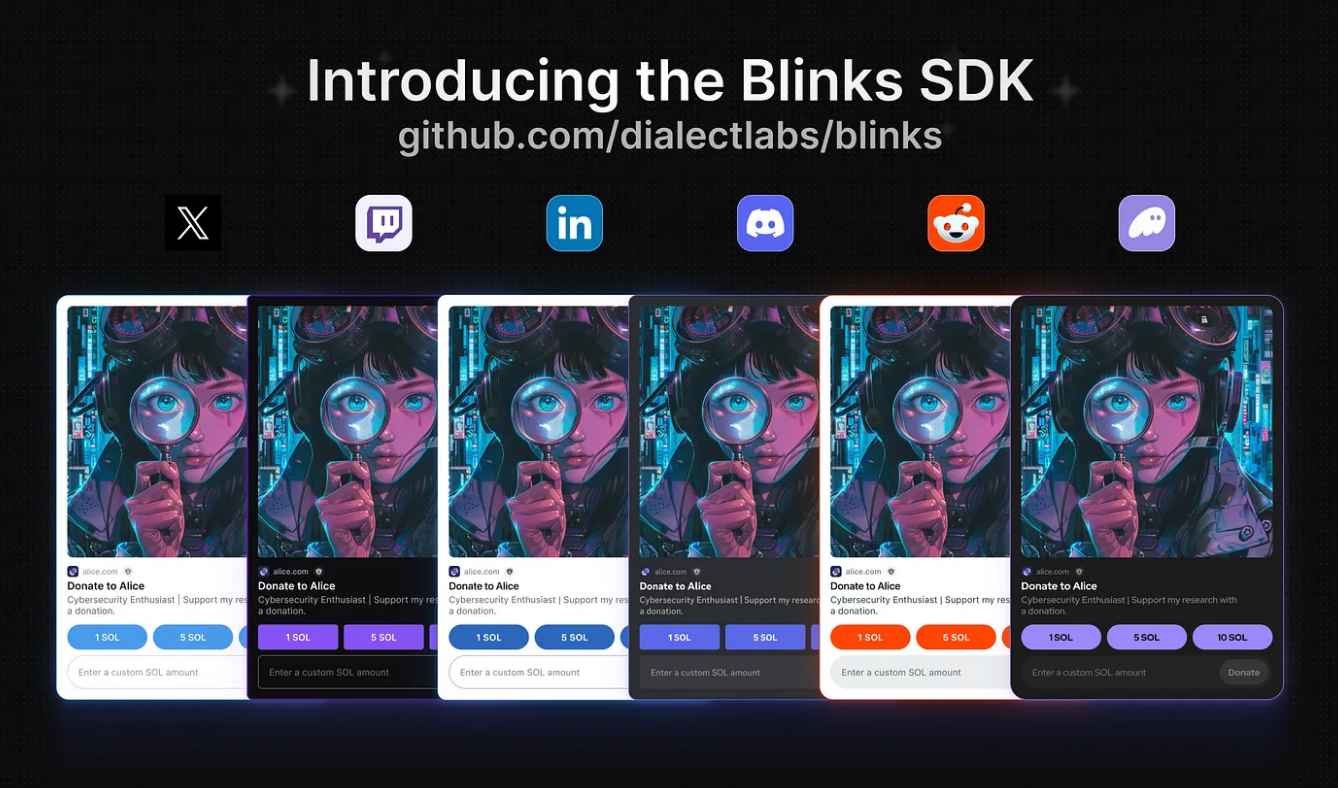
Source: Dialect Medium
Various initiatives are emerging to revitalize the Blinks ecosystem. Notable examples include Blnk.fun, which allows users to easily build and trade Blinks without coding, and SEND, a community-based platform aimed at exploring various applications of Blinks and fostering the ecosystem - the Blinkathon organized by the SEND team, held from August 26 to 31, saw participation from 70 teams across 10 tracks.
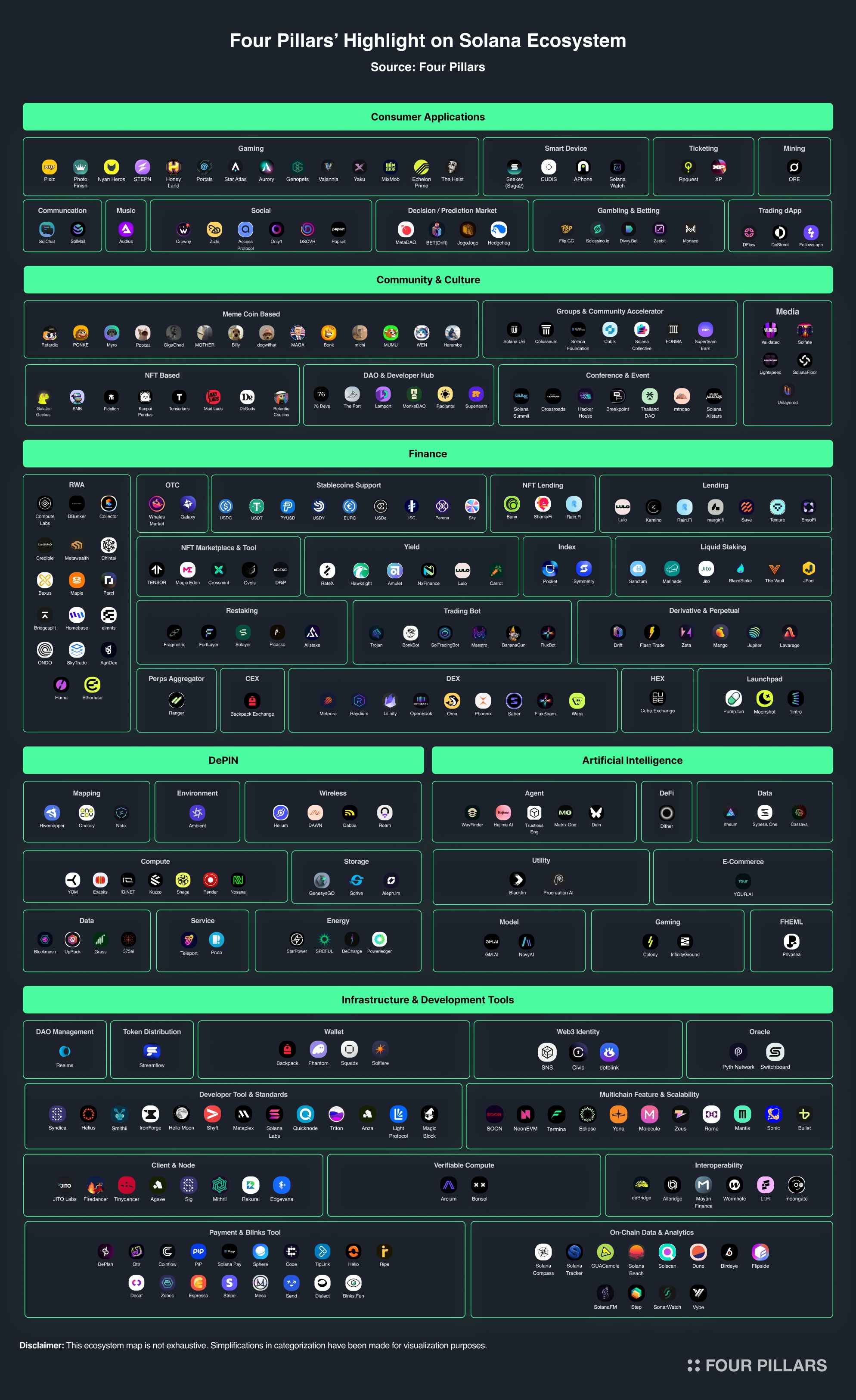
There is a close correlation between the level of development in Internet infrastructure and the emergence of various applications. In the early days of the internet, limited bandwidth and inefficient network communication standards led to long web page loading times and reduced user accessibility to multimedia content. In this environment, developments focused on simple web applications and text-based information exchange were predominant.
However, with the introduction of broadband internet and the advancement of data network standard technologies, the data processing efficiency of the internet has improved dramatically. This enabled the implementation of applications with diverse functions and capacity to process large amounts of data, leading to the emergence of various high-bandwidth applications such as video streaming platforms like Netflix, online gaming, large file sharing, real-time communication, and collaboration tools. In other words, as the internet infrastructure developed, it promoted the development of new applications and services, fundamentally changing how people consume digital content.
We seem to be experiencing this momentum once again with Solana - over the past four years since its mainnet launch, Solana has rapidly evolved into an ecosystem with over 700 decentralized applications. This is thanks to its steady improvement of network throughput and consumer/developer-friendly features while gradually improving moderate decentralization. As a result, Solana's ecosystem is not only vast but also offers applications with utility that is relatively ahead of those in other ecosystems.
In this Solana ecosystem roundup section, our goal is to provide an insightful overview of the rapidly evolving Solana ecosystem by categorizing and curating about 300 of the most active projects, ranging from infrastructure layers to consumer applications.
Ecosystem projects are categorized into six groups: ‘Infrastructure & Development Tools,’ ‘Finance,’ ‘Decentralized Physical Infrastructure Networks (DePIN),’ ‘Artificial Intelligence (AI),’ ‘Consumer Applications,’ and ‘Community & Culture.’
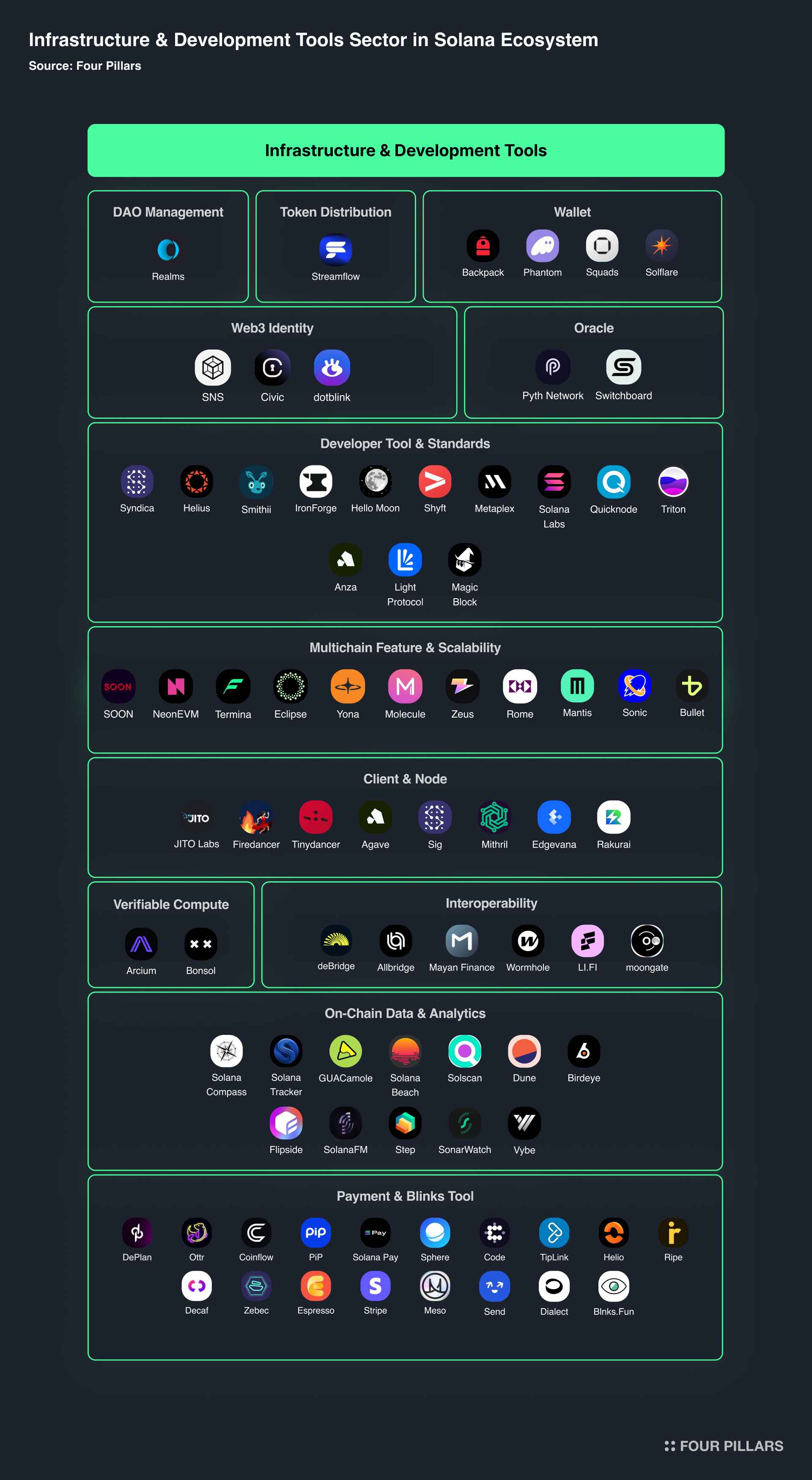
The key factor that has the greatest impact on the performance and synergy of applications across Solana's ecosystem, which places composability as a top priority, is the variety of infrastructure technologies being developed at the protocol level. Beyond the SVM technology stack for transaction processing, Solana's rich toolkit, libraries, and set of standards empower developers to build diverse applications while leveraging the platform more efficiently and effectively.
Notable examples (which overlap significantly with those discussed in Section 4) include Solana Program Library, a library that includes various functions such as token creation and management (SPL token program), token swaps, and lending protocols; Anchor Framework, which is the most popular development framework, especially for developers new to Solana or those who want to prototype and deploy applications quickly; and GameShift, a framework designed to simplify the process of creating blockchain-based games. Furthermore, standard collections like Token Extension and Compression technologies (e.g., State Compression, ZK Compression) eliminate communication inefficiencies, enabling the implementation of applications that need to process large amounts of data or implement complex logic.
In terms of usability, particularly noteworthy are the Payment-related API modules, which are JavaScript libraries that simplify cryptocurrency payments, and the Blinks (Blockchain + Links) solution, which defines on-chain transactions in the form of URLs, allowing them to be integrated and utilized in various applications.
From a network stability perspective, various initiatives are underway, including not only clients from Agave and Jito Labs, but also Firedancer, Tinydancer, and Sig. Additionally, efforts to make the SVM execution environment more flexible in a multichain context through SPE(Solana Permissioned Environments) or various protocols(e.g., modular stack, L2) are becoming increasingly apparent. These efforts aim to allow individual products to build their own ecosystems or enhance the efficiency of existing ones.
Below is a list of some projects in the 'Infrastructure & Development Tools' sector that are worth paying close attention to regarding the future development of the Solana ecosystem.
Coral, the company behind the Anchor development framework, has created the Backpack wallet and Mad Lads collection, both of which are iconic representations of scalable technology and a virtuous community within the Solana ecosystem. Both products are implemented as xNFTs, literally 'executable' Web3 application asset standard plugins.
The Backpack wallet was launched to enable users to experience various dApps implemented as xNFTs within an integrated environment. It currently provides a seamless user experience for the xNFT versions of about 90 applications spanning across various sectors, including gaming, NFTs, and DeFi.
Phantom and Solflare are the most widely used wallets in the Solana ecosystem. Phantom wallet is particularly known for its user-friendly interface and NFT management features in a mobile environment, while Solflare wallet is renowned for its sleek interface in the web environment and focus on security aspects.
At the recent Breakpoint event, Phantom announced updates to its "Embedded Wallet," including features like seed phrase-free sign-ins and Universal Phantom Accounts. Meanwhile, Solflare played a key role in implementing the Seed Vault feature for Seeker Mobile, which is set to launch in the first half of 2025.
Squads is a custody layer solution that enables safer asset management and operation, providing standards for various smart accounts, including asset management, permission settings, and multi-signature.
The Squads Labs team has launched the first smart wallet in the Solana ecosystem, Fuse Wallet, in its iOS version. Fuse Wallet offers features such as 2FA, spending limits, social recovery, timelock, key rotation, gas abstraction, and native staking. Recently, they launched Fuse Pay, a virtual Visa card for payments.
Additionally, the Squad team has announced Squads Policy Network (SPN) to enable enterprises to manage centralized custody in a trustless and decentralized manner. SPN, integrated with Jito (Re)staking, will offer custom and general-purpose policies available to all users.
Pyth Network is an oracle network providing real-time primary financial market data essential for DeFi services on the blockchain. It currently collects data from over 90 first-party data providers and offers real-time price feeds for crypto assets, stocks, ETFs, and commodities to developers on over 40 blockchains.
In the future, Pyth Network plans to introduce an Oracle Integrity Staking (OIS) delegation mechanism, which will reward Pyth stakers while enabling the network to secure high-quality data from publishers for DeFi projects.
Switchboard is a decentralized, customizable oracle network that enables developers to build custom oracles, securely connecting off-chain data to on-chain applications. It also helps developers reduce costs by providing data only when needed and ensures the security and integrity of the data using TEEs.
Code SDK is an open payment protocol and app that allows developers to easily receive micropayments from users worldwide - anyone can provide an experience of charging small amounts to users in a web environment through the "Pay with Code" button, where users need a 5 cent fee, and developers need a fixed 1 cent fee to cover blockchain transaction costs.
The Code team has been leveraging this technology to build various consumer products as well - they launched a micro-payment product called Tip Card (physical / digital) and also introduced Pennypost, a content platform that allows users to support individual articles written by creators.
Dialect provides a development stack for a decentralized messaging protocol built on the Solana network. Recently, it launched Blinks (Blockchain Links) in collaboration with the Solana Foundation. The Dialect team is currently responsible for key updates to the Blink Client SDK and supports numerous Blink developers.
Sphere Labs is a settlement project that won the Solana Summer Camp Hackathon in December, providing various features including crypto on/off-ramp, on-chain subscriptions, invoices, payment links, AML/Fraud prevention, and reports. Recently, they introduced SphereNet, a high-performance virtual machine initiative aimed at bridging the gap between regulatory-compliant institutions and blockchain.
TipLink is a lightweight, non-custodial wallet that allows easy transfer of digital assets via links or QR codes. In other words, users can create a wallet immediately by simply connecting their Gmail account or Solana wallet to the received link or QR code, and can use the assets received through this link wallet.
Anza team is a software development company focused on building the Solana ecosystem. The team includes many core engineers from Solana Labs and aims to make the SVM ecosystem more widely adopted through various initiatives for client diversification (i.e., separate client development (i.e., Agave) and support (e.g., Firedancer, etc)) and contributions to other major protocols within the Solana ecosystem (e.g., Token Extension, Solana Platform Tools & SDK, etc.).
Helius is a platform that enables stable blockchain application development by providing APIs, RPC nodes, webhooks, and different developer tools to Solana ecosystem developers.
Light Protocol is a team building the ZK Layer in the Solana ecosystem. They developed ZK Compression with the Helius team.
Metaplex is a representative library that provides various tools to facilitate the series of creation-sale-management processes for digital assets in the Solana & SVM ecosystem, including Ownership expression, Permission management, Compressed NFTs creation, deployment management, etc.
Depending on the extent of utilization of each Metaplex tool, a certain portion of protocol fees can be variably collected. Half of these collected protocol fees go to the Metaplex DAO treasury in the form of $MPLX (Metaplex's utility and governance token), and the other half is used by the non-profit Metaplex Foundation for the purpose of continuous development, security, governance, and management of the Metaplex DAO.
Meanwhile, the Metaplex team recently launched an indexing and data availability network called Aura Network. This network allows users not only to easily store and retrieve data, but also to flexibly manage the state within the Solana and SVM ecosystems, and perform multi-program consistent indexing via the enhanced Digital Asset Standard (DAS) API.
Established in 2018, the Solana Labs team is responsible for continuously developing and supporting the overall core technology stack for Solana, from basic infrastructure design to clients and token standards (e.g., Token Extension), with the goal of ensuring that the Solana network operates in an optimized and efficient manner.
Syndica is an infrastructure provider for the Solana ecosystem, offering scalable RPC node services and a variety of developer tools. Notably, Syndica is developing the ChainStream API, which enables real-time streaming of Solana blockchain data, and Sig, a validator client being built using the low-level programming language Zig.
Wormhole is a multi-chain bridge protocol born through a partnership between Solana and Certus One, enabling message and asset transfer between multiple blockchains, including Solana. In particular, Wormhole's wrapped assets are the most liquid on Solana, and Wormhole's main goal is to overcome the liquidity fragmentation problem in the blockchain ecosystem and build an integrated environment where assets and information can move freely between different networks.
To this end, Wormhole adopts a native token transfer (NTT) framework that adopts a burn-and-mint mechanism, Circle's CCTP, etc., and plans to enhance decentralized operation by strengthening multi-chain governance functions through the recently launched $W token.
Eclipse is an Ethereum Layer 2 based on SVM that uses Ethereum as the settlement layer. It also utilizes Celestia as a data availability solution and RISC Zero's zero-knowledge proofs for proving. Through this, Eclipse aims to maximize verifiability while ensuring high performance that can process as many transactions as possible.
Neon EVM is a project that enables the Ethereum Virtual Machine (EVM) to run on the Solana blockchain. The goal of this project is to allow Ethereum-based applications and smart contracts to leverage Solana's advantages, such as fast transaction speeds, low fees, and parallel processing. Through Neon EVM, Ethereum developers can easily migrate their existing Ethereum applications to the Solana network. Neon EVM can access data stored in Solana accounts, and all (pseudo) Ethereum accounts within Neon EVM are stored in the corresponding Solana accounts.
The core idea behind Rome Protocol is to enhance the transaction processing efficiency of rollups by leveraging Solana as a shared sequencing layer for them. In other words, Solana sequences and executes transactions from various rollups on Ethereum (or Celestia), while Rome updates the state of each rollup based on these processed transactions and ensures they are committed on Ethereum (or Celestia).
SOON (Solana Optimistic Network) aims to provide the most efficient transaction settlement on any Layer 1 through a high-performance rollup stack based on the Solana Virtual Machine (SVM). Its key offerings include the SOON Stack, a modular framework combining SVM and OP Stack, and SOON Mainnet, a universal SVM Layer 2 to be deployed on Ethereum.
Within the Solana ecosystem, we're seeing instances where new projects are being built using SVM appchains, rollups, and sidechains. These approaches leverage Solana’s execution environment while maintaining flexibility in setting up block creation, blockspace, transaction sequencing, and state management systems.
Termina, developed by Nitro Labs, offers an SVM cloud platform service that enables these projects to optimize and configure their tech stacks accordingly.
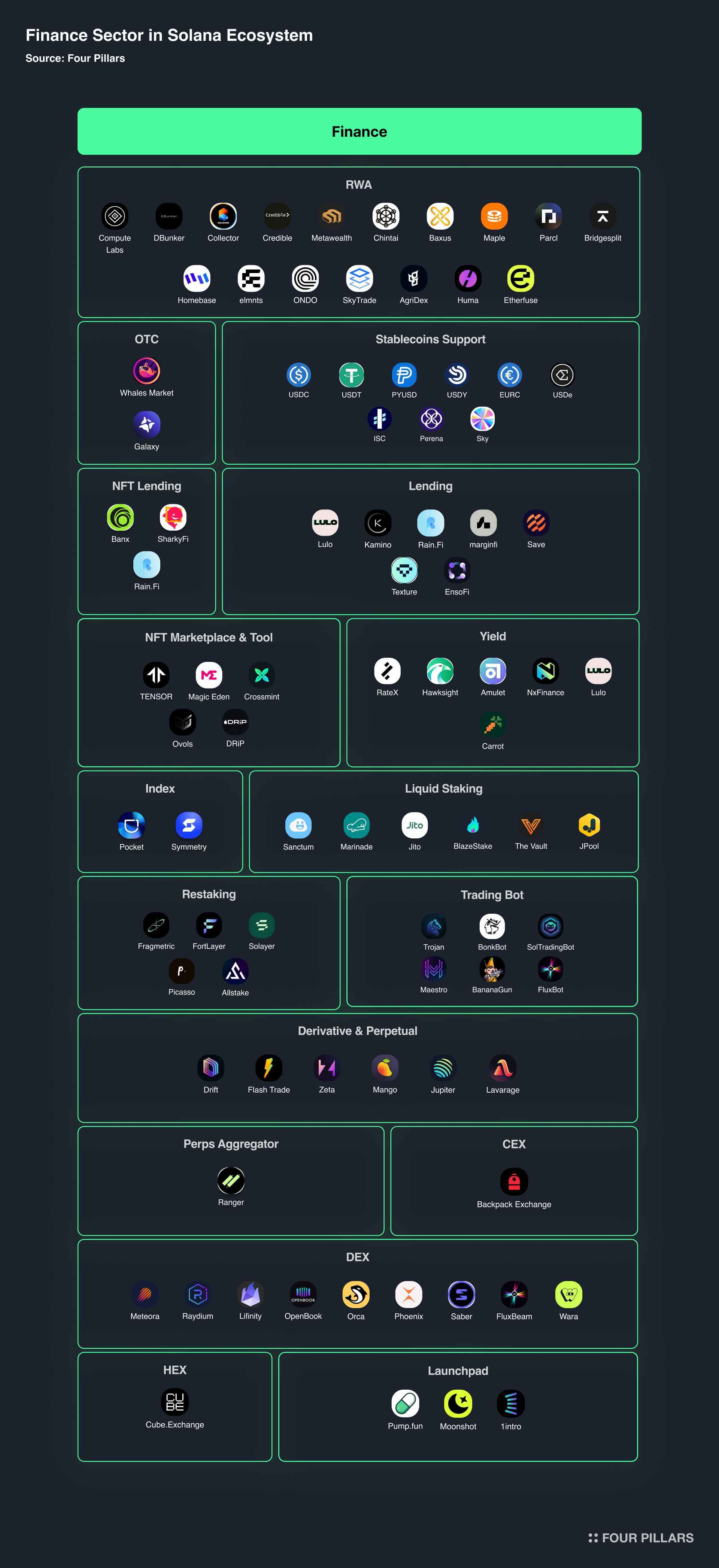
Solana is best known for pioneering retail-focused areas such as DePIN, Mobile, and Payments, but it is also making significant strides in the Finance sector - as previously mentioned, PayPal successfully onboarded PayPal USD (PYUSD) onto Solana at the end of May, joining other financial institutions like Visa, WorldPay, and Stripe. And more recently, Libre Capital launched an institutional fund for Solana, utilizing Token Extension.
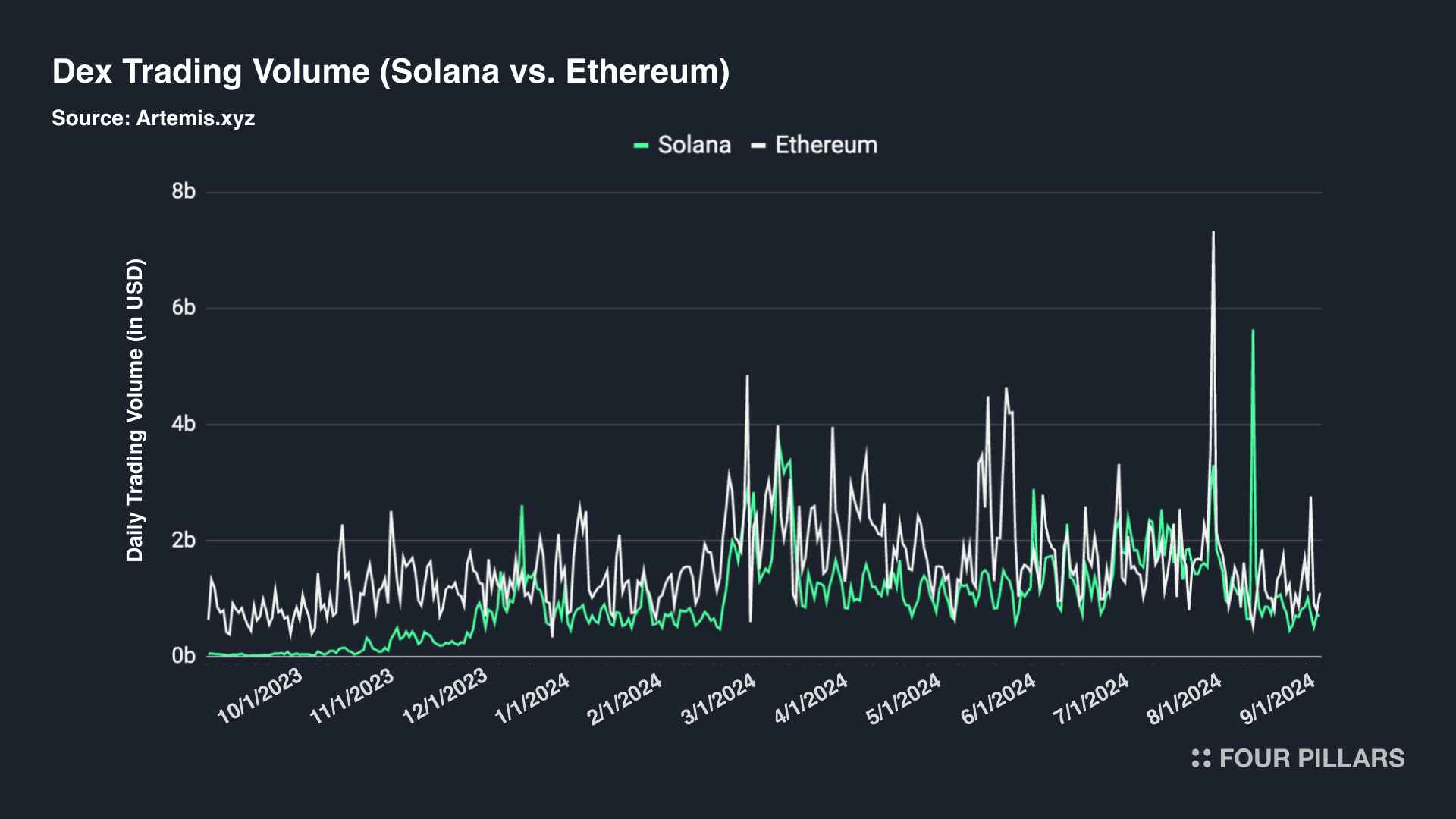
Solana's individual DeFi sector is also showing strong growth. Solana's DEX platforms have maintained high trading volumes throughout the year, at times even surpassing Ethereum's. Notably, Jito has emerged as a leading LST protocol, significantly increasing the amount of staked SOL - currently, around 13 million SOL are staked on Jito. In addition, with various LST and restaking initiatives like Sanctum, and the upcoming launches of Solayer and Fragmetric gaining traction, along with the onboarding of Coinbase's native cbBTC onto the Solana network, the synergy within Solana's DeFi ecosystem is expected to grow even stronger.
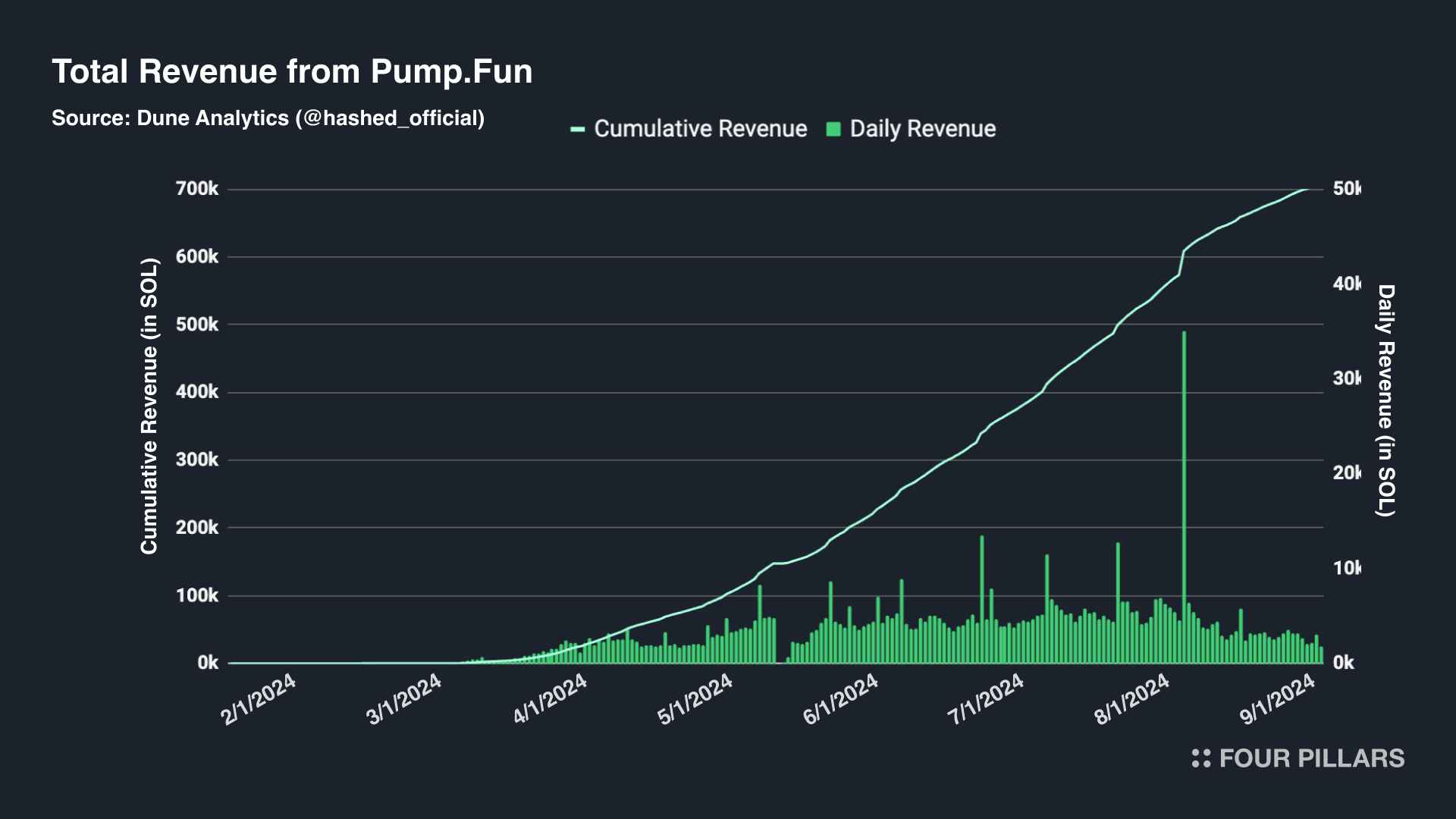
One of the most notable success stories in the finance sector this year is undoubtedly Pump.Fun, a meme coin launchpad on Solana. Pump.Fun is a platform that allows users to easily create meme tokens, effectively capturing the massive speculative demand for meme coins from a wide range of retail investors - since its launch in January 2024, Pump.Fun has grown rapidly, becoming one of the top 10 protocols across all blockchain ecosystems in terms of fees and revenue. In just about seven months, the total fees/revenue generated by the platform surged from a modest 8 SOL on February 2, 2024, to a staggering 700,675 SOL as of September 7, 2024.
Of course, there are often opinions that Solana's DeFi ecosystem is limited to meme coin trading, but in reality, this can be seen as a strength rather than a weakness. Not only does it demonstrate how well Solana's cult-like culture has taken root, but it also proves the network's ability to handle a high volume of transactions, thanks to its high throughput and low latency.
Below is a list of some noteworthy projects in the ‘Finance’ sector to keep an eye on in the future, in addition to those mentioned above.
Compute Labs and DBunker are spearheading a new sector at the crossroads of Real-World Asset (RWA) tokenization and Decentralized Physical Infrastructure Networks (DePIN), known as DePINFi. They aim to reduce barriers to entry in AI Compute and DePIN by reducing high initial capital costs, the need for specialized expertise, and the complexities of managing physical infrastructure.
Compute Labs does this by transforming GPUs into GNFTs (GPU Non-Fungible Tokens), via its Compute Tokenization Protocol (CTP). The protocol effectively financializes computing hardware which can then be deployed in various DeFi activities, unlocking new value and a market with GPU as an asset class.
DBunker simplifies DePIN by tokenizing physical mining hardware through its platform, creating digital assets representing shares in physical mining equipment, allowing users to participate in DePIN without the complexities of managing physical infrastructure.
Etherfuse is an RWA platform that leverages blockchain technology to tokenize real-world assets, particularly sovereign debt from emerging markets. Its goal is to expand access to financial markets and increase liquidity, focusing on debt from these regions. Recently, Etherfuse secured $3 million in funding and is planning to tokenize more assets, including those from the Mexican Stock Exchange. Additionally, it has plans to expand into markets in Spain, Switzerland, and Dubai.
Parcl is a decentralized real estate exchange built on Solana that allows users to trade and speculate on global real estate market prices. This is possible through Parcl's City Index, which tracks the median price per square foot or meter in various cities, offering users exposure to entire city real estate markets rather than individual properties.
ISC (International Stable Currency) is a stablecoin project built on Solana, aiming to provide users with a stable, internationally recognized currency that can be used both online and offline. Unlike traditional stablecoins pegged to fiat currencies like the US dollar, ISC is linked to real assets such as commodities, bonds, and stocks, offering inflation-resistant characteristics.
Perena aims to enhance the usability, liquidity, and rewards of stablecoins within DeFi, where its mission focuses on facilitating frictionless exchange of dollar-pegged assets and maximizing yield generation for idle stablecoin liquidity. Perena’s stableswap product, Numéraire, is a decentralized exchange for stablecoin swaps, incentivizing deep liquidity and benefiting both liquidity providers and the overall market.
Sky, formerly known as MakerDAO, is a DeFi protocol planning to expand into the Solana DeFi ecosystem by integrating its USDS (stablecoin) and SKY (governance token) through Wormhole. Recently, they announced an incentive program aimed at bootstrapping and activating the Solana DeFi ecosystem, allocating 2 million SKY tokens per week.
PayPal USD (PYUSD) is a stablecoin issued through a partnership between PayPal and Paxos. Like $USDT and $USDC, it is backed 1:1 by cash and cash equivalents held at banks insured by the Federal Deposit Insurance Corporation (FDIC). PayPal has announced a strategic partnership with Solana to leverage its fast finality, low fees, and Token Extension to develop the next generation of digital payments.
Drift Protocol is a decentralized trading platform built on Solana, with its V2 upgrade focusing on improving order execution speed and market efficiency. Users can engage in various activities such as spot trading, perpetual trading, borrowing and lending, and passive liquidity provision in real-time updating markets. Recently, it also launched a prediction market called “BET”.
Jupiter is the leading DEX Aggregator on Solana, providing the best and cheapest routes for trading on Solana. The platform primarily offers features such as limit orders, futures trading, dollar-cost averaging (DCA), fiat on-ramp, and bridging. In addition, Jupiter offers or plans to offer various features, such as - 'LFG Launchpad,' which has supported the launch of protocols like Sanctum, Zeus, and SharkyFi; 2) ‘Ape.Pro,’ a feature that simplifies the minting and trading of new tokens, as seen with Pump.fun; and 3) ‘easy on-ramp mobile integration’ through solutions like Apple Pay, credit cards, and Google Pay."
Zeta Markets is a decentralized derivatives trading protocol built on the Solana blockchain. It offers under-collateralized options and futures trading, allowing traders to buy and sell options and futures through an order book system.
At the recent Breakpoint, Zeta announced its testnet (Q4 2024) and mainnet (Q1 2025) schedule as the first super app on Bullet, a zkVM-compatible Layer 2 solution.
Jito, as previously mentioned, operates a client called Jito-Solana, designed to maximize MEV (Maximal Extractable Value) profits. They are rapidly expanding their share in the Solana ecosystem's liquid staking market through a Liquid Staking Token (i.e., JitoSOL) that allows them to share the profits generated by their MEV solution. Similar to Lido's approach of running their protocol in a permissionless manner, Jito also plans to apply a permissionless model to the operation of the JitoSOL pool via StakeNet. In July, they released the code for their staking and restaking programs as a open-source.
Marinade Finance is a liquid staking platform that allows users to delegate their SOL tokens to Marinade, in return for shadow tokens (i.e., mSOL) that can be utilized across various DeFi protocols. At the recent Breakpoint, Marinade previewed its V2 update, which includes improvements to smart contract risk, validator performance, and the introduction of a stake pool marketplace. It also expressed its ambition to enable a wide range of participants, from retail users to institutions, to engage in a more efficient Solana staking market.
Sanctum is a solution that allows all Liquid Staking Tokens (LST) projects within the Solana ecosystem to share liquidity with each other, allowing for seamless interactions between each LST (e.g., zero slippage), or users can also earn revenue by supplying liquidity of a specific LST to the Sanctum Infinity pool. In addition, Sanctum is planning to add two more products related to PayFi - 1) Creator Coins, which will enable organizations and individuals to easily build, grow, and monetize their communities, and 2) Cloud Card, a card product line that allows users to utilize SOL and various stablecoins in over 100 countries.
Kamino is a DeFi platform that combines various financial activities into one, where users can strategize to maximize earnings through lending/borrowing, liquidity provisioning, leveraging provided liquidity, and portfolio management. Along with marginfi, Kamino records the highest TVL among Solana's lending-supporting protocols.
The marginfi protocol is a decentralized lending protocol on the Solana network. Its product suite includes mrgnlend, an over-collateralized lending/borrowing protocol. Beyond typical lending activities, marginfi protocol aims to enable users to engage in integrated financial activities with various DeFi protocols as a ‘Composable DeFi-Native Protocol’.
Fragmetric is the first liquid restaking protocol in the Solana ecosystem, aiming to enhance the liquidity and composability of staked assets. Its main product, fragSOL, is a Solana-native LRT (Liquid Restaking Token) based on Jito's Restaking Vault Receipt Token (VRT) system.
Solayer is a leading restaking marketplace within the Solana ecosystem. Solayer focuses particularly on enhancing network bandwidth and enabling on-chain dApps to secure higher transaction priority and block space. Recently, as part of a partnership with OpenEden Labs, it was announced that support would be provided for restaking SUSDC, a yield-bearing stablecoin.
FluxBeam is the first decentralized exchange (DEX) that supports trading of all types of Solana tokens, including SPL, SPL404, and SPL22. Users can perform token swaps, provide liquidity, and bridge assets as basic functions. In addition, FluxBeam offers token creation and management tools, enabling developers and users to easily handle tokens within the Solana ecosystem. It also provides a Telegram trading bot called FluxBot, which includes features like token sniping, copy trading, etc.
Developed by the Ellipsis team, Phoenix is a new order book-based DEX aiming to provide an entirely on-chain, instant settlement trading experience. It is in a competitive relationship with OpenBook, a community fork of Serum V3, as they offer similar services. OpenBook places a bit more emphasis on community governance and control.
DRiP is an NFT drop platform for creators, supporting new artists to join Solana easily and affordably. New artists seeking to build a fan base can issue their works as cNFTs and offer free NFT art mints through DRiP. Users can follow their favorite artists, send thank-you notes, or donate through Droplets 2.0.
Magic Eden is the dominant NFT marketplace on Solana, and supports a multi-chain environment including Ethereum, Polygon, and Bitcoin Ordinals, offering launchpads for each project or BTC Inscriptions. The launch of the ME token, designed to support and encourage the trading of different assets across various chains, is scheduled in the near future.
Tensor is a platform tailored for professional NFT traders on Solana, integrating AMM and marketplace functionalities. Users can access real-time data, candlestick-priced AMMs for NFTs, and employ various trading strategies, including mass acquisition, bidding, listing/delisting of NFTs. Alongside these features, Tensor conducts various reward programs for retail users, competing with Magic Eden for the top NFT marketplace position.
Recently, Tensor announced the full open-sourcing of its code, a grant program, a restructuring of its fee model, and the preview of a new product line called vector.fun.
BonkBot is a Telegram trading bot that uses its own routing logic, developed in collaboration with Jupiter, a Solana-based DEX aggregator, to find the best token prices across various DEXs on Solana. BonkBot is particularly useful for trading meme coins and small tokens.
Cube.Exchange is a leading hybrid decentralized exchange (HEX) that provides efficient, secure, and compliant trading experiences by leveraging Multi-Party Computation (MPC) technology to combine off-chain order matching with on-chain settlements. After the recent Breakpoint announcement period, the team revealed plans to launch Isometric Network, an intent-based network, built upon the technology stack previously applied at Cube.Exchange (i.e., MPC, two-tiered validator consensus, multi-chain settlement, etc.).
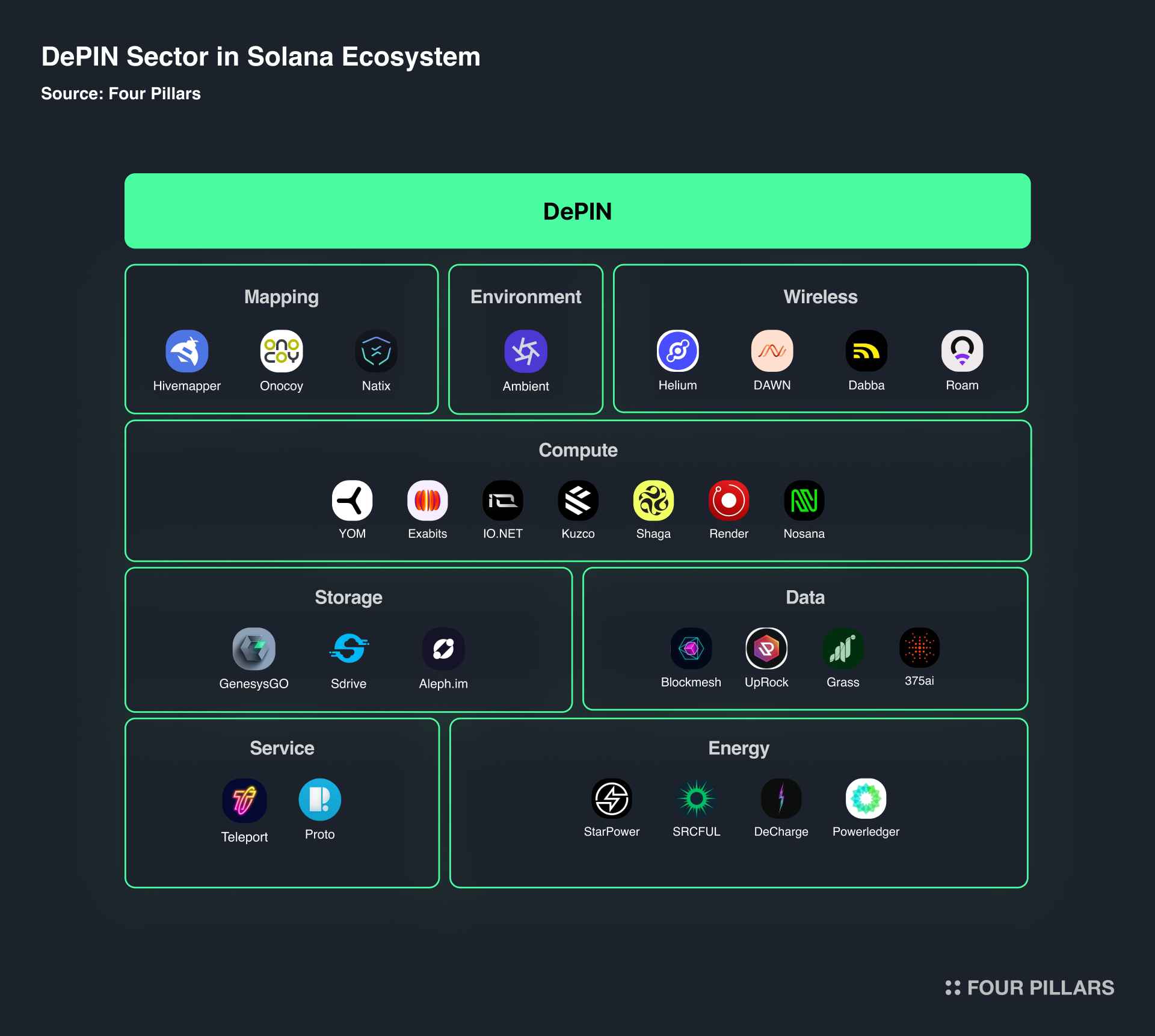
Decentralized Physical Infrastructure Networks (DePIN) utilize various incentivization mechanisms to crowdsource, operate, and maintain real-world physical infrastructure on blockchain networks.
The core of the DePIN business model lies in the ability to efficiently manage and utilize the data transmitted through the network's hardware or software infrastructure - for example, Helium facilitates network connectivity in a decentralized environment by transmitting data from IoT devices. IO.NET optimizes data processing for machine learning tasks using a GPU/CPU node network. Hivemapper collects and leverages geographic data via dashcams to provide mapping services - since DePIN is fundamentally data-centric, it requires a robust base layer with high transaction throughput, composability, and scalability.
Solana has become the platform of choice for major existing DePIN projects like Render Network, Hivemapper, and Helium, thanks to its ability to process thousands of transactions per second (TPS), low latency, cost efficiency, and rich ecosystem and developer community. Solana's DePIN sector continues to expand, with significant adoption already taking place - A prime example is Helium, which more than doubled its mobile subscriber base in 2024, reaching over 100,000 mobile subscribers as of July this year.
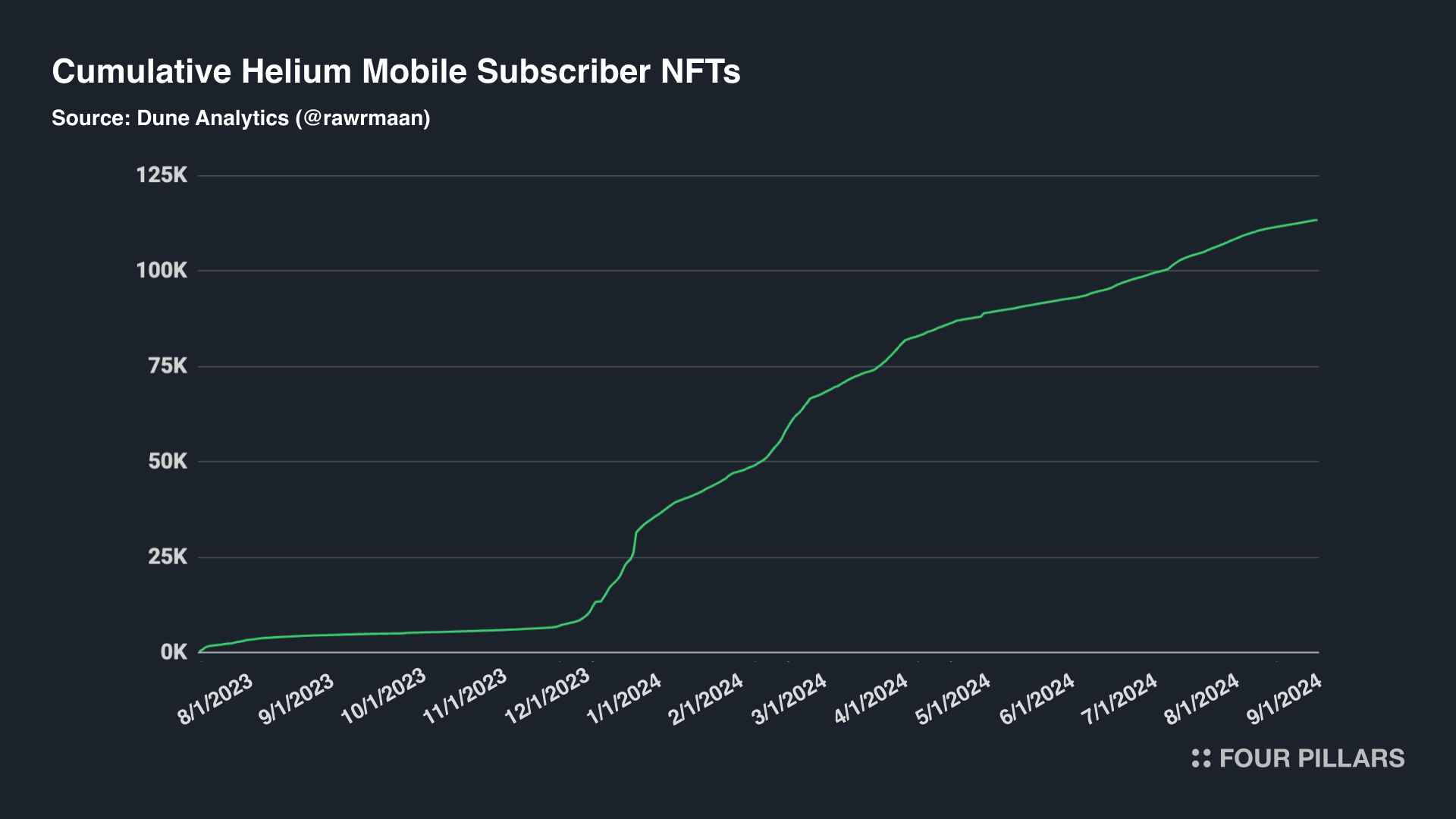
Following is a curated list of the significant developments and milestones achieved within the Solana's 'DePIN' sector - some projects that overlap between the AI sector and the DePIN sector will be assigned to the AI sector for explanation.
Hivemapper is a global mapping network that collects real-time, high-resolution road images using vehicle dashcams, rewarding contributors with its native $HONEY tokens. Hivemapper has had a busy Q2 and achieved several milestones, such as successfully mapping 25% of the global road network and approximately mapping 28 million kilometers of street-level imagery every month.
Hivemapper shipped 5,605 dashcams in Q2 and has plans to field test their next-generation dashcam ‘Bee’ soon.
NATIX Network is a DePIN protocol for geospatial data mapping designed to address issues of siloed data access and high business costs caused by big tech’s data monopoly. Natix achieves this by integrating proprietary AI, edge computing, and economic incentives to crowdsource cameras worldwide, creating a global Decentralized Dynamic Map (DDMap).
Ambient Network is a decentralized infrastructure network for environmental monitoring, designed to collect global environmental data to protect the health of our planet and its inhabitants. Ambient has developed a mobile app called AmbiGO that monitors data such as city air quality, noise levels, and cleanliness by rewarding users for contributing and mapping their ambient data.
Shaga, a two-time Global DePIN Hackathon winner, is developing a P2P cloud gaming platform. By connecting gaming PCs worldwide into an opened and decentralized network driven by gamers, Shaga wants to improve latency and reduce reliance on large corporations.
375ai is a DePIN building advanced decentralized wireless and edge infrastructure. 375ai launched its first product, 375edge, a sensor and edge AI node capable of collecting, processing, and transmitting multimodal data such as environmental and traffic data. Network participants can earn token rewards by deploying the 375edge and collecting and reporting high-quality data.
Teleport's Trip Protocol is a decentralized ride-sharing service built on the Solana network, designed to solve the centralization issues of existing ride-sharing companies. Through this protocol, drivers are guaranteed high earnings, and riders can enjoy the service at a lower cost.
DAWN(Decentralized Autonomous Wireless Networks) is a Solana DePIN protocol developed by Andrena. DAWN is a user-powered decentralized wireless network providing affordable home and business internet at multi-gigabit speed.
Helium is a 5G wireless network DePIN that migrated to Solana to leverage its performance and State Compression features, making it easier to identify devices and expand market potential. Users who utilize hotspots from Helium’s IoT devices pay network fees in HNT, which is then distributed to hotspot operators. Helium's network is available on various devices, and last year, Helium Mobile launched a $20 monthly phone plan offering unlimited data, talk, and text across the United States.
Additionally, Helium announced the Helium Licensing Program, which allows anyone to produce and sell Helium hotspot devices, enabling individuals to generate income through licensing fees while also helping to grow the Helium network.
ShdwDrive, developed by GensysGO, is a decentralized cloud storage platform on the Solana network. It uses a Directed Acyclic Graph (DAG) data structure to enable efficient decentralized data storage, management, and computation.
GenesysGO unveiled the first-ever decentralized storage network powered only by mobile devices at Solana Crossroads conference in Istanbul. Mobile shdwDrive will be integrated into Solana Mobile Chapter 2, where the integration will allow Solana Saga users to turn their devices into decentralized storage nodes and earn rewards in $SHDW, GenesysGO’s native token.
Starpower is a decentralized energy network (DEN) protocol on Solana that is building a distributed energy network by aggregating and harnessing the energy of various distributed energy devices (DERs) to form a unified and powerful distributed energy grid capable of meeting the rising energy demands of artificial intelligence. StarPower has released its first product, the StarPlug which will be used to build its global energy network.
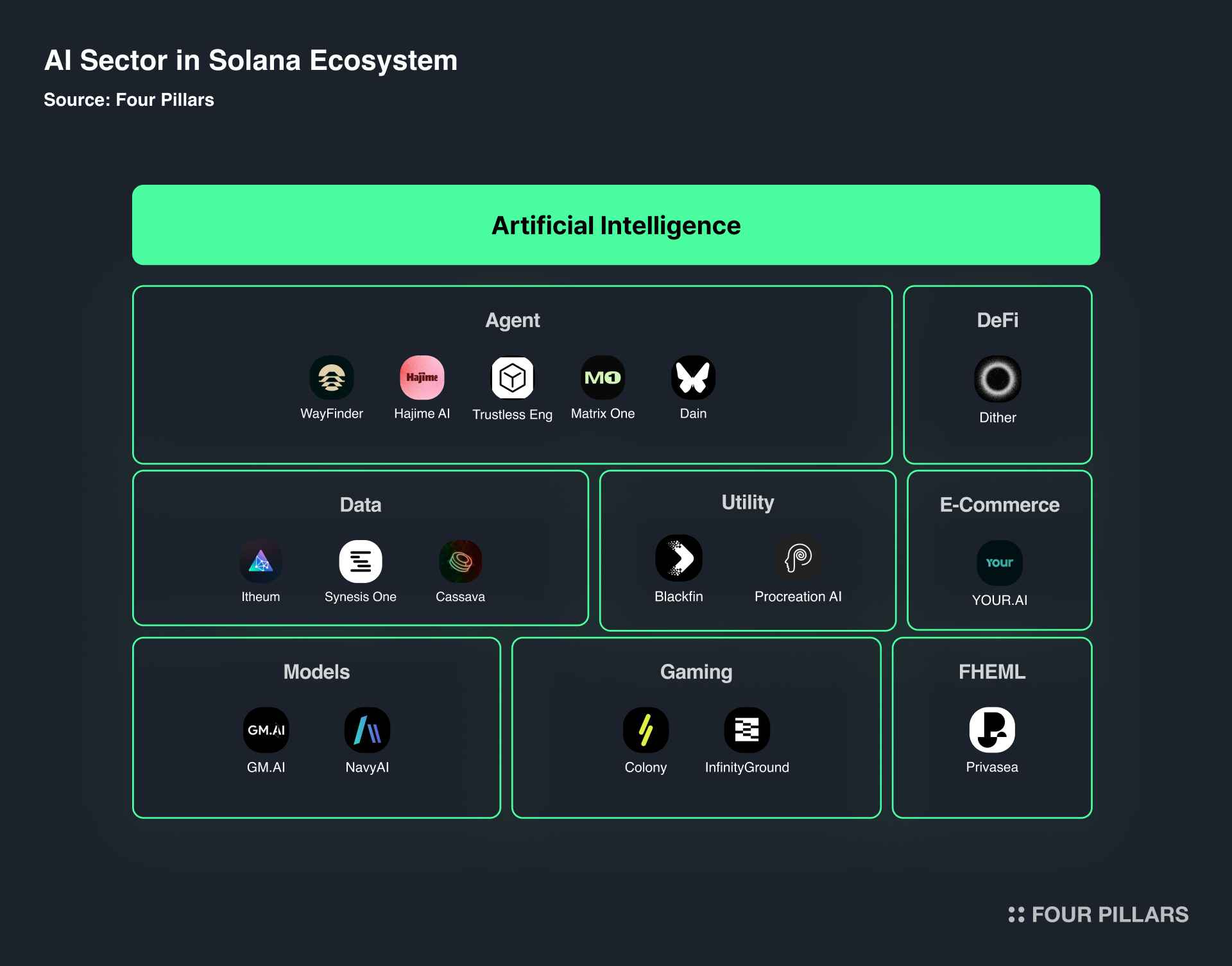
The rapid advancements in artificial intelligence (AI) over the past few years have significantly impacted various industries and fueled widespread public interest in generative AI applications like ChatGPT. However, much of the development, both at the infrastructure and model layers, has come to be dominated by closed-source Web2 companies. This centralization sparked a push towards developing open-source alternatives within the crypto industry, leading to a surge in new AI projects throughout last year.
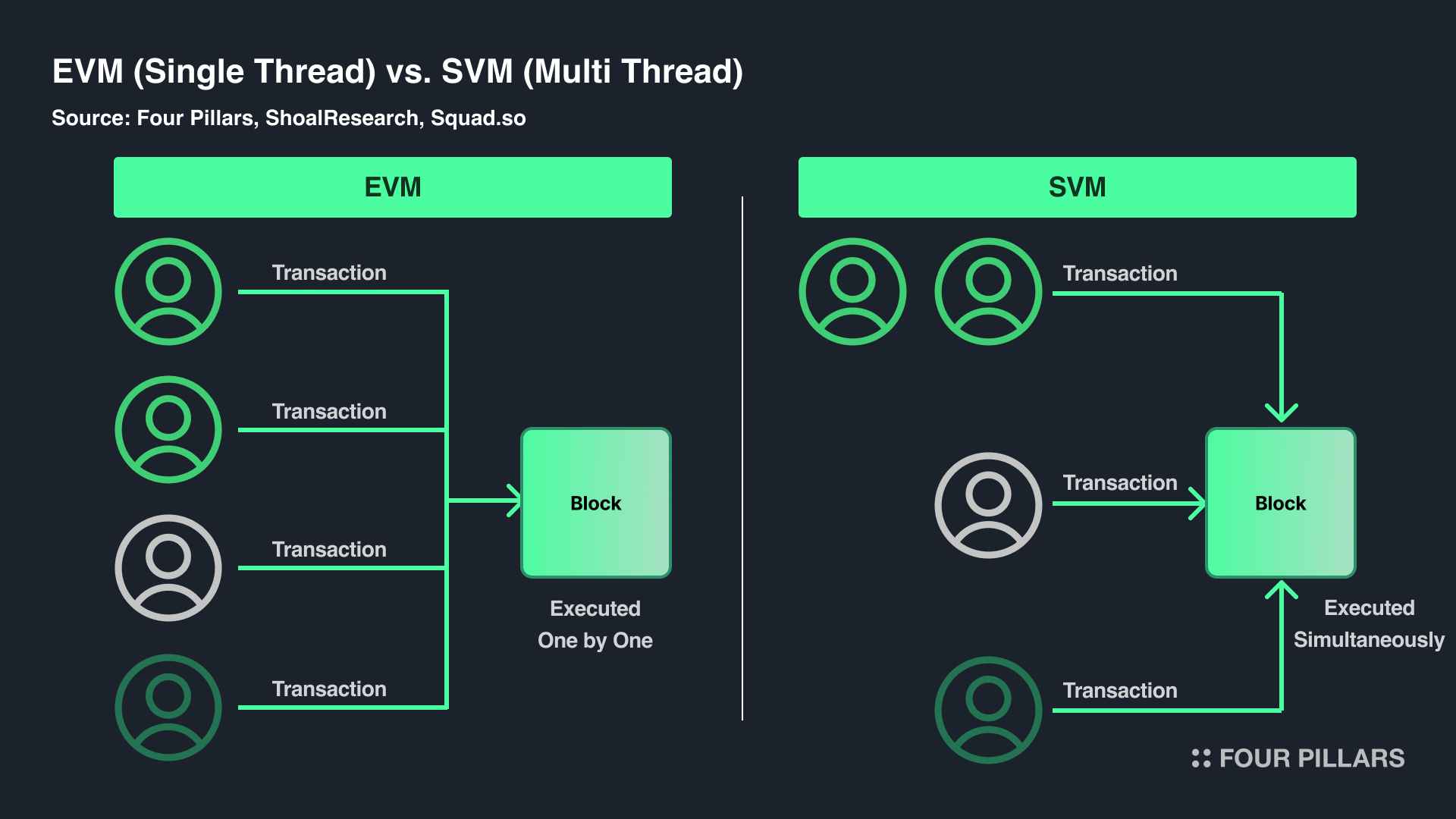
The rise in popularity of decentralized AI has greatly benefitted Solana, as many DePIN x AI projects have opted to launch on the network. This is largely due to Solana's technical stack, which offers distinct advantages over competing blockchains, such as the Sealevel runtime environment. Solana’s parallel execution capacity of smart contracts significantly improves the efficiency of transaction processing on the blockchain by allowing multiple non-conflicting transactions to be executed simultaneously, effectively optimizing computing hardware like GPUs and CPUs. This is greatly beneficial for projects performing heavy data and computational processes as Solana allows them to coordinate resource allocation and process transactions at scale, supporting faster and more efficient operations.
However, while Solana's AI sector is not yet as established as its DePIN counterpart, it is in a burgeoning stage with three particularly promising areas: decentralized computing networks, data, and AI agents.
Next is a summary of important developments in Solana’s 'AI' sector, and an introduction of projects worth monitoring for future developments.
DAIN Protocol is a decentralized artificial intelligence network of autonomous agents that can communicate, interact, learn, and collaborate. It intends to solve the problems associated with today’s fragmented internet by harnessing the collective intelligence of multi-agent systems and offering a unified platform for deploying and using AI agents with multi-modular capabilities. DAIN recently released their no-code DeFi AI agent, DainTrader for alpha users.
Matrix One strives to make it easy and accessible for anyone to create personal AI characters by providing the necessary interface and tools to create multi-modular AI agents that can be monetized and integrated virtually and in real-world settings. The protocol was created to improve on several flaws of existing AI character platforms such as high technical barriers, poor revenue distribution, lacking optionality, and ownership of one’s AI characters. Matrix One minimizes such issues by providing developers and creators a suite of infrastructural tools like a character studio, 3D avatar visualizer, model index, and marketplace making it easy to create, own, and trade tokenized AI characters.
WayFinder AI is a decentralized protocol of user-owned, autonomous AI agents that enables them to navigate and operate across on-chain applications and ecosystems. WayFinder powers Parallel Studios' new game, Colony, and the platform hosts AI agents capable of various features, such as creating smart contracts. These agents are highly user-customizable through their advanced memory function.
Grass is a DePIN that aims to democratize AI model training through a distributed network of incentivized nodes that share unused bandwidth to collect and process web data.
Grass has had many achievements this Q2. First, they successfully open-sourced user datasets containing 600 million Reddit posts and comments on HuggingFace, now publicly available for open-source AI training. Additionally, Grass desktop node is now available for higher efficiency, and Solana wallet addresses have been integrated with users' Grass accounts, ensuring that rewards are distributed to nodes when their data is used for AI inference or training tasks.
Data is the cornerstone of AI and requires labeling and annotation to improve the quality and accuracy of underlying models. However, in its current state, micro-tasking and providing raw data either pays very little or is farmed without the consent and knowledge of users by tech companies. Synesis One is a decentralized Train2Earn platform where anyone can train AI models and earn rewards. Users who own Kannon NFTs can participate in data crowdsourcing, data labeling, AI training, and other preprocessing tasks, receiving incentives as compensation.
As AI becomes an integral part of daily life, issues related to digital identity and privacy are rapidly emerging, driven by the increasing vulnerability of sensitive data such as financial information, medical records, and personal identity data to breaches and manipulation.
Privasea aims to encrypt and protect this sensitive data by utilizing various Fully Homomorphic Encryption (FHE) techniques. Notably, the Privasea team has developed a dApp called 'ImHuman,' which allows users to locally store and encrypt their biometric data as NFTs, enabling them to prove their humanity and protect themselves from malicious bots and programs.
Exabits, incubated by Harvard Innovation Labs, is developing the "AI-Compute Base Layer" for AI training, inference, and fine-tuning.
Kuzco is a decentralized GPU Cluster built on Solana, which provides scalable and cost-effective inference for large language models (LLMs). Kuzco is having growing network requests growth and new nodes entering the network, and it is currently being used for LLM inference work in the DecentAI developed by Catena.
Render Network, a GPU network that focuses on providing scalable and cost-effective 3D rendering solutions to artists and businesses, has continued to be successful through its application, OctaneX. Render-powered OctaneX is integrated into Apple's newest iPad Pro, featured in Apple's keynote, and created the opening sequence in the HBO drama The Last of Us. Users can either provide or utilize computing power for complex 3D rendering tasks, with Render tokens being used in the process. The Render Network employs a Burn Mint Equilibrium (BME) model to balance the supply and demand of tokens, ensuring consistent pricing for its services.
Similar to Render Network, IO.NET is a distributed GPU computing network based on Solana. Unlike Render Network, IO.NET focuses more on inference, parallel learning, hyper-parameter tuning, and reinforcement learning. The two projects partnered last November to expand the pie in the GPU Supplier market.
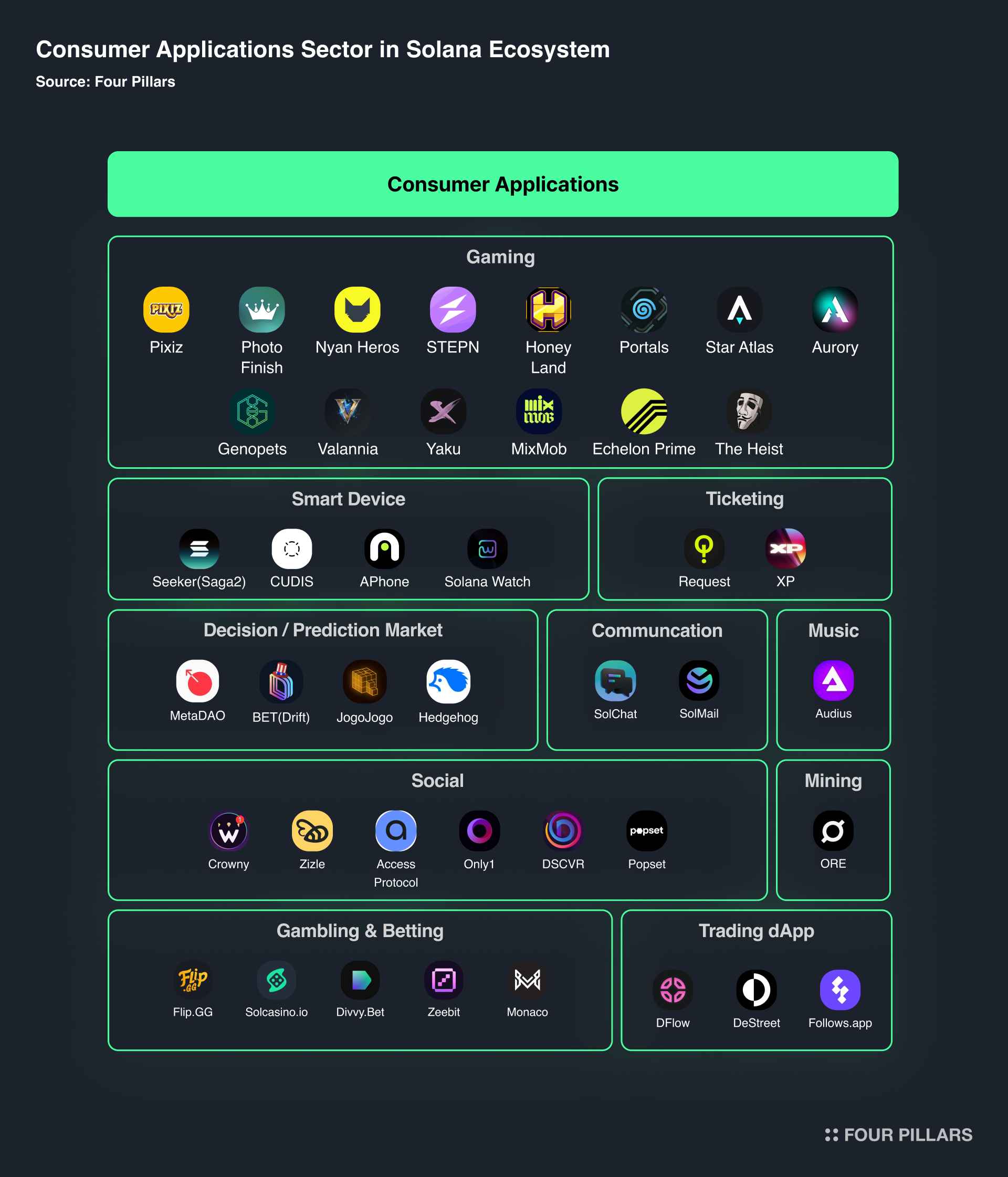
As explained in the earlier part of the article, after a series of bankruptcies and events in 2022 that led to a downturn in the crypto industry, many people became skeptical about the future of crypto. Amid this crisis, the industry's focus naturally shifted toward a more practical perspective on why blockchain should be used, and major mainnets also began discussing solutions for real-world adoption in response.
With the strong support of a robust community and a developer-friendly tech stack, Solana has once again emerged as the most suitable network for these discussions, designed with mass adoption in mind. As a result, the Solana network has shown strong growth not only in the previously mentioned sectors but also in consumer application sectors such as gaming and mobile trading apps.
Next is a brief list of 'Consumer Applications' that exemplify Solana’s user-centric approach.
Echelon Prime Foundation is the foundation behind Parallel TCG, a sci-fi trading card game, and Parallel Colony a strategic survival game that integrates AI avatars.
STEPN is a social lifestyle app on Solana that connects people globally, encouraging an active and healthy lifestyle through STEPN’s digital NFT Sneakers that allows users to earn rewards when doing various daily activities. At the recent Breakpoint, it was announced that, through a partnership with Adidas, minting for 1,000 Genesis Sneakers would take place at the end of September.
Solchat is a communication protocol based on Solana, allowing users to engage in text, voice, and video calls within the Web3 environment. All messages and group chats are stored on-chain, while voice and video calls are conducted P2P via WebRTC. Solchat is expected to be actively used in the upcoming Solana Saga mobile as well.
Audius is a decentralized music-sharing platform that bridges the gap between fans and artists, offering users access to exclusive new music while allowing artists and creators to maintain control over their work and receive fair compensation. Audius secured licensing agreements with all major U.S Performing Rights Organizations (PROs), including ASCAP, BMI, GMR, and SESAC.
MetaDAO Project is a decision market platform on Solana that leverages the concept of ‘futarchy’ to enhance governance mechanisms. MetaDAO allows users to participate in governance decisions by trading tokens that represent different potential outcomes.
CUDIS is an AI-powered wellness ring that helps users manage and keep track of their health by monitoring and providing insights on various health metrics such as sleep, steps taken, and daily activities. CUDIS supports users in achieving their health goals by providing personalized wellness advice via an integrated biometric dashboard, AI coach, and a point system that rewards them for completing various goals. CUDIS successfully sold out the first round of their ring, and now round 2 is live for purchase.
ORE is a proof-of-work (PoW) based digital currency within the Solana ecosystem, designed to ensure fair and accessible mining. After winning $50,000 in the Solana Foundation-sponsored hackathon "Solana Renaissance," ORE quickly became one of the fastest-growing applications on Solana. To address network congestion issues that arose from its rapid growth, the development team launched ORE V2, introducing a fixed supply of 21 million tokens and making continuous improvements to enhance the network’s performance and reinforce the token's value.
DeStreet is a social trading app that won 2nd place in the DAOs & Communities Track at the Solana Renaissance Hackathon and 1st place at Bonkathon. The dApp allows traders to create, discover, and share trades on social media by simply sharing links. Trade initiators receive 20% of the total profits, and users can subscribe to their favorite influencers to automatically follow their trades, adding elements of gamification and social prestige.
DFlow is a Solana-based non-custodial mobile trading platform focused on accelerating the adoption of on-chain trading from the application and infrastructure side via their mobile trading app and liquidity aggregator. The DFlow mobile app was recently launched and is now available for download on both iOS and Android.
Follows.App is a social trading platform on Solana that is innovating in the creator economy through creator-financialization (Creator-Fi). The app allows fans (users) to support and invest in their favorite influencers by buying and selling “Follows,” providing fans with unique experiences and creators with new monetization opportunities.
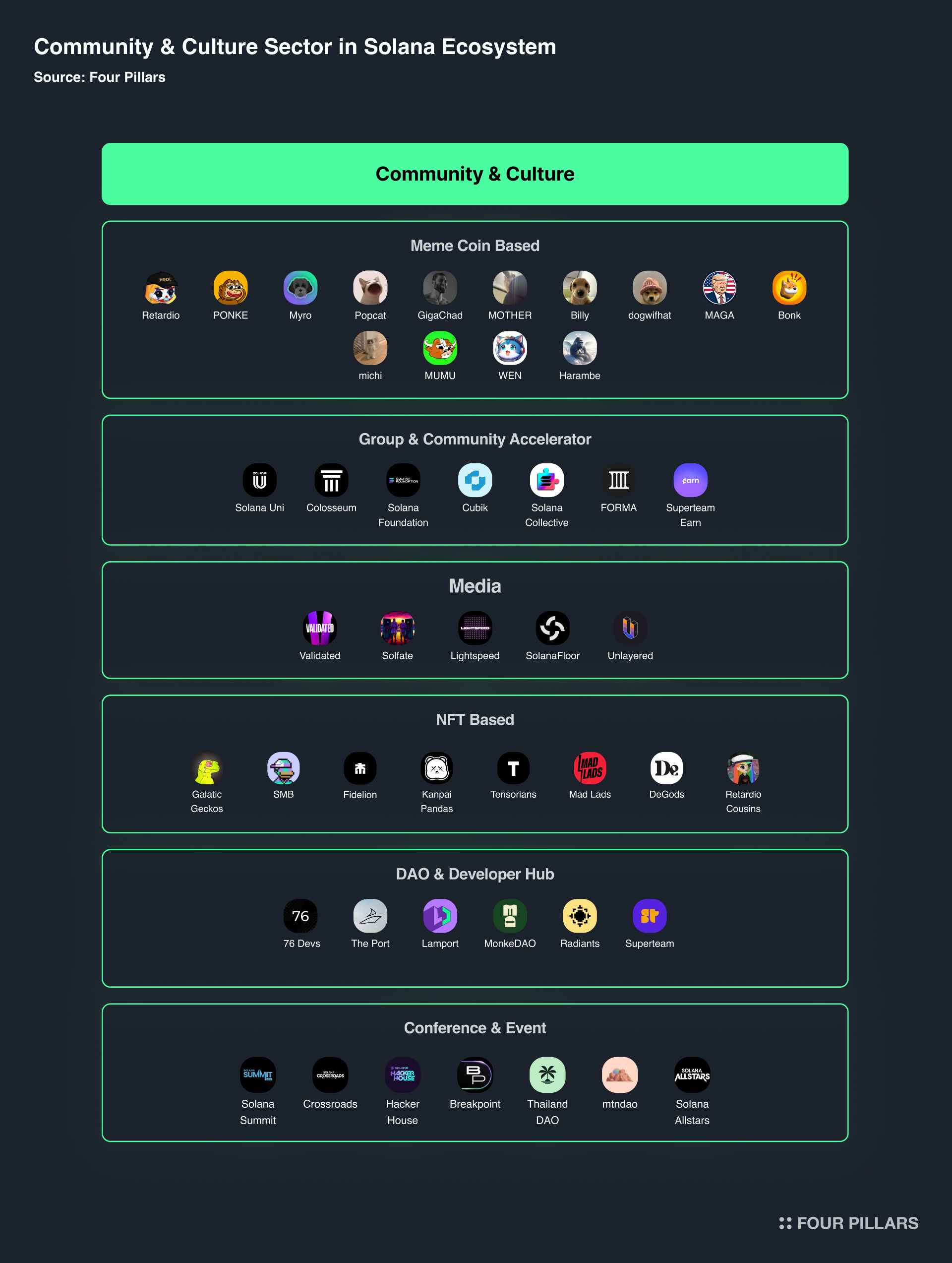
La Masia, FC Barcelona’s youth academy, is famous for fostering players such as Messi, Xavi, and Iniesta, who all became world-class players, not only benefiting themselves but the whole club through winning championships and generating millions in revenue through selling tickets and fan gear. Like football academies, blockchain communities are essential for fostering grassroots talent, establishing a common culture, and driving growth and success.
Similar to La Masia in Barcelona, Solana has built one of the most dynamic communities in the crypto industry. This community is made up of a diverse group of passionate Solana network maximalists, founders, developers, and investors. Through various initiatives like hackathons and grant programs, it plays a pivotal role in attracting and nurturing key players who continuously bring innovation and growth to the Solana ecosystem, creating a virtuous cycle.
Many of Solana's key ecosystem projects—such as Tensor, JITO, Mango, Tiplink, and Dialect—originated from Solana hackathons. These projects, driven by deep loyalty to Solana, have now grown to a scale where they attract new users, partnerships, and liquidity to the Solana network from outside. They also contribute to the recursive growth of the Solana ecosystem by sponsoring various hackathons. Additionally, Solana NFT and meme projects like Solana Monkey Business (SMB), Mad Lads, Bonk, and PONKE initially began as purely artistic or meme-driven expressions. However, they have steadily gathered people aligned with Solana’s philosophy, growing into larger communities that initiate various efforts to advance the ecosystem. For instance, MonkeDAO has hosted global meetups and co-managed grant programs with the Solana Foundation and Metaplex, while Bonk, in collaboration with Radiants and Phase Labs, organized the Bonkathon, offering a $300,000 prize to spur ecosystem innovation.
The following is an overview of a few projects and teams that are shaping Solana’s ‘Culture and Community’.
Bonk, a dog-themed meme coin symbolizing the resilience of the Solana ecosystem, was launched as a Christmas gift on December 25, 2022. As previously mentioned, Bonk has contributed to revitalizing the ecosystem through various initiatives, including hosting hackathons and launching projects like BonkBot and Bonkswap. Additionally, in a recent Breakpoint announcement, they revealed the upcoming launch of BONK ETP in the US.
dogwifcoin is a Shiba Inu dog-themed meme coin featuring the real-life puppy Achi wearing a pink beanie. It launched in November and quickly gained popularity and is currently the largest meme token on Solana by market capitalization.
MOTHER is a meme coin and community co-founded by famous rapper Iggy Azalea. Initially, it started purely out of curiosity about crypto. However, the unique characteristics of the meme coin community combined with Iggy’s active engagement created a synergy. Now, MOTHER aims to serve as a 'godmother' helping the public approach the crypto space in a more fun and familiar way. Through various initiatives, MOTHER has rapidly expanded its influence and has become one of the fastest-growing communities. This coming November, MOTHER plans to launch Motherland, a crypto casino where users can play slots, poker, and engage in sports betting.
Fidelion is an NFT project set in a dieselpunk, post-apocalyptic world in the year 2080. Through exceptional storytelling and branding, it is expanding its IP. The project has also launched a passive game utilizing NFTs and a mobile game called Mega Road.
MadLads collection was built on the xNFT standard and aims to explore the potential of NFTs as decentralized applications. The release of Mad Lads played a crucial role in injecting new energy into the Solana community, which was facing difficulties due to the collapse of FTX.
MonkeDAO is the first NFT DAO on Solana, evolving from a decentralized community that began around the Solana Monkey Business (an NFT collection) in 2021. This organization actively engages in various initiatives, including operating a Solana validator, running a staking pool (i.e., SOL), hosting online events, and investing in early-stage projects, all managed 100% by the community. Through these efforts, MonkeDAO has contributed significantly to the early success and sustainable growth of the Solana NFT market.
LamportDAO is a community-driven initiative focused on supporting developers within the Solana ecosystem. As of the time of writing, it has over 4,000 members and actively fosters the community by providing developer resources, supporting technical development, promoting Solana features, and organizing Solana-specific hackathons to help onboard new developers.
Superteam DAO is a global community of founders, developers, grantees, and other stakeholders collaborating to grow and incubate new innovative projects in the Solana ecosystem. Superteam is truly international and is fostering global talent through its 10+ different country branches including Brazil, Germany, India, Mexico, Nigeria, Turkey, Vietnam, U.K, U.A.E, the Philippines, Malaysia, Canada, and Japan.
Colosseum is a Solana Foundation accelerator platform that hosts competitive hackathons and provides key support for early-stage startups in the Solana ecosystem. Hackathon winners are accepted into the Colosseum program where they receive help with product launches, networking opportunities with top VCs, and a $250,000 grant.
Colosseum hosted the Solana Renaissance Hackathon which had over 8,300 participants from 95+ countries and 1,070 project submissions across sectors such as Infrastructure, Gaming, DePIN, DAOs, DeFi, and a long-tail of Consumer Applications.
Cubik is a decentralized, community-driven platform within the Solana ecosystem that supports and provides funding for open-source projects and digital public goods. One of Cubik's key features is its use of the Quadratic Funding (QF) model, which amplifies the impact of individual donations, ensuring that projects receiving more community support are proportionally granted larger funds from the matching pool.
Solana Foundation is a non-profit organization that provides grants, funding, and resources to developers, projects, and various initiatives to grow and foster the Solana ecosystem.
Solana University is an international student organization hosting various events and distributing educational materials to advance education about Solana and Web3.
Breakpoint is an annual event organized by the Solana Foundation that gathers industry experts, artists, developers, and community members. Spanning several days, the event offers a variety of engaging presentations and workshops. This year, Breakpoint took place in Singapore on September 20 and 21, and next year’s Breakpoint is planned to take place in Abu Dhabi in December.
Crossroads is an annual community conference hosted in Istanbul, Turkiye. Solana Crossroads was created to connect Solana’s global community members, providing networking opportunities, presentations and a chance to learn more about the latest developments in the Solana ecosystem. Crossroads was hosted this year with more than 3,000 in attendance and over 50 speakers.
mtndao is a hacker house for developers in the Solana ecosystem, held for about a month in Salt Lake City, Utah, USA. The event features a variety of activities such as hackathons, coding sessions, networking events, and even ski trips. Participants work on developing new projects and compete for prizes and rewards.
Solana Summit is the largest gathering of Solana founders, creators, and developers in the Asia Pacific region (APAC). It aims to build connections and strengthen the community among Solana enthusiasts. Recent Solana Summit was held between June 20 and June 22 this year in Malaysia, with an astounding turnout of 750+ attendees from 55 countries and 95+ speakers and workshop hosts.
Lightspeed is a podcast hosted by Mert Mumtaz, CEO of Helius, and Jack Kubinec, a reporter at Blockworks, that focuses on innovative projects using cryptocurrency to solve real-world problems. It features interviews with founders and developers working on platforms like Solana, discussing topics primarily related to technology and the state of the cryptocurrency market.
SolanaFloor, powered by Step Finance is the leading Solana news and media hub, covering the latest developments and news in the Solana ecosystem.
Validated is one of the best Solana-related podcasts hosted by Austin Federa from Solana Foundation, featuring in-depth discussions with various guests on topics like the future of the internet, blockchain, and Web3 technologies.

Many people, including Solana's Co-Founder Raj Gokal, describe Solana as ‘the Apple of the crypto world’, emphasizing the harmony between software and hardware and focusing on performance and UX. This analogy might make Solana's vision more relatable to us. However, ironically, what makes Solana even more exciting is not its similarities to Apple but its differences - the approaches of Solana and Apple are completely opposite.
Apple fundamentally sells hardware, making software essentially a means to sell hardware. Even during the launch of the iPod, which marked a significant milestone in Apple's remarkable journey, Apple adopted an approach that combined software, iTunes, to showcase its hardware experience. However, Solana takes an opposite approach, aiming to integrate hardware to encapsulate a web3 experience where numerous fully composable applications are organically interconnected. Thus, compared to Apple's approach, Solana's method is considered more sophisticated and ambitious, seeking innovation not just through convenient UX but by offering new experiences through the software itself.
In the end, technology is worthless if not used. Think simply. One of the primary values we seek from blockchain is for it to function as an innovative internet infrastructure that can complement real-world systems in such ways.
While Bitcoin and Ethereum have presented an ideal vision for the future of blockchain, Solana is contemplating how to realistically apply this process and actively pioneers the practical use case areas. Perhaps we have been overly consumed by the blockchain trilemma defined by Vitalik, limiting our imagination to where each blockchain stands within that spectrum. Ultimately, the protocol that creates the most significant value will be the one that best understands the needs of users and developers to ship those experiences.
I would like to extend special thanks you to Joe McCann, Richard_ISC, Yash Agarwal, Chaerin Kim and Ted Schoett for their significant contributions to the writing of this article’s ‘Notable Projects in the Expanding Solana Ecosystem’ section.
Dive into 'Narratives' that will be important in the next year